Employment and Social Development Canada (ESDC) 2022 Public Opinion Research on Accessibility
Final Report
Prepared for: Employment and Social Development Canada
Supplier name: Quorus Consulting Group Inc.
Contract #: G9292-227594/001/CY
Contract amount (incl. HST): $149,993.32
Contract award date: December 14, 2021
Delivery date: July 2022
POR number: 061-21
For more information, please contact:
ACCESSIBLE.CANADA.DIRECTORATE-DIRECTION.CANADA.ACCESSIBLE@hrsdc-rhdcc.gc.ca
Ce rapport est aussi disponible en français.
Copyright Page
Employment and Social Development Canada (ESDC) 2022 Public Opinion Research on Accessibility
Final Report
Prepared for Employment and Social Development Canada (ESDC) by Quorus Consulting Group Inc.
July 2022
This report presents the results of public opinion research conducted with persons with disabilities and persons without disabilities. The research involved a national survey with these two target audiences from March 2 to May 2, 2022. The study also involved ten online focus groups and 15 in-depth interviews with persons with disabilities completed between March 16 and April 14, 2022. Sessions included participants from across Canada and captured a mix of different types of disabilities.
Cette publication est aussi disponible en français sous le titre : Emploi et Développement social Canada (EDSC) 2022 Recherche sur l’opinion publique sur l’accessibilité
For information regarding reproduction rights: droitdauteur.copyright@HRSDC-RHDCC.gc.ca
Catalogue Number:
Em4-24/2022E-PDF
International Standard Book Number (ISBN):
978-0-660-44217-4
Related publications (registration number: POR 061-21)
Catalogue Number:
Em4-24/2022F-PDF (Final Report, French)
International Standard Book Number (ISBN): 978-0-660-44218-1
© His Majesty the King in Right of Canada, as represented by the Minister of ESDC, 2022

Political neutrality certification
I hereby certify as Senior Officer of Quorus Consulting Group Inc. that the deliverables fully comply with the Government of Canada political neutrality requirements outlined in the Policy on Communications and Federal Identity and the Directive on the Management of Communications - Appendix C.
Specifically, the deliverables do not include information on electoral voting intentions, political party preferences, standings with the electorate or ratings of the performance of a political party or its leaders.
Signed:

June 2022 Rick Nadeau, President Quorus Consulting Group Inc.
Table of contents
Table of figures
- Figure 1: Incidence of persons with disabilities
- Figure 2: Regional quotas for persons without disabilities interviews
- Figure 3: Weighting framework
- Figure 4: Comparing survey sample with population distribution
- Figure 5: Dialing disposition report for all surveys completed by telephone
- Figure 6: Persons with disabilities – awareness of the Accessible Canada Act
- Figure 7: Persons without disabilities – awareness of the Accessible Canada Act
- Figure 8: Persons with disabilities – recall of details about the Accessible Canada Act
- Figure 9: Persons without disabilities – recall of details about the Accessible Canada Act
- Figure 10: Persons without disabilities – access to the internet at home
- Figure 11: Persons without disabilities – reasoning for lack of internet access at home
- Figure 12: How often someone without a disability saw or heard of someone with a disability encountering specific ICT-related barriers
- Figure 13: Persons without disabilities – preferred mode for accessing services or programs from federal sector organizations
- Figure 14: How often someone without a disability saw or heard of someone with a disability needing federal sector printed communications in an accessible format
- Figure 15: Types of accessible formats needed by persons with disabilities as seen or heard by persons without a disability
- Figure 16: Persons with disabilities – pain (unadjusted incidence): have this type of disability
- Figure 17: Persons with disabilities – pain: frequency of environment limiting inclusion in society
- Figure 18: Persons with disabilities – pain: difficulty with disability
- Figure 19: Persons with disabilities – pain (adjusted incidence): have this type of disability
- Figure 20: Persons with disabilities – mobility (unadjusted incidence): have this type of disability
- Figure 21: Persons with disabilities – mobility: frequency of environment limiting inclusion in society
- Figure 22: Persons with disabilities – mobility: difficulty with disability
- Figure 23: Persons with disabilities – mobility (adjusted incidence): have this type of disability
- Figure 24: Persons with disabilities – flexibility (unadjusted incidence): have this type of disability
- Figure 25: Persons with disabilities – flexibility: frequency of environment limiting inclusion in society
- Figure 26: Persons with disabilities – flexibility: difficulty with disability
- Figure 27: Persons with disabilities – flexibility (adjusted incidence): have this type of disability
- Figure 28: Persons with disabilities – mental health-related (unadjusted incidence): have this type of disability
- Figure 29: Persons with disabilities – mental health-related: frequency of environment limiting inclusion in society
- Figure 30: Persons with disabilities – mental health-related: difficulty with disability
- Figure 31: Persons with disabilities – mental health-related (adjusted incidence): have this type of disability
- Figure 32: Persons with disabilities – seeing (unadjusted incidence): have this type of disability
- Figure 33: Persons with disabilities – seeing: frequency of environment limiting inclusion in society
- Figure 34: Persons with disabilities – seeing: difficulty with disability
- Figure 35: Persons with disabilities – seeing (adjusted incidence): have this type of disability
- Figure 36: Persons with disabilities – dexterity (unadjusted incidence): have this type of disability
- Figure 37: Persons with disabilities – dexterity: frequency of environment limiting inclusion in society
- Figure 38: Persons with disabilities – dexterity: difficulty with disability
- Figure 39: Persons with disabilities – dexterity (adjusted incidence): have this type of disability
- Figure 40: Persons with disabilities – memory (unadjusted incidence): have this type of disability
- Figure 41: Persons with disabilities – memory: frequency of environment limiting inclusion in society
- Figure 42: Persons with disabilities – memory: difficulty with disability
- Figure 43: Persons with disabilities – memory (adjusted incidence): have this type of disability
- Figure 44: Persons with disabilities – hearing (unadjusted incidence): have this type of disability
- Figure 45: Persons with disabilities – hearing: frequency of environment limiting inclusion in society
- Figure 46: Persons with disabilities – hearing: difficulty with disability
- Figure 47: Persons with disabilities – hearing (adjusted incidence): have this type of disability
- Figure 48: Persons with disabilities – learning (unadjusted incidence): have this type of disability
- Figure 49: Persons with disabilities – learning: frequency of environment limiting inclusion in society
- Figure 50: Persons with disabilities – learning: difficulty with disability
- Figure 51: Persons with disabilities – learning (adjusted incidence): have this type of disability
- Figure 52: Persons with disabilities – communication (adjusted incidence): have this type of disability
- Figure 53: Persons with disabilities – communication: frequency of environment limiting inclusion in society
- Figure 54: Persons with disabilities – communication (adjusted incidence): have this type of disability
- Figure 55: Persons with disabilities – speech (unadjusted incidence): have this type of disability
- Figure 56: Persons with disabilities – speech: frequency of environment limiting inclusion in society
- Figure 57: Persons with disabilities – speech (adjusted incidence): have this type of disability
- Figure 58: Persons with disabilities – developmental (unadjusted incidence): have this type of disability
- Figure 59: Persons with disabilities – developmental: frequency of environment limiting inclusion in society
- Figure 60: Persons with disabilities – language (unadjusted incidence): have this type of disability
- Figure 61: Persons with disabilities – language: frequency of environment limiting inclusion in society
- Figure 62: Persons with disabilities – language (adjusted incidence): have this type of disability
- Figure 63: Persons with disabilities – other disability (unadjusted incidence): have this type of disability
- Figure 64: Persons with disabilities – other disability: frequency of environment limiting inclusion in society
- Figure 65: Persons with disabilities – other disability (adjusted incidence): have this type of disability
- Figure 66: Persons with disabilities – access to the internet at home
- Figure 67: Persons with disabilities – reasoning for lack of internet access at home
- Figure 68: Persons with disabilities – barriers to information and communication technology
- Figure 69: Persons with disabilities – preferred mode for accessing services or programs from federal sector organizations
- Figure 70: Persons with disabilities – need for accommodations when accessing federal government programs or services
- Figure 71: Persons with disabilities – additional needs for accommodations when accessing federal government programs or services
- Figure 72: Persons with disabilities – need for federal sector printed communications to be available in accessible formats
- Figure 73: Persons with disabilities – need for various types of accessible formats
- Figure 74: Persons with disabilities – barriers encountered related to the built environment
- Figure 75: Respondent profile
Executive summary
Study background
In 2022, the Accessible Canada Directorate within Employment and Social Development Canada (ESDC) commissioned a follow-up to the 2019 study measuring Canadians’ awareness and experiences with accessibility and disability issues. This research will be used to measure and track outcomes of the Accessible Canada Act and help shape future accessibility policies.
The scope of the study involved two key population segments: persons with disabilities and persons without disabilities. A series of questions was developed by Quorus and ESDC to identify persons with disabilities. Wording for some of these questions was borrowed from existing survey instruments and was customized for the purposes of this particular study.
The study was comprised of a survey of both population segments and a series of focus groups and in-depth interviews with persons with disabilities. Readers are reminded that survey results for persons with disabilities are derived from a non-probability sampling approach and as such cannot be used to draw inferences to the entire population. This data is representative of only those who participated in the survey.
Methodology for the national survey
Persons without disabilities
A total of 1,205 telephone interviews with individuals 18 years of age and older.
Respondents could complete the survey in either English or French.
The sample consisted of traditional wireline telephone numbers and a sub-quota of cell-phone only households.
The margin of error of this sample size is +/- 2.8%, 19 times out of 20.
Data was weighted by region, gender, and age to ensure that the final distributions within the final sample mirror those of the Canadian population without a disability according to the latest Census data (2016).
Persons with disabilities
A total of 872 surveys were completed with individuals with a disability, at least 18 years of age, of which 503 were completed by telephone and 369 were completed online.
Nearly all surveys completed over the telephone (500) consisted of landline telephone numbers and a sub-quota of cell-phone only households. The remaining telephone interviews (3) were completed with individuals who dialed into the toll-free number to schedule an interview.
All surveys completed online (369) were completed by individuals contacted through departmental stakeholder networks.
These respondents could complete the survey using a variety of formats in English or in French: telephone (the study website offered a toll-free number which participants could call and arrange for an interviewer to call back and collect their answers), online, downloadable accessible PDF and MSWord versions, Braille (available upon request), digital Braille (available upon request), VRS (available upon request), ASL/LSQ (available upon request), and hardcopy versions. As noted earlier, all surveys were completed either via telephone or online.
With the exception of 3 respondents who dialed into the toll-free number to schedule a phone interview, no respondents requested the use of alternative formats.
Given the non-probability nature of the sampling, a margin of error cannot be calculated. As well, data for this segment were not weighted.
Study parameters common to both segments included the following:
Data collection occurred between March 2 and May 2, 2022, and included a pretest of all data collection modes and formats.
All survey respondents were informed that the study was being conducted by ESDC/the Government of Canada.
Survey respondents did not receive any incentive for completing the survey.
The survey took respondents, on average, 15 minutes to complete.
Overview of results from the national survey
Persons without disabilities
One in five (21%) have seen, read, or heard about the Accessible Canada Act. When asked to explain, unprompted, what they remember about this act, 18% of those who could recall the Act explained it will generally support or assist persons with disabilities. Other common responses included 10% who explained it will increase accessibility, a similar proportion (9%) explained it will make buildings accessible and 9% indicated it will make government services accessible.
When asked how they like to access the services or programs from federal sector organizations, a majority (53%) preferred online, followed by in person (21%) and by telephone (13%).
One in five respondents (21%) “always” or “often” saw or heard of someone with a disability needing federal sector organizations, including the Government of Canada, to make materials available in accessible formats. Another 22% saw or heard this “sometimes.” The most common types of accessible formats these respondents saw or heard someone with a disability needing were large print (39%), plain language (33%), text to speech compatible (26%), audio versions (26%) and closed captioning (25%).
Nearly all respondents indicated they have access to the Internet at home (97%). Among the few who do not, the main reasons were a lack of need or interest (51%) followed by cost (21%).
Over the past two years, the incidence of respondents who had seen or heard of someone with a disability experiencing the following technology barriers because of an accessibility issue either “always” or “often” were:
using a website (10%),
using self-service technology in a public place (8%),
using a cellphone or accessing a wireless service (7%),
watching a video on the internet, for example on YouTube, Facebook, other social media or websites (7%),
watching a show on a streaming service such as Netflix, AppleTV, Crave, Amazon Prime, or a similar service (6%),
watching cable TV (4%).
Persons with disabilities
While all respondents in this segment qualified as individuals with a disability according to the series of screening questions developed for this study, 65% identified as a person with a disability.
Respondents were asked if they had any of the following types of disabilities:
Respondents having indicated having a specific disability were then asked how often they believe the world around them - for example physical spaces, technology, or people’s attitudes towards them - limits their inclusion in society because of this disability.
Results revealed that the most common disabilities related to pain (53%), mobility (50%) and flexibility (45%), followed by mental health-related (36%), seeing (33%), and dexterity (31%). All other disabilities had an overall incidence below 30%. Among those indicating having each disability, the ones most likely to feel that the world around them “always” or “often” limits their inclusion in society because of this disability are those with developmental / intellectual disabilities (63% feel this way among the 12% who have this disability), a learning disability (48%), and a language disability (47%).
Figure 1: Incidence of persons with disabilities
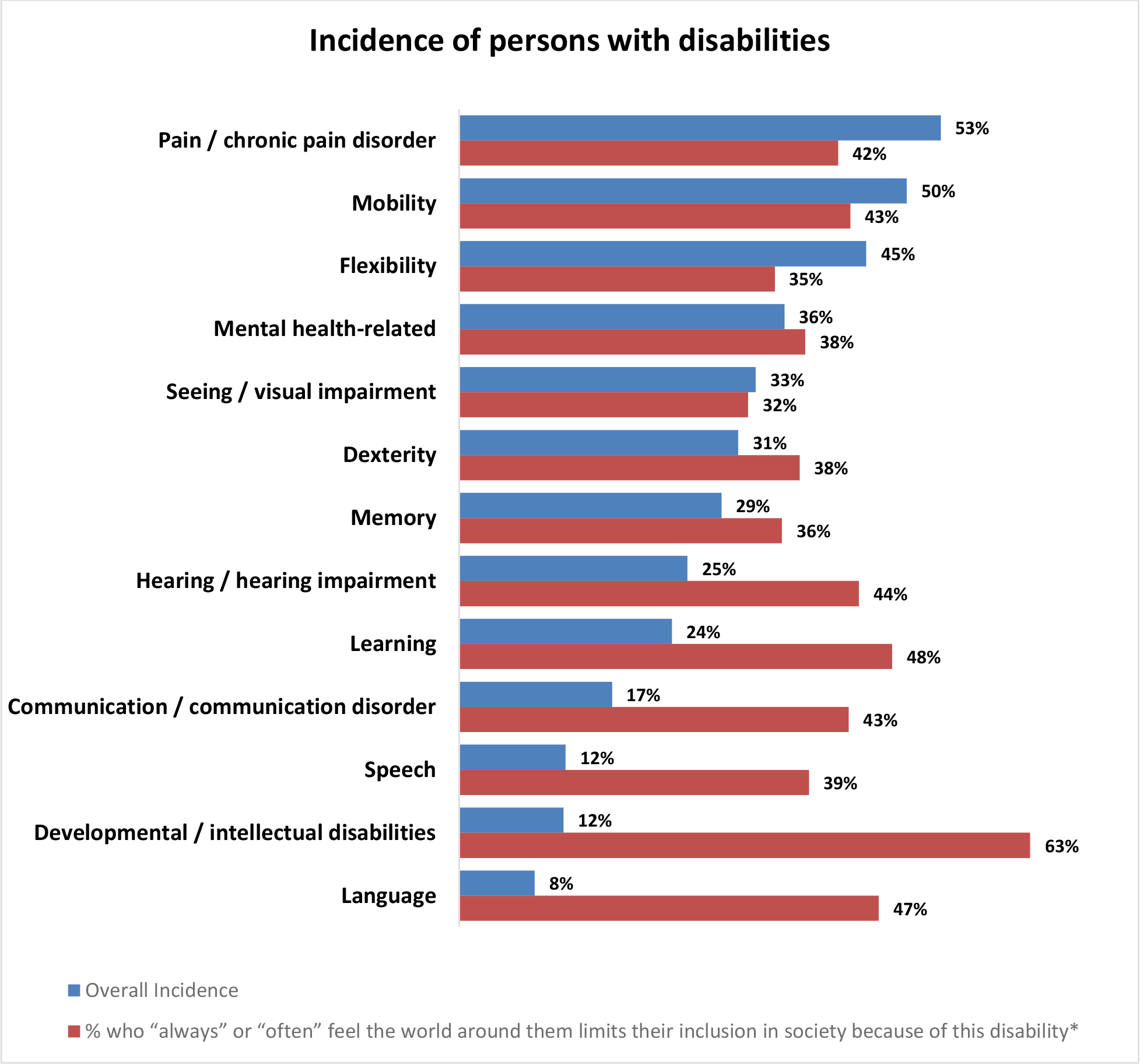
A horizontal bar graph titled, Incidence of persons with disabilities
The values are as follows. Pain forward slash chronic pain disorder. Overall Incidence, 53 percent. Percent who double quote always double quote or double quote often double quote feel the world around them limits their inclusion in society because of this disability, 42 percent. Mobility. Overall Incidence, 50 percent. Percent who double quote always double quote or double quote often double quote feel the world around them limits their inclusion in society because of this disability, 43 percent. Flexibility. Overall Incidence, 45 percent. Percent who double quote always double quote or double quote often double quote feel the world around them limits their inclusion in society because of this disability, 35 percent. Mental health-related. Overall Incidence, 36 percent. Percent who double quote always double quote or double quote often double quote feel the world around them limits their inclusion in society because of this disability, 38 percent. Seeing forward slash visual impairment. Overall Incidence, 33 percent. Percent who double quote always double quote or double quote often double quote feel the world around them limits their inclusion in society because of this disability, 32 percent. Dexterity. Overall Incidence, 31 percent. Percent who double quote always double quote or double quote often double quote feel the world around them limits their inclusion in society because of this disability, 38 percent. Memory. Overall Incidence, 29 percent. Percent who double quote always double quote or double quote often double quote feel the world around them limits their inclusion in society because of this disability, 36 percent. Hearing forward slash hearing impairment. Overall Incidence, 25 percent. Percent who double quote always double quote or double quote often double quote feel the world around them limits their inclusion in society because of this disability, 44 percent. Learning. Overall Incidence, 24 percent. Percent who double quote always double quote or double quote often double quote feel the world around them limits their inclusion in society because of this disability, 48 percent. Communication forward slash communication disorder. Overall Incidence, 17 percent. Percent who double quote always double quote or double quote often double quote feel the world around them limits their inclusion in society because of this disability, 43 percent. Speech. Overall Incidence, 12 percent. Percent who double quote always double quote or double quote often double quote feel the world around them limits their inclusion in society because of this disability, 39 percent. Developmental forward slash intellectual disabilities. Overall Incidence, 12 percent. Percent who double quote always double quote or double quote often double quote feel the world around them limits their inclusion in society because of this disability, 63 percent. Language Overall Incidence, 8 percent. Percent who double quote always double quote or double quote often double quote feel the world around them limits their inclusion in society because of this disability, 47 percent.
*Base: respondents who indicated having the given disability
Roughly one-third of respondents (34%) have seen, read, or heard about the Accessible Canada Act. When asked to explain, unprompted, what they remember about this act, 15% of those who could recall the Act explained it will generally support or assist persons with disabilities and 13% explained it will increase accessibility.
When asked how they like to access services or programs from federal sector organizations, the plurality (42%) preferred online, followed by in person (24%) and by telephone (19%).
Over the past two years, just over one in ten respondents (13%) “always” or “often” needed certain kinds of accommodations when accessing the services or programs from federal sector organizations. Another 12% needed them “sometimes.” The most common types of accommodations, across all respondents, were an accessible website1 (27%), more time to complete a form or an application (26%), documents in plain language (21%) and the use of an assistive device (21%).
Just over one in ten respondents (12%) always or often need federal sector organizations, including the Government of Canada, to make materials available in accessible formats. Another 18% need them “sometimes.” The most common types of accessible formats needed were plain language (48%), large print (37%), audio version (18%), e-books (18%), text to speech compatible (15%), and closed captioning (15%).2
In terms of the built environment, over the past two years respondents “always” or “often” experienced barriers that limited their ability to move in and around at following types of places:
public spaces, such as sidewalks and parks (20%),
small and independent local stores or shops (20%),
friends or other people’s houses they visited (18%),
large retail stores and chain stores (17%),
shopping centres (17%),
medical offices including walk-in clinics, hospitals, etc. (17%),
restaurants (17%),
public buildings, such as libraries, community buildings, city hall, etc. (13%),
movie theatres (13%),
government buildings, such as Service Canada centres, etc. (12%),
place of work (8%).
Nearly all respondents indicated they have access to the Internet at home (93%). Among the few who do not, the main reasons are a lack of need or interest (42%) followed by cost (22%).
Over the past two years, the incidence of respondents having experienced the following technology barriers because of an accessibility issue either “always” or “often” are:
using a website (16%),
using self-service technology in a public place (16%),
using a cellphone or accessing a wireless service (13%),
watching a video on the internet, for example on YouTube, Facebook, other social media or websites (13%),
watching a show on a streaming service such as Netflix, AppleTV, Crave, Amazon Prime, or a similar service (10%),
watching cable TV (10%).
Methodology for the focus groups and depth interviews
Sessions were completed between March 16 and April 14, 2022
In an attempt to limit the impact of participants not showing for their session, which can happen for any variety of reasons and is customary for focus group research, Quorus recruited six participants per group so that approximately five to six would ultimately show. In the end, 64 persons with disabilities participated in this phase: 15 through in-depth interviews and 49 through ten online focus groups. There was no participant overlap between the in-depth interviews and the online focus groups.
The same research material was used for the focus groups and the in-depth interviews. Focus groups each lasted 90 minutes and depth interviews lasted 45 to 60 minutes each.
All participants were given an $80 honorarium.
Sessions included participants from across Canada and captured a mix of different types of disabilities. Some sessions were with individuals with mild disabilities and others with moderate to severe disabilities.
Given the nature of the target audiences for this study and the research subject matter, a variety of recruitment approaches were used. Participants invited to participate in this study were randomly recruited by telephone from the general public, invited via a proprietary opt-in database, invited via the quantitative research component of this study, and, similar to the outreach used for the quantitative study, individuals were reached through stakeholder organizations.
All survey respondents were informed that the study was being conducted by ESDC/the Government of Canada.
Overview of results from the focus groups and depth interviews
General discussion regarding accessibility
Participants were asked to explain in their own words what comes to mind when they think of “disability”, that something is “accessible” and when they consider that they encounter “a barrier to accessibility.”
Participants generally viewed a “disability” as something that limits their ability to do something the same way as someone who does not have the same disability. Many stressed that this can just as much be something physical (and typically visible) as it could be something invisible (e.g., mental health).
They generally considered something to be “accessible” if “everyone” can do it, irrespective of their disability or lack thereof.
Finally, a “barrier to accessibility” was broadly seen as something that is getting in the way of a person trying to do something. The barrier might make it more difficult to do something or it might completely impede the ability to do something.
When generally asked what they believe could be done to reduce accessibility barriers in Canada, some of the solutions that participants proposed included:
Consult, test and do research with PWDs
Involve PWDs in the decision-making or design process
Adopt universal design principles
Create and/or engage committees in the community that can be consulted regarding accessibility considerations
Require product and built environment designers to spend a day “in the shoes of” someone with a disability – they need to experience the world the way PWDs do. For instance, it was suggested that designers should spend a day in a wheelchair.
A focus on information and communication technologies
Very few participants with mild disabilities encounter barriers when accessing online content or using online features. They are more likely to be encountered by those with moderate to severe disabilities, especially those with visual and/or hand or arm-related physical disabilities. For these individuals, the main issues typically pertain to websites that are not adapted for screen readers, websites that are not designed for easy navigation and/or require many clicks to navigate. Some avoid websites with streaming content because they do not all provide sub-titles or closed captioning.
Participants suggest involving PWDs more often at the testing stage when websites are being designed.
Very few believe they encounter barriers using specific types of devices. Some with physical impairments avoid or limit their use of portable devices and will resort to stands or similar devices to prop up their device instead of holding it.
Over the past two years, participants could not think of many government websites on which they encountered a barrier. The most common feedback typically pertained to the Canada Revenue Agency website, which was seen as dense and generally difficult to navigate because of the amount of content and the technical language used. A few participants had struggled with the ease of use of vaccine-booking websites.
Very few participants used any assistive devices to help them communicate, work, or access the Internet at home or at work. For many who did use these devices, the technology was either built into the device they were using and as such was generally seen as “affordable”, or the costs were covered by their insurance. A few did explain that the devices they required were quite expensive.
A focus on communication other than ICT
Accessibility barriers were very rarely encountered when participants communicated with friends, family or local businesses and organizations, irrespective of how that communication was happening. Those who required more support relied on a companion to help them and this typically met their needs.
Communicating with Government of Canada staff is rarely done and when it occurs, the only main challenge is the wait time when dialing into a call center. Otherwise, participants did not recall having any difficulty accessing programs or services because a given federal government agency or department did not offer adequate accessible formats or accessible forms of communication.
There was some awareness of the term “plain language materials” although very few knew that they could obtain plain language materials from the federal government. That said, some felt that all government materials should be provided in plain language by default since many felt that current materials from the federal government are not always easily understood. At a minimum, the availability of plain language versions should be better advertised.
Finally, when it comes to communicating emergencies to all Canadians, for the most part participants were only aware of the alerts they receive on their mobile devices, when listening to the radio or when they are watching television. This approach was widely appreciated and considered adequate and effective. Of the few who had concerns with this approach, we heard:
Concern for Canadians who do not have a mobile device
Not being able to retrieve an alert – they might have heard the alarm but when they wanted to find out more, the alert was gone, and they could not find out more about it
A few felt the alarm was too loud and was anxiety-inducing
A focus on the built environment
When considering some of the stores they might visit or some of the products they tend to buy regularly, participants feel they encounter many barriers, many of which are related to physical disabilities. Given the variety of persons with disabilities in the sessions, these findings might suggest that retail environments are generally more likely to present barriers to individuals with physical disabilities, or those with physical disabilities are more inclined to voice the barriers they encounter.
The most common barriers encountered included the following:
Curbs that are too high for wheelchairs, mobility scooters and/or individuals with a physical impairment that limits their ability to go up steps.
Store entrances, including the lack of or broken handicap door openers, and doors to stores or malls that require one or more step to enter (i.e., no entrance ramp or threshold ramp). A few also felt that some store entrances are too narrow or built on angles that make it either difficult or impossible to enter with a mobility scooter or a wheelchair.
Lack of parking spots reserved for persons with disabilities. Some also expressed frustration with the limitations or eligibility requirements to obtain an accessible parking permit.
Narrow aisles in stores that limit their use of their wheelchair or mobility scooter.
Lack of seating in malls and stores.
Lack of motorized shopping carts.
Walkways, sidewalks and entrances not properly cleared of snow.
Shelving that is too high and a general lack of staff to help reach for items that are too high and/or too heavy.
Shopping environments that have too many stimuli such as bright/flashing lights, loud music, flashing display screens, loud public announcements, etc.
Participants living in rural or remote areas felt that many of these barriers were more common in their region compared to larger cities.
A focus on the built environment and procurement of goods, services, and facilities
Generally, beyond the barriers that participants outlined when they go shopping or go to other types of buildings in their area, they did not have much to add regarding how well the spaces and equipment of businesses and organizations meet the needs of persons with different types of disabilities.
Participants did have more to say regarding their current or previous workplace and how well they ensured workspaces and products are designed to be barrier free. Performance varied a great deal on this front – some felt that their workplace was very proactive in terms of making sure that workspaces were barrier free. To achieve this, they constantly ask staff how well their workspace is performing and if there is anything that should change. Similarly, some workplaces are quite accommodating when employees request special equipment or indicate a particular need. Although not perfect, many of the workplaces that seemed to exercise the best accessibility practices were government workplaces.
On the other hand, many participants also explained that despite their organization’s best intentions “on paper”, it can be very difficult, and sometimes impossible, to obtain certain accommodations, especially if they are expensive.
Many participants with moderate to severe disabilities explained that they have encountered employers who discriminate against persons with disabilities. This discrimination will occur either at the hiring stage, or if the disability surfaces or evolves while employed, the employer will create an environment that eventually sees persons with disabilities quit. A few explained how they did not reveal their disability to their employer out of concern that they might not be treated the same way, such as face certain forms of discrimination, including not being provided certain accommodations.
Very few were aware if there is or was any policy in place that included information about purchasing goods, services and facilities that are accessible for persons with disabilities. None had directly participated in their employer’s procurement process beyond providing their feedback when specifically asked about their own workspace.
Research purpose and objectives
The Accessible Canada Act (ACA) came into force on July 11, 2019. The Act was promulgated with the express purpose of benefiting all persons in Canada, particularly those with disabilities, through the identification, removal, and prevention of barriers to accessibility. ESDC wanted to gather data on Canadians’ opinions on, experience with, and awareness of accessibility and disability issues. This research will be used to measure and track outcomes of the Accessible Canada Act and help shape future accessibility policies. It will also be part of the sources of data used to assess and measure indicators of accessibility for Canadians resulting from the implementation of the Accessible Canada Act, with the goal of becoming a Canada without barriers in 2040.
More specifically, the research served as a follow-up and expansion of the first cycle of public opinion research (POR) conducted by ESDC and Quorus in the Spring of 2019. Baseline opinion research data from Canadians and persons with disabilities on awareness of and experiences with accessibility spanned six of the seven ACA priority accessibility-related areas:
Employment;
Built environment;
Transportation;
Information and communication technologies (ICT);
Communication, other than ICT;
Design and delivery of programs and services.
ESDC commissioned Quorus to conduct quantitative public opinion research to gather information on the following specific areas:
Measuring general awareness and understanding of the ACA, and its implementation (including ongoing regulatory development);
Assessing the potential impact of the implementation of the ACA in improving accessibility across the six priority areas listed above;
Identifying specific barriers to accessibility persons with disabilities face in the selected priority areas through intersectional analysis; and,
Tracking attitudinal changes towards accessibility, e.g., culture change, over time.
In addition to conducting the second wave of the survey, the 2022 study also included in-depth qualitative research on selected priority areas where data gaps exist, i.e., procurement, communication other than ICT, the built environment, design and delivery of programs and services.
The qualitative research objectives included but were not limited to the following items:
Exploring the core issues of the identified priority areas for which significant data gaps exist; and,
Identifying possible solutions to identify, prevent, and remove those barriers.
Both the quantitative and qualitative research speak to the Canadian population’s views, opinions, and awareness of accessibility in Canada to support the development of standards and regulations under the ACA, and the continued advancement of accessibility initiatives more broadly.
Methodology
National survey
The scope of the study involved multiple modes of data collection to survey two segments of the Canadian population:
Persons with disabilities (PWDs), and,
Persons without disabilities (PWODs).
For the purposes of this study, the Accessible Canada Act (ACA) definition of disability is used. The term “Disability” refers to a physical, mental, intellectual, learning, communication, or sensory impairment – or a functional limitation – whether permanent, temporary, or episodic in nature that, in interaction with a barrier, may hinder a person’s full and equal participation in society.
Questionnaire design. Quorus designed the survey instruments in English in working with ESDC. Together, they ensured the research objectives were addressed, that plain language was used, and that the questionnaires flowed easily for respondents. To further ensure that the survey script used plain language, ESDC worked closely with a service provider that specializes in developing and revising texts in plain language. A portion of the survey content was drawn from ESDC’s 2019 public opinion research.
Various ESDC partners and stakeholders with specific knowledge of disability and accessibility issues in Canada were consulted in the design of the study and the development of the questionnaires.
A different questionnaire was developed for each segment with many questions overlapping in both questionnaires. The survey with members PWODs focused on their familiarity with barriers to accessibility and the extent to which they may have seen or heard of certain types of barriers. The survey with persons with disabilities focused more directly on their own experiences with barriers to accessibility.
A series of questions was developed by Quorus and ESDC to establish if the respondent was an individual with a disability and ultimately determined which version of the questionnaire they would complete. Wording for some of these questions was borrowed from existing survey instruments and was customized for the purposes of this particular study.
More specifically, participants were presented with thirteen specific types of disabilities and then asked if, yes or no, they believe they have had each disability. For each disability where the respondent indicated having had the disability, two follow-up questions were asked to establish whether they should follow the disability segment stream of the questionnaire:
A first question established how often they feel this disability limits their inclusion in society: “How often would you say the world around you - for example physical spaces, technology, or people’s attitudes towards you - limits your inclusion in society because of this disability?” If the respondent indicated “always”, “often” or “sometimes”, they followed the disability segment stream of the questionnaire. If they indicated “rarely”, they were asked the next follow-up question3.
The next follow-up question asked how much difficulty they have with the specific disability. If the respondent indicates that they have “some difficulty”, “a lot of difficulty” or they “cannot function without help or requiring some sort of accommodation or support”, then they follow the disability segment stream of the questionnaire.
This process was repeated for each of the thirteen specific types of disabilities in addition to any other disability the respondent believes they may have had4. The only exception was regarding developmental disabilities where anyone saying they had this type of disability would qualify as a person with a disability, regardless of their response to how frequently this limited their inclusion in society or how difficult it is to deal with the disability.
The questionnaire consisted mostly of closed-ended questions and took telephone respondents an average of 15 minutes to complete the survey and online respondents an average of 22 minutes.
All survey respondents were informed that the study was being conducted by ESDC.
Survey respondents did not receive any incentive for completing the survey.
Quorus translated the client-approved English versions of the survey into French. Respondents had the choice to complete the survey in English or in French.
The approved final questionnaires were used to create multiple formats of the questionnaire. Persons without disabilities responded to the survey through a telephone survey. Quorus, in collaboration with ESDC, created multiple versions of the questionnaire for persons with disabilities to ensure the questionnaire was accessible. The different formats created included:
Telephone
Online
Hardcopy – Regular font size
Arial 12 – downloadable PDF
Arial 12 MSWord version
Arial 12 fillable MSWord version
Hardcopy – Large font size
Arial 18 – downloadable PDF
Arial 18 MSWord version
Braille (hardcopy and digital)
The English and French telephone versions of the questionnaire were pre-tested according to Government of Canada standards. A total of 40 surveys (13 with PWDs and 27 with PWODs) were completed using the same data collection approach that would be used for the full study (RDD). The pretest helped assess the flow of the survey, comprehension of the questions, language, data integrity, and the length of the survey instrument.
The pretest revealed that while the questions were all well understood by respondents and that the flow of the survey was appropriate, the survey was much longer than planned. On average, respondents took over 30 minutes to complete the survey. Quorus and ESDC revisited the questionnaire design and removed a variety of questions so that in the end, the average survey duration aligned with the initial project scope. Since there were no new questions and since questions that remained had not been reformulated in any way, all pretest results were ultimately included as part of the final dataset.
Extensive internal testing of alternate formats was completed by Accessible Canada Directorate staff to ensure these formats met Government of Canada accessibility standards.
Respondent support. Quorus hosted and designed, in collaboration with ESDC, an accessible and bilingual webpage dedicated to this study that described the background and objectives; provided visitors with a study Question and Answer (Q&A); contact information for Quorus and ESDC; and access to the various formats of the survey, including a link to the online version of the survey. Respondents could also contact Quorus or ESDC directly by telephone or email to ask questions or to request a hardcopy version of the questionnaire, including a hardcopy in Braille. Additionally, respondents could also request a TTY or Video Relay Service interview. They could also email their completed survey back to Quorus or ESDC. The webpage also included a toll-free number through which study participants could request that an interviewer call them back to complete a telephone survey, ask questions or request a hardcopy version of the questionnaire.
Quorus informed respondents of their rights under the Privacy and Access to Information Acts and ensured that those rights were protected throughout the research process. This included: informing participants of the purpose of the research; identifying both the sponsoring department or agency and research supplier at the end of the interview; informing participants that the study will be made available to the public within six months after field completion through Library and Archives Canada, informing participants that their participation in the study was voluntary, and that the information provided would be administered according to the requirements of the Privacy Act.
Data collection
Survey data collection for both population segments occurred between March 2 and May 2, 2022.
Persons without disabilities. For this segment, a total of 1,205 telephone interviews with Canadians, 18 years of age and older were completed. The sample consisted of traditional wireline telephone numbers and a sub-quota of cell-phone only households (CPO households). Cell phone numbers were added to the landline Random Digit Dialing telephone sample to reduce coverage error and provide a more representative final sample.
The survey introduction was adjusted to appropriately capture the reality of calling Canadians on their cell phones (“Are you in a place where you are comfortable to continue with the survey?”).
The “most recent birthday” approach was used to ensure randomness within the household.
A telephone survey approach was recommended for the following reasons:
It remains the only way to generate a probability sample of persons without disabilities, therefore allowing the calculation of margins of error and to calculate statistically significant differences between sample sub-groups.
This approach has been used successfully by Government of Canada departments for public opinion research in the past, and a telephone survey approach was used in the baseline public opinion research carried out in 2019.
Regional quotas were established to generate sufficient data regionally for robust analysis. The distribution suggested for the final sample is the usual distribution of respondents per region when research is conducted for the Government of Canada. Within each region, data was monitored to ensure a 50/50 gender split and that no specific age cohort was under-represented.
Figure 2: Regional quotas for persons without disabilities interviews
| Province/territory | Regional quotas |
|---|---|
| Newfoundland and Labrador | 40 |
| Prince Edward Island | 40 |
| New Brunswick | 40 |
| Nova Scotia | 40 |
| Quebec | 240 |
| Ontario | 360 |
| Manitoba/Nunavut | 80 |
| Saskatchewan | 80 |
| Alberta/NWT | 120 |
| British Columbia/Yukon | 160 |
| TOTAL | 1,200 |
The margin of error of this sample size is +/- 2.8%, 19 times out of 20. The research findings can be extrapolated to the broader audience considering the margin of error associated with this sample size. The margins of error for the results in this study will vary based on a variety of factors. For instance, results for subgroups with smaller sample sizes will have a higher margin of error. As well, the margin of error is typically highest for questions where 50% of respondents answered one way and 50% answered another way. The margin of error typically decreases as the percent for a particular response approaches 0% or 100%.
Data was weighted by region, gender, and age to ensure that the final distributions within the final sample mirror those of the Canadian population without a disability according to the latest Census data (2016). In this report, all sample sizes/base sizes are unweighted numbers whereas all percentages pertaining to persons without a disability are weighted numbers. The table below shows the weighting framework used for this study:
Figure 3: Weighting framework
| Region | Gender | Age | Sample | Population | Sample proportion | Sample population |
|---|---|---|---|---|---|---|
| Atlantic Canada | Male | 18-44 | 13 | 293,184 | 1% | 1% |
| 45-64 | 14 | 243,310 | 1% | 1% | ||
| 65+ | 33 | 117,570 | 3% | 1% | ||
| Female | 18-44 | 15 | 275,672 | 1% | 1% | |
| 45-64 | 42 | 256,380 | 3% | 1% | ||
| 65+ | 43 | 134,930 | 4% | 1% | ||
| Quebec | Male | 18-44 | 27 | 1,209,386 | 2% | 6% |
| 45-64 | 53 | 943,980 | 4% | 5% | ||
| 65+ | 35 | 461,520 | 3% | 2% | ||
| Female | 18-44 | 32 | 1,156,153 | 3% | 6% | |
| 45-64 | 57 | 951,850 | 5% | 5% | ||
| 65+ | 54 | 505,830 | 4% | 2% | ||
| Ontario | Male | 18-44 | 47 | 1,962,716 | 4% | 9% |
| 45-64 | 48 | 1,345,940 | 4% | 7% | ||
| 65+ | 67 | 551,830 | 6% | 3% | ||
| Female | 18-44 | 32 | 1,917,849 | 3% | 9% | |
| 45-64 | 63 | 1,427,890 | 5% | 7% | ||
| 65+ | 104 | 597,510 | 9% | 3% | ||
| Prairies | Male | 18-44 | 38 | 1,019,055 | 3% | 5% |
| 45-64 | 40 | 607,660 | 3% | 3% | ||
| 65+ | 40 | 210,490 | 3% | 1% | ||
| Female | 18-44 | 28 | 940,318 | 2% | 5% | |
| 45-64 | 51 | 578,960 | 4% | 3% | ||
| 65+ | 62 | 224,760 | 5% | 1% | ||
| British Columbia | Male | 18-44 | 26 | 649,221 | 2% | 3% |
| 45-64 | 17 | 471,660 | 1% | 2% | ||
| 65+ | 28 | 210,390 | 2% | 1% | ||
| Female | 18-44 | 6 | 637,337 | 0.5% | 3% | |
| 45-64 | 25 | 488,640 | 2% | 2% | ||
| 65+ | 42 | 225,460 | 3% | 1% | ||
| Territories | Male | 18-44 | 2 | 19,162 | 0.2% | 0.1% |
| 45-64 | 2 | 10,250 | 0.2% | 0.05% | ||
| 65+ | 2 | 2,500 | 0.2% | 0.01% | ||
| Female | 18-44 | 2 | 18,418 | 0.2% | 0.1% | |
| 45-64 | 8 | 9,660 | 1% | 0.05% | ||
| 65+ | 4 | 2,090 | 0.3% | 0.01% | ||
| TOTAL | 1,2025 | 20,679,531 | 100% | 100% | ||
Non-response bias – persons without disabilities segment. Upon completion of this project a non-response analysis was conducted to assess the potential for non-response bias. Non-response is the result of a unit of the sample not participating in the survey—either refusing to take part in the survey (a refusal) or not being reached during the data collection period (non-contact). Non-response results in biases in the survey sample when there are differences between respondents and non-respondents.
To undertake the analysis for this survey, the unweighted sample distribution by region, gender, and age were compared to the actual population of persons without disabilities (based on 2016 Census figures from Statistics Canada). Unlike the previous wave of study, age was factored into the quota structure in 2022.
As the table below shows, the survey sample and the population distribution are very similar. The survey data was weighted to address whatever variations existed between genders. Weighting also corrected the sample design for the survey, which was regionally disproportionate. Weighting serves to reduce bias should it be present, but not to eliminate it completely.
Figure 4: Comparing survey sample with population distribution
| Survey Sample (Unweighted) | Population (Census 2016) | % diff (+/-) | |
|---|---|---|---|
| Male | 44.06% | 49.95% | 5.89% |
| Female | 55.60% | 50.05% | -5.55% |
Persons with disabilities. A total of 872 surveys were completed with persons with disabilities, 18 years of age and older, of which:
Five hundred and three (503) were completed by telephone. Nearly all surveys completed over the telephone (500) were completed the same way as the PWOD segment, in other words these interviews were completed using a probability sampling approach via traditional wireline telephone numbers and a sub-quota of cell-phone only households. The remaining telephone interviews (3) were completed with individuals who dialed into the toll-free number to schedule an interview.
All surveys completed online (369) were completed using a non-probability sampling strategy since they were completed by individuals contacted through departmental partnerships and stakeholder networks, also known as a convenience sample.
No respondents completed the survey using the available alternative formats.
A dual sample frame approach was used for this segment of the population. In addition to the RDD (random digit dialing/cellphone) frame described above, survey respondents were also contacted through departmental partnerships and stakeholder networks. Hence, for the second frame, there is no information available allowing the research team to understand exactly how many partners were involved, how many outreach invitations were issued to potential survey respondents, how many potential survey respondents accessed the invitation or how many reminders were issued. These limitations impede our ability to calculate a response rate for this portion of the study.
Given the source for many of the contacts invited to participate in this study (departmental stakeholder and partner groups), it is very likely that the segment representing persons with disabilities may underrepresent certain types of individuals, such as individuals with low literacy and those with severe functional limitations. The PWD segment may also be over-represented in terms of individuals who are engaged in disability or accessibility-related causes, who are vocal, who are well-informed and/ or who are generally active.
Given the non-probability nature of a portion of the sampling approach for the segment focused on persons with disabilities, a margin of error cannot be calculated. As well, data for this segment were not weighted. As such, in this report, all sample sizes/base sizes and all percentages pertaining to persons with disabilities are unweighted numbers.
Response rate – telephone surveys. The portion of the study involving telephone surveys saw a response rate of 6.0% across the entire sample. The response rate was higher for the landline Random Digit Dialing (7.3%) compared to calls made to cell phones (4.3%), which is in line with other telephone-based surveys. Those who are contacted on their cell phones are generally less inclined to participate mostly because they are not at home when the call comes, they do not want to incur cell phone charges, their battery or connection may be low, among other reasons.
Figure 5: Dialing disposition report for all surveys completed by telephone
| TOTAL | RDD | CELL | |
|---|---|---|---|
| Total numbers attempted | 67222 | 32238 | 34984 |
| Out-of-scope - invalid | 36981 | 14487 | 22494 |
| Unresolved (U) | 15662 | 7858 | 7804 |
No answer / answering machine |
15663 | 7858 | 7804 |
| In-scope - non-responding (IS) | 1625 | 960 | 665 |
Language barrier (could not respond in English/French) |
364 | 269 | 95 |
Incapable of completing (ill/deceased) |
208 | 177 | 31 |
Callback (respondent not available) |
1053 | 514 | 539 |
| Total asked | 12954 | 8933 | 4021 |
Refusal |
10760 | 7418 | 3342 |
Termination |
369 | 226 | 143 |
| In-scope - responding units (R) | 1825 | 1289 | 536 |
Completed interview |
1708 | 1192 | 516 |
NQ – quota full |
65 | 61 | 4 |
| 33 (INT33) NQ-AGE (LESS THAN 18) | 6 | 3 | 3 |
| 34 (INT34) DONT KNOW/REFUSED | 46 | 33 | 13 |
| Refusal rate | 85.91 | 85.57 | 86.67 |
| Response rate | 6.03 | 7.26 | 4.29 |
| Incidence | 93.59 | 92.47 | 96.27 |
This portion of the study was conducted following the Standards for the Conduct of Government of Canada Public Opinion Research – Telephone Surveys, and the Standards for the Conduct of Government of Canada Public Opinion Research – Online Surveys.
Data tabulation. Data tables featuring the survey results for PWDs and PWoDs are available under separate cover. As per Government of Canada Public Opinion Research standards, the presentation of survey results in these data tables was limited to segments for which there were at least 10 respondents. This resulted in certain segments not being included in the data tables, such as non-binary respondents, Indigenous respondents and students. Data for such segments is not deleted from the dataset, they are simply not presented separately in the data tables.
Focus groups and depth interviews
Overview: The qualitative research methodology consisted of 10 online focus groups and 15 telephone and online one-on-one interviews with individuals living in Canada aged 18 and older who identify as having a disability. The focus groups were conducted online from March 16 to April 14, 2022, while interviews took place between April 4 and April 13, 2022. The groups took an average of 90 minutes, while interviews lasted 45 to 60 minutes each.
Quorus was responsible for coordinating all aspects of the research project including designing and translating the recruitment screener and the moderation guide, coordinating all aspects of participant recruitment, coordinating the online platform and related logistics, moderating all sessions, and delivering required reports at the end of data collection.
Target audience and sample frame
The qualitative phase focused on two segments, notably:
Individuals with mild disabilities: categorized by those who report having “no difficulty” or “some difficulty” with their disabilities.
Individuals with moderate to severe disabilities: categorized by those who report having “a lot of difficulty” or “cannot function without help or requiring some sort of accommodation or support” due to their disabilities.
Sessions included participants from across Canada and captured a mix of disability types. Some focus groups were with individuals with mild disabilities and others with moderate to severe disabilities. In the design of the recruitment screener, specific questions were inserted to clearly identify whether participants qualified for the research program, and to ensure, where applicable, a good representation of age, gender, urban/rural setting, as well as to recruit members of visible minorities in all groups and include representation of members of Indigenous communities across the groups and interviews.
In addition to the general participant profiling criteria noted above, additional standard screening measures to ensure quality respondents include the following:
No participant (nor anyone in their immediate family or household) was recruited who worked in related government departments/agencies, nor in advertising, marketing research, public relations, or the media (radio, television, newspaper, film/video production, etc.).
No participant acquainted with another participant was knowingly recruited for the same study, unless they were recruited into separately scheduled sessions.
No participant was recruited who had attended a qualitative research session within the past six months.
No participant was recruited who had attended five or more qualitative research sessions in the past five years.
No participant was recruited who had attended a qualitative research session on the same general topic as defined by the research team in the past two years.
Given the nature of the target audiences for this study and the research subject matter, a variety of recruitment approaches were used. Participants invited to participate in this study were randomly recruited by telephone from the general public, invited via a proprietary opt-in database, invited via the quantitative research component of this study, and, similar to the outreach used for the quantitative study, individuals were reached through stakeholder organizations.
Description of data collection procedures
Data collection consisted of 10 online focus groups, each lasting approximately 90 minutes in duration and 15 in-depth interviews, each lasting 45 to 60 minutes.
Focus group pre-test: Two of the focus groups (held on March 16) served as “pre-test” sessions to test the moderation guide, the recruitment approach, the platform, as well as the flow of the session with the intended audiences. The pre-test sessions were conducted as real qualitative sessions in actual conditions, following the moderation guide, to identify any potential issues with the questions asked, but also to identify any issues encountered with the platform used by participants to express their opinions. As part of the pre-test process, a few questions were dedicated at the end of each session to ask participants for feedback specific to the session logistics or any difficulties experienced while participating or being recruited.
To maximize geographic and respondent-type coverage in the pre-test, the following sessions were held:
1 French session with participants with mild disabilities from Ontario, Quebec and New Brunswick
1 English session with participants with moderate to severe disabilities from the Prairies and British Columbia
Participant feedback did not raise any issues with the moderation guide, the recruitment approach, the platform, or the flow of the session and as such, the research team did not modify the recruitment or data collection approach following the pre-test and proceeded with the scheduling, recruiting and moderation of the remaining eight focus groups and all depth interviews.
For the focus groups, Quorus recruited 6 participants per group for approximately 5 to 6 to show. Recruited participants for the focus groups and in-depth interviews were offered an honorarium of $80 for their participation.
Participants were recruited by telephone through random digit dialing of the general public as well as through the use of a proprietary opt-in database.
The recruitment of all participants followed the screening, recruiting and privacy considerations as set out in the Standards for the Conduct of Government of Canada Public Opinion Research–Qualitative Research. Furthermore, recruitment respected the following requirements:
All recruitment was conducted in the participant’s official language of choice, English and French, as appropriate.
Upon request, participants were informed on how they can access the research findings.
Recruitment confirmed each participant had the ability to speak, understand, read and write in the language in which the session was to be conducted.
Participants were informed of their rights under the Privacy and Access to Information Acts and ensure that those rights were protected throughout the research process. This included: informing participants of the purpose of the research, identifying both the sponsoring department or agency and research supplier, informing participants that the study will be made available to the public in 6 months after field completion through Library and Archives Canada, and informing participants that their participation in the study is voluntary and the information provided will be administered according to the requirements of the Privacy Act.
At the recruitment stage and at the beginning of each focus group/interview, participants were informed that the research was being conducted on behalf of the Government of Canada/ESDC. Participants were also informed of audio/video recording of their session, in addition to the presence of ESDC observers for all focus groups. Quorus ensured that prior consent was obtained at the recruitment stage and before participants participated in their session.
The online focus groups were held using the Zoom online platform that allowed the client team to observe the sessions. Interviews were conducted either on Zoom or by telephone, depending on participant preference.
Across all focus groups and interviews, a total of 64 persons with disabilities participated, 49 in the focus groups and 15 through in-depth interviews. There was no participant overlap between the in-depth interviews and the online focus groups.
All focus groups and interviews were moderated by senior Quorus researchers. The same research material was used for the focus groups and the in-depth interviews.
The locations, attendance, language and dates for the online focus groups are presented in the grid below:
| Date | Region | Segment | Language | Participants |
|---|---|---|---|---|
| March 16, 2022 | ON, QC, NB | Mild disabilities *Pre-test* | French | 3 |
| March 16, 2022 | Prairies/BC | Moderate to severe disabilities *Pre-test* | English | 5 |
| April 9, 2022 | BC/ Yukon | Mild disabilities | English | 4 |
| April 11, 2022 | Atlantic Canada | Mild disabilities | English | 6 |
| April 11, 2022 | MB/SK/AB/NWT | Moderate to severe disabilities | English | 6 |
| April 12, 2022 | Ontario/Nunavut | Mild disabilities | English | 6 |
| April 12, 2022 | Ontario/Nunavut | Moderate to severe disabilities | English | 5 |
| April 13, 2022 | Quebec | Mild disabilities | French | 6 |
| April 13, 2022 | Quebec | Moderate to severe disabilities | French | 5 |
| April 14, 2022 | BC/Yukon | Moderate to severe disabilities | English | 3 |
| - | - | - | - | TOTAL: 49 |
The locations, attendance, language and dates for the depth interviews are presented in the grid below:
| Interview # | Date | Region | Segment | Language |
|---|---|---|---|---|
| 1 | April 4, 2022 | Ontario | Mild disabilities | French |
| 2 | April 5, 2022 | Quebec | Moderate to severe disabilities | French |
| 3 | April 5, 2022 | Alberta | Mild disabilities | English |
| 4 | April 5, 2022 | Northwest Territories | Moderate to severe disabilities | English |
| 5 | April 5, 2022 | Alberta | Moderate to severe disabilities | English |
| 6 | April 6, 2022 | British Columbia | Moderate to severe disabilities | English |
| 7 | April 7, 2022 | Northwest Territories | Mild disabilities | English |
| 8 | April 7, 2022 | Nova Scotia | Moderate to severe disabilities | French |
| 9 | April 7, 2022 | Ontario | Moderate to severe disabilities | French |
| 10 | April 7, 2022 | Northwest Territories | Moderate to severe disabilities | English |
| 11 | April 7, 2022 | New Brunswick | Moderate to severe disabilities | English |
| 12 | April 8, 2022 | Quebec | Mild disabilities | French |
| 13 | April 11, 2022 | Quebec | Moderate to severe disabilities | French |
| 14 | April 12, 2022 | Yukon | Mild disabilities | English |
| 15 | April 13, 2022 | Nova Scotia | Mild disabilities | English |
Qualitative research disclaimer
Detailed national survey results
The Accessible Canada Act
Roughly a one-third of respondents with disabilities (34%) said they had seen, read, or heard of the Accessible Canada Act and its purpose. This result is down slightly from 2019, falling from more than two in five survey respondents (41%).
Figure 6: Persons with disabilities – awareness of the Accessible Canada Act

A horizontal bar graph titled, Persons with disabilities awareness of the Accessible Canada Act
The values are as follows. Yes. 2022, 34 percent. 2019, 41 percent. No. 2022, 62 percent. 2019, 56 percent. Refuse to answer forward slash don’t know. 2022, 4 percent. 2019, 3 percent.
Subgroup differences noted among persons with disabilities are as follows:
Respondents aged 18 to 34 years old (39%), 35 to 64 (40%) tended to be more aware than those 65 years or older (26%).
Respondents with a household income of at least $80,000 (41%) were more likely than respondents with a household income under $20,000 (29%) or $20,000 to $40,000 (23%) to be aware.
As education increased, familiarity with the Act increased, as those with a university education (42%) tended to have a greater awareness than those with a college (33%), or high school education (22%).
Awareness is highest among respondents with a disability in Manitoba (43%), Atlantic Canada (40%), and Ontario (26%).
Respondents identifying as a member of the LGBTQ2+ community tended to have a greater level of awareness compared to those who did not (55% vs 32%).
Those identifying as visible minorities tended to have a greater level of awareness compared to those who did not (43% vs 33%).
Respondents in the workforce in some capacity tended to have a greater degree of awareness compared to those who were retired.
When comparing various disability types, respondents with a dexterity (43%), speech (42%), or seeing (41%) disability tended to have the highest level of awareness. Those least aware included those with a memory (31%) or hearing (33%).
At 21%, awareness of the Act was much lower among persons without a disability although these results are up slightly from 15% awareness observed in 2019.
Figure 7: Persons without disabilities – awareness of the Accessible Canada Act
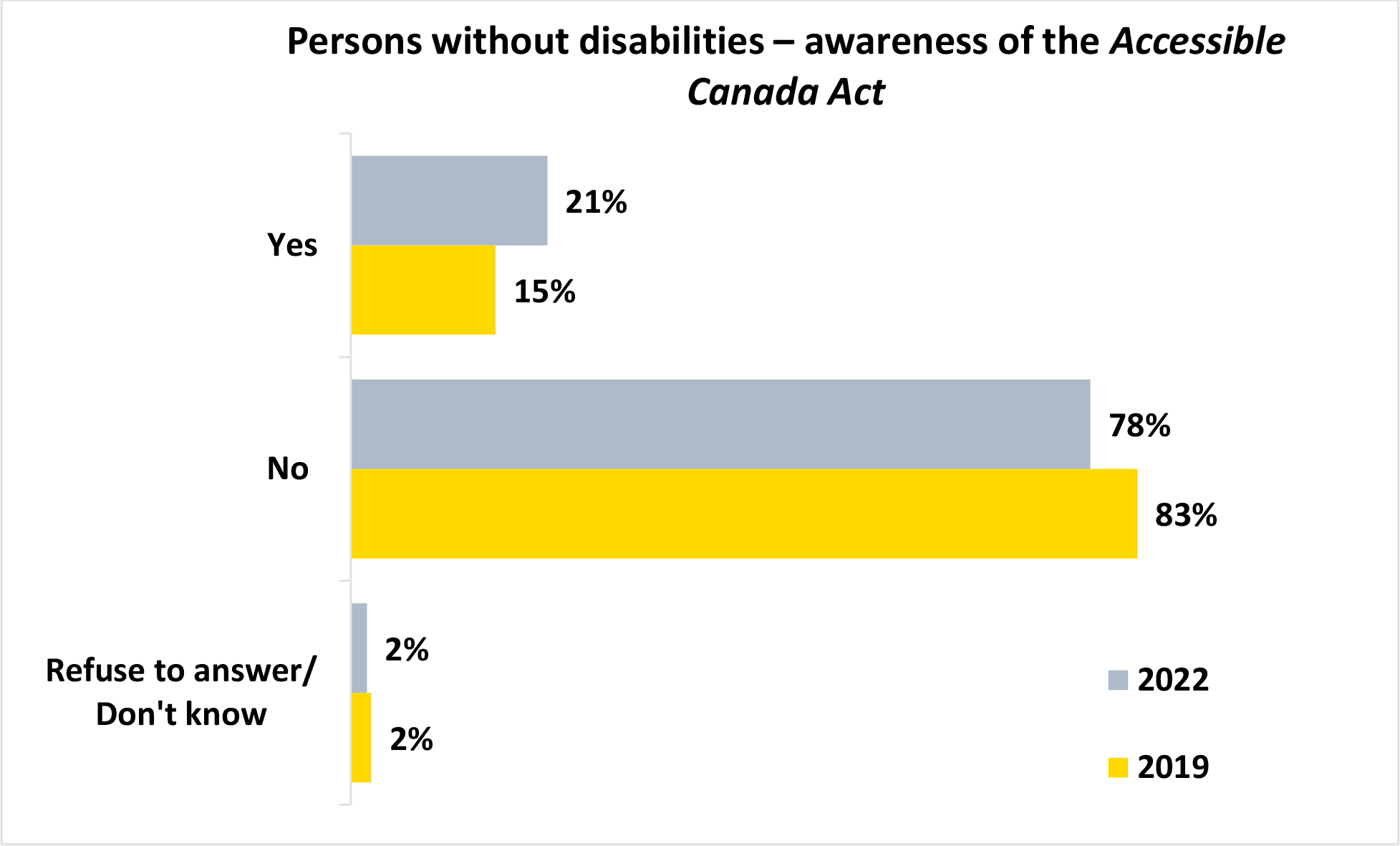
A horizontal bar graph titled, Persons without disabilities awareness of the Accessible Canada Act
The values are as follows. Yes. 2022, 21 percent. 2019, 15 percent. No. 2022, 78 percent. 2019, 83 percent. Refuse to answer forward slash don’t know. 2022, 2 percent. 2019, 2 percent.
Among persons without any disabilities, the following trends emerged:
As age increased, awareness increased, as those 65 years or older reported the highest awareness (24%) followed by 35 to 64 year olds (23%), and then those 18 to 34 years old (12%).
Respondents living in Atlantic Canada (27%) and Ontario (25%) had the highest level of awareness, while those living in Alberta had the lowest (6%).
Women were more likely to be aware compared to men (24% vs 17%).
Respondents with disabilities who were aware of the Act were asked what they remembered about it. Results show that when asked to explain, unprompted, what they remember about this act, 15% of those who could recall it explained it will generally support or assist persons with disabilities and 13% explain it will increase accessibility. Other felt the Act will make government services accessible (7%), that the government will make workplaces accessible (6%), and that the Act will make buildings accessible (6%).
A variety of other responses were provided, all details are listed in the following graph.
Figure 8: Persons with disabilities – recall of details about the Accessible Canada Act
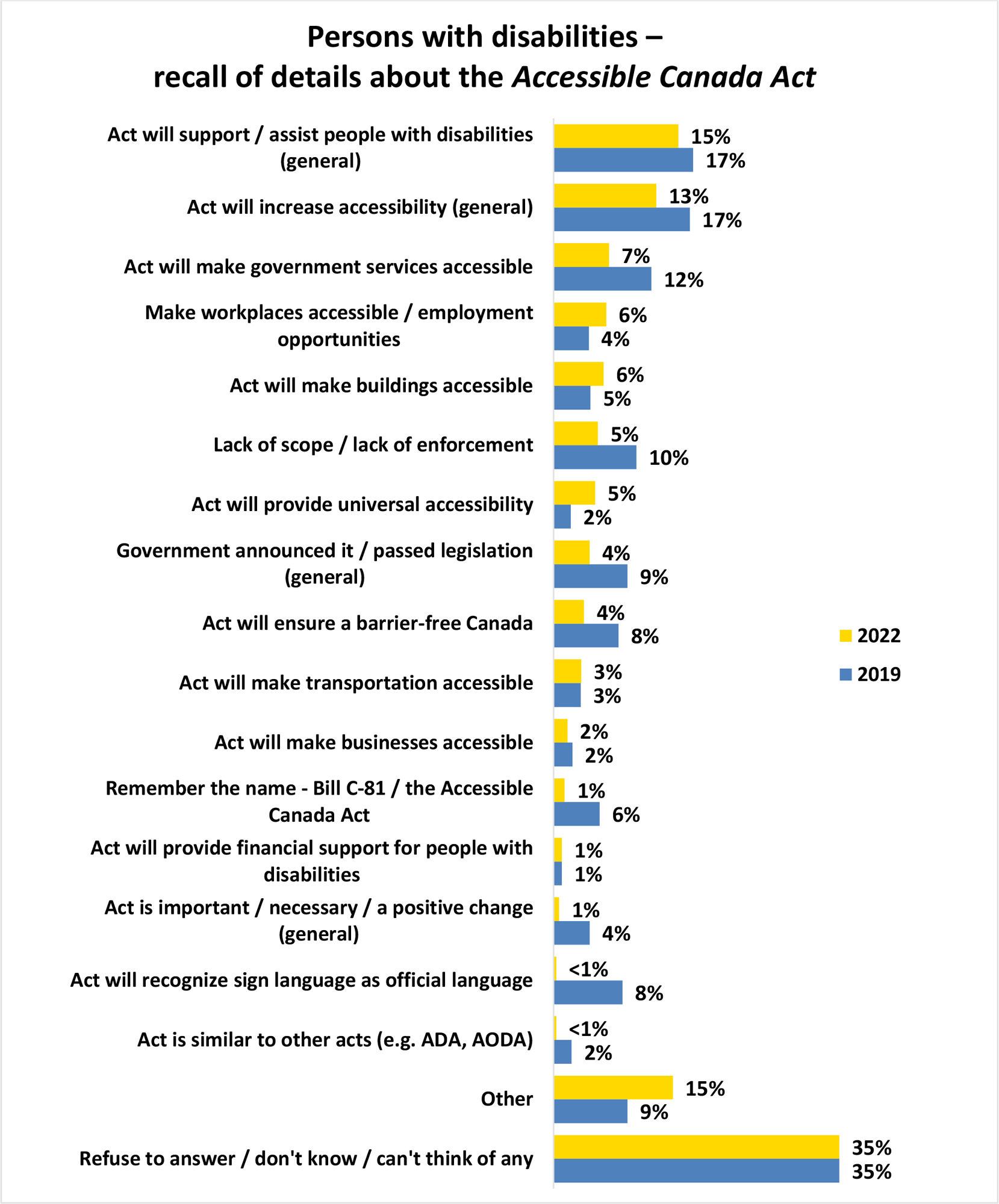
A horizontal bar graph titled, Persons with disabilities recall of details about the Accessible Canada Act
The values are as follows. Act will support forward slash assist people with disabilities open parenthesis general close parenthesis. 2022, 15 percent. 2019, 17 percent. Act will increase accessibility open parenthesis general close parenthesis. 2022, 13 percent. 2019, 17 percent. Act will make government services accessible. 2022, 7 percent. 2019, 12 percent. Make workplaces accessible forward slash employment opportunities. 2022, 6 percent. 2019, 4 percent. Act will make buildings accessible. 2022, 6 percent. 2019, 5 percent. Lack of scope forward slash lack of enforcement. 2022, 5 percent. 2019, 10 percent. Act will provide universal accessibility. 2022, 5 percent. 2019, 2 percent. Government announced it forward slash passed legislation open parenthesis general close parenthesis. 2022, 4 percent. 2019, 9 percent. Act will ensure a barrier-free Canada. 2022, 4 percent. 2019, 8 percent. Act will make transportation accessible. 2022, 3 percent. 2019, 3 percent. Act will make businesses accessible. 2022, 2 percent. 2019, 2 percent. Remember the name - Bill C-81 forward slash the Accessible Canada Act. 2022, 1 percent. 2019, 6 percent. Act will provide financial support for people with disabilities. 2022, 1 percent. 2019, 1 percent. Act is important forward slash necessary forward slash a positive change open parenthesis general close parenthesis. 2022, 1 percent. 2019, 4 percent. Act will recognize sign language as official language. 2022, less than 1 percent. 2019, 8 percent. Act is similar to other acts open parenthesis e.g. A D A, A O D A close parenthesis. 2022, less than 1 percent. 2019, 2 percent. Other. 2022, 15 percent. 2019, 9 percent. Refuse to answer forward slash don’t know forward slash can’t think of any. 2022, 35 percent. 2019, 35 percent.
In terms of subgroup differences among persons with disabilities, the following are noted:
Respondents in Atlantic Canada were the most likely to say that the Act will support and assist persons with disabilities, while those in Ontario tended to feel that the Act will increase accessibility.
As income increased, perceptions that the Act will support and assist persons with disabilities increased.
Persons without any disabilities who are aware of the Act were most inclined to refer to the following when specifically prompted for what they recall about the Act:
The Act will support or assist persons with disabilities (18%).
The Act will increase accessibility in general (10%).
The Act will make buildings accessible (9%).
The Act will make government services accessible (9%).
All other responses were noted by no more than 4% of respondents as detailed in the following graph.
Figure 9: Persons without disabilities – recall of details about the Accessible Canada Act

A horizontal bar graph titled, Persons without disabilities recall of details about the Accessible Canada Act
The values are as follows. Act will support forward slash assist people with disabilities open parenthesis general close parenthesis. 2022, 18 percent. 2019, 20 percent. Act will increase accessibility open parenthesis general close parenthesis. 2022, 10 percent. 2019, 16 percent. Act will make buildings accessible. 2022, 9 percent. 2019, 4 percent. Act will make government services accessible. 2022, 9 percent. 2019, 3 percent. Government announced it forward slash passed legislation. 2022, 4 percent. 2019, 10 percent. Make workplaces accessible forward slash employment opportunities. 2022, 4 percent. 2019, 3 percent. Act will make businesses accessible. 2022, 4 percent. 2019, 2 percent. Act will provide universal accessibility. 2022, 3 percent. Act will provide financial support for people with disabilities. 2022, 2 percent. 2019, 4 percent. Act will make transportation accessible. 2022, 2 percent. 2019, 1 percent. Act is important forward slash necessary forward slash a positive change open parenthesis general close parenthesis. 2022, 1 percent. 2019, 2 percent. Lack of scope forward slash lack of enforcement. 2022, 1 percent. 2019, 1 percent. Act is similar to other acts open parenthesis e.g. A D A, A O D A close parenthesis. 2022, 1 percent. Act will recognize sign language as official language. 2022, 1 percent. 2019, 1 percent. Act will ensure a barrier-free Canada. 2022, less than 1 percent. Remember the name - Bill C-81 forward slash the Accessible Canada Act. 2022, less than 1 percent. 2019, 7 percent. Other. 2022, 19 percent. 2019, 10 percent. Refuse to answer forward slash don’t know forward slash can’t think of any. 2022, 36 percent. 2019, 38 percent.
Information and communication technology (ICT) access (PWOD)
To evaluate the extent to which information and communication technology (ICT) was accessible, respondents were first asked to specify whether they had access to the internet at home. Nearly all respondents (97%) reported having access to the internet, while roughly 3% did not.
Figure 10: Persons without disabilities – access to the internet at home
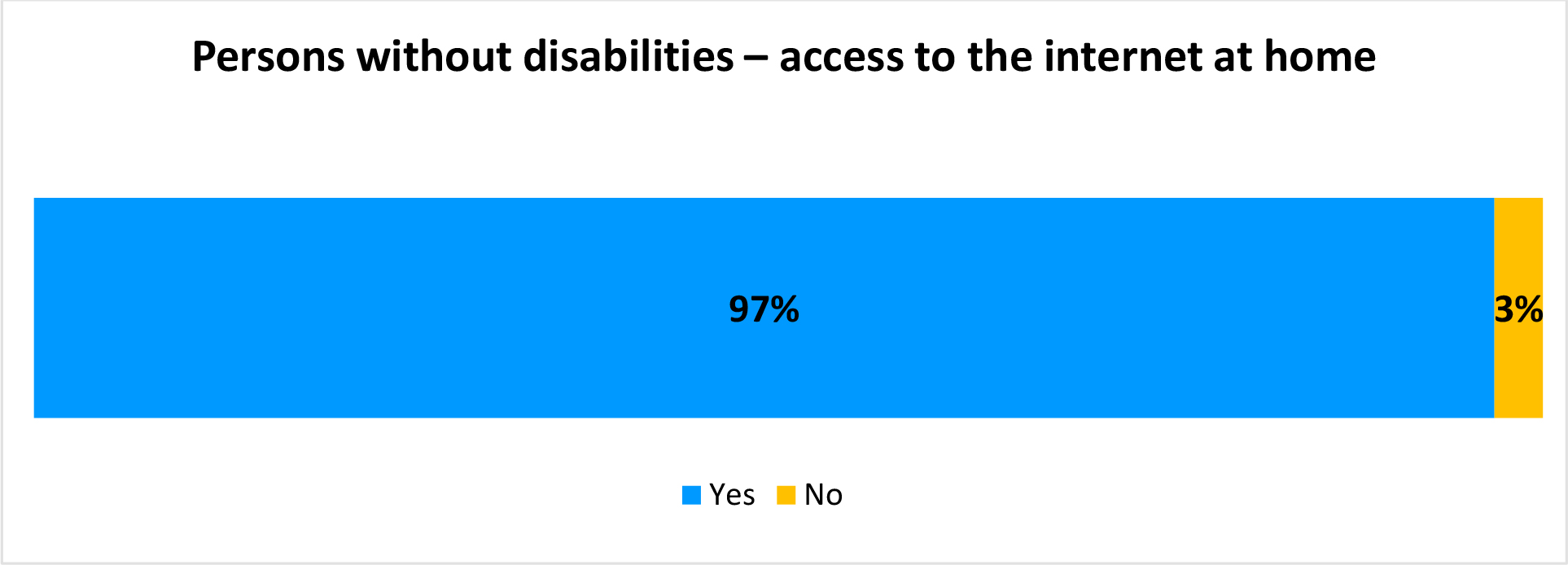
The following subgroup findings emerged:
As respondents age decreased, access to the internet increased, with those 18 to 34 years old having reported the greatest degree of access (99%), compared to those 35 to 64 (98%), followed by those 65 years or older (89%).
Those with a university education were more likely to have access to the internet compared to those with a high school education (99% vs 92%).
Non-Indigenous respondents were more likely to have access to the internet compared to Indigenous respondents (97% vs 91%).
Respondents who specified they did not have access to the internet at home where then asked to describe the reasons for a lack of access. More than half of those who did not currently have access felt there is a lack of need or interest (51%), rather than a specific barrier to access.
Among those citing specific barriers, more than one in five were restricted by the cost to access (21%), while nearly one in ten mentioned a lack of service (10%), a lack of a device (6%), or some degree of privacy concern (5%).
Figure 11: Persons without disabilities – reasoning for lack of internet access at home
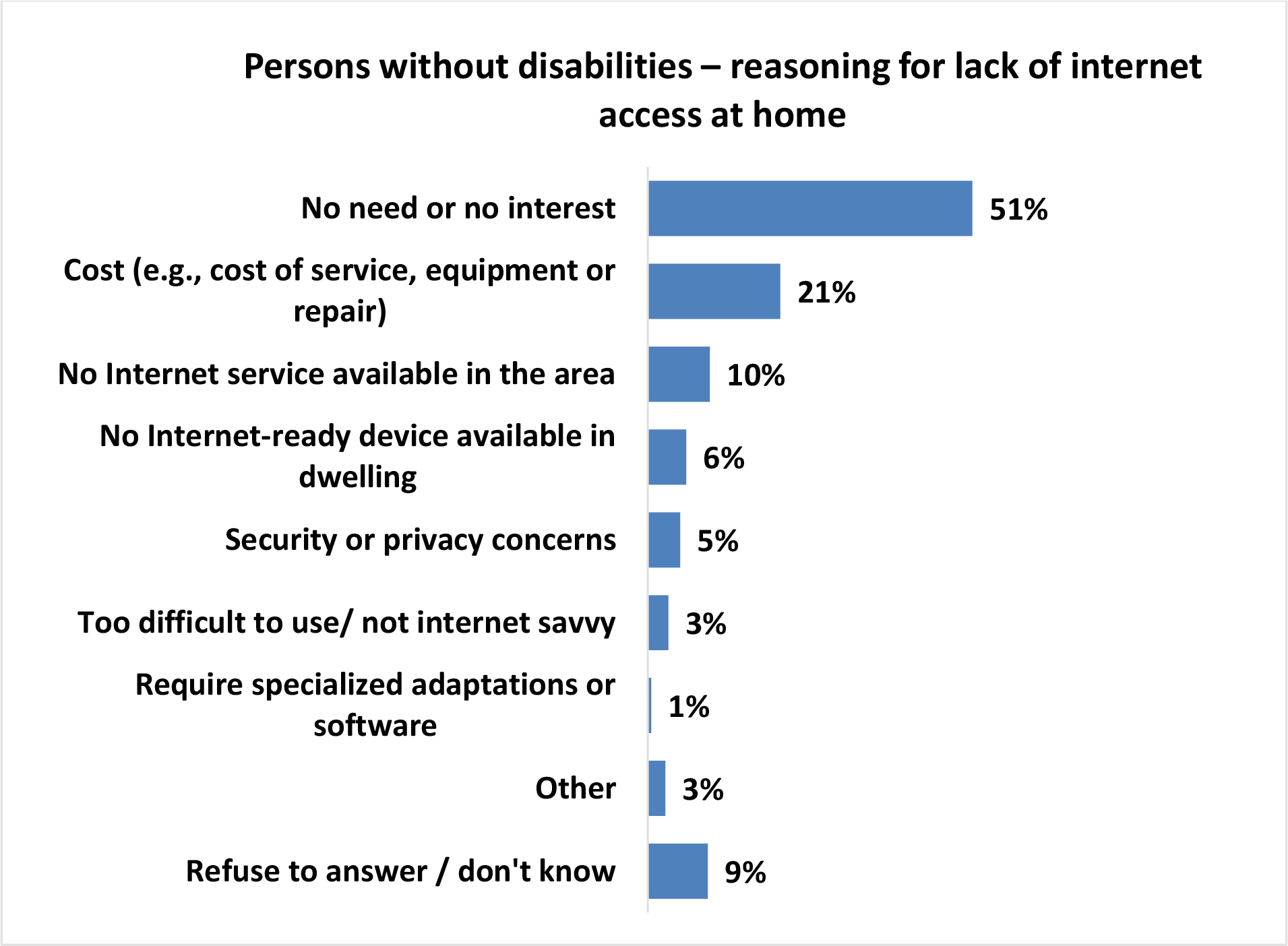
A horizontal bar graph titled, Persons without disabilities – reasoning for lack of internet access at home
The values are as follows. No need or no interest, 51 percent. Cost open parenthesis e.g., cost of service, equipment or repair close parenthesis, 21 percent. No Internet service available in the area, 10 percent. No Internet-ready device available in dwelling, 6 percent. Security or privacy concerns, 5 percent. Too difficult to use forward slash not internet savvy, 3 percent. Require specialized adaptations or software, 1 percent. Other, 3 percent. Refuse to answer forward slash don’t know, 9 percent.
Information and communication technology (ICT)-related barriers (PWOD)
Respondents were specifically provided with the following description for barriers to accessibility:
Survey respondents were then asked to provide the extent to which they had seen or heard of someone with a disability experiencing any of six barriers related to the use of or access to information and communication technology (ICT). It should be noted that in 2019, respondents were asked if they had “witnessed” anything in the previous 12 months whereas in 2022, respondents were asked if they had “seen or heard” of any barriers being encountered in the previous two years.
Results reveal that no more than one in ten respondents say they “always” or “often” saw or heard of someone with a disability facing a barrier with each of the types of technologies explored in this study. Over the past two years, the incidence of respondents having seen or heard of someone with a disability experiencing the following technology barriers because of an accessibility issue either “always” or “often” are:
Using a website (10%),
Using self-service technology in a public place (8%),
Using a cellphone or accessing a wireless service (7%),
Watching a video on the internet, for example on YouTube, Facebook, other social media or websites (7%),
Watching a show on a streaming service such as Netflix, AppleTV, Crave, Amazon Prime, or a similar service (6%), or
Watching cable TV (4%).
All technologies other than watching cable experienced a slight increase in scores of “always” or “often” compared to results observed in 2019.
However, nearly half of respondents say they have “never” seen of or heard these situations in 2022, up across each result observed in 2019.
Figure 12: How often someone without a disability saw or heard of someone with a disability encountering specific ICT-related barriers
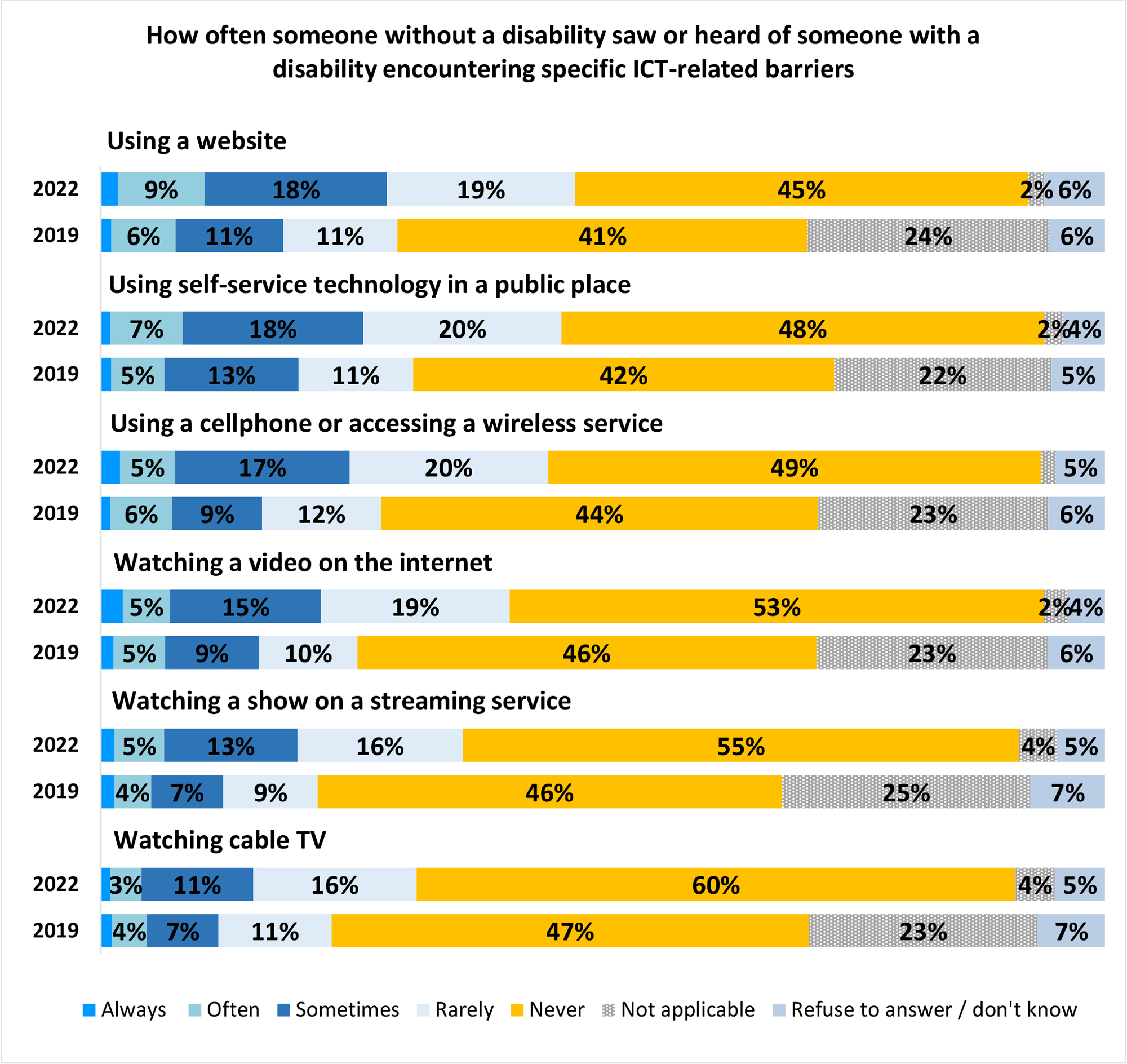
A horizontal bar graph titled, How often someone without a disability saw or heard of someone with a disability encountering specific I C T-related barriers
The values are as follows. Using a website. 2022. Always, 2 percent. Often, 9 percent. Sometimes, 18 percent. Rarely, 19 percent. Never, 45 percent. Not applicable, 2 percent. Refuse to answer forward slash don’t know, 6 percent. 2019. Always, 1 percent. Often, 6 percent. Sometimes, 11 percent. Rarely, 11 percent. Never, 41 percent. Not applicable, 24 percent. Refuse to answer forward slash don’t know, 6 percent. Using self-service technology in a public place. 2022. Always, 1 percent. Often,7 percent. Sometimes, 18 percent. Rarely, 20 percent. Never, 48 percent. Not applicable, 2 percent. Refuse to answer forward slash don’t know, 4 percent. 2019. Always, 1 percent. Often, 5 percent. Sometimes, 13 percent. Rarely, 11 percent. Never, 42 percent. Not applicable, 22 percent. Refuse to answer forward slash don’t know, 5 percent. Using a cellphone or accessing a wireless service. 2022. Always, 2 percent. Often, 5 percent. Sometimes, 17 percent. Rarely, 20 percent. Never, 49 percent. Not applicable, 2 percent. Refuse to answer forward slash don’t know, 5 percent. 2019. Always, 1 percent. Often, 6 percent. Sometimes, 9 percent. Rarely, 12 percent. Never, 44 percent. Not applicable, 23 percent. Refuse to answer forward slash don’t know, 6 percent. Watching a video on the internet. 2022. Always, 2 percent. Often, 5 percent. Sometimes, 15 percent. Rarely, 19 percent. Never, 53 percent. Not applicable, 2 percent. Refuse to answer forward slash don’t know, 4 percent. 2019. Always, 1 percent. Often, 5 percent. Sometimes, 9 percent. Rarely, 10 percent. Never, 46 percent. Not applicable, 23 percent. Refuse to answer forward slash don’t know, 6 percent. Watching a show on a streaming service. 2022. Always, 1 percent. Often, 5 percent. Sometimes, 13 percent. Rarely, 16 percent. Never, 55 percent. Not applicable, 4 percent. Refuse to answer forward slash don’t know, 5 percent. 2019. Always, 1 percent. Often, 4 percent. Sometimes, 7 percent. Rarely, 9 percent. Never, 46 percent. Not applicable, 25 percent. Refuse to answer forward slash don’t know, 7 percent. Watching cable T V. 2022. Always, 1 percent. Often, 3 percent. Sometimes, 11 percent. Rarely, 16 percent. Never, 60 percent. Not applicable, 4 percent. Refuse to answer forward slash don’t know, 5 percent. 2019. Always, 1 percent. Often, 4 percent. Sometimes, 7 percent. Rarely, 11 percent. Never, 47 percent. Not applicable, 23 percent. Refuse to answer forward slash don’t know, 7 percent.
Design and delivery of programs and services (PWOD)
To establish a baseline for access to services or programs from federal sector organizations, respondents were asked to provide their preferred mode of access over the past two years. Respondents were provided with the following description for federal sector organizations:
More than half of survey respondents preferred to access services online (53%), while more than one in five selected in person (21%). Telephone communication was preferred by more than one in ten (13%), with mailing options cited by 7% of respondents.
Less commonly used delivery methods include email, among others. Few respondents described no usage of any federal sector organization programs or services (4%).
Figure 13: Persons without disabilities – preferred mode for accessing services or programs from federal sector organizations
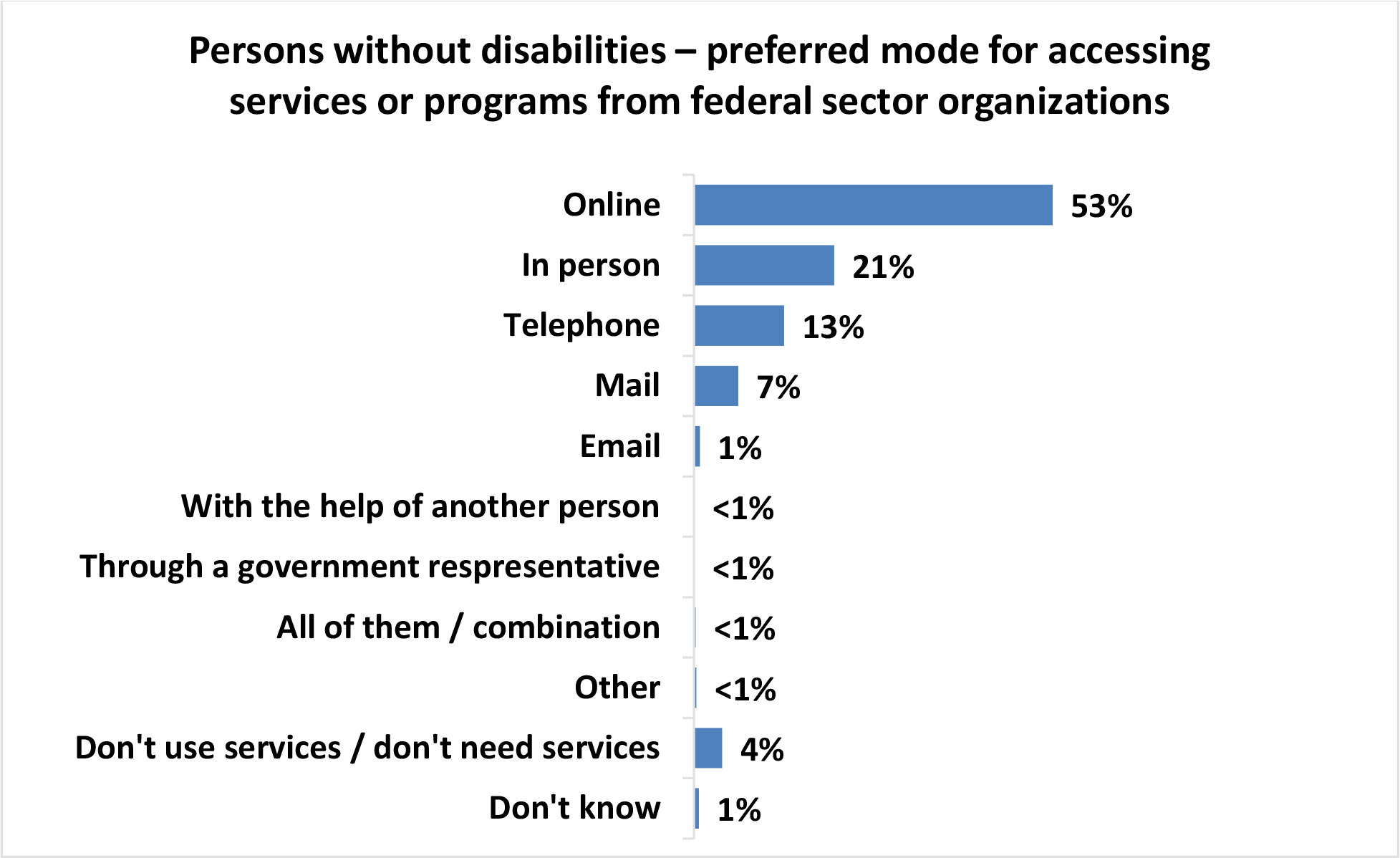
A horizontal bar graph titled, Persons without disabilities – preferred mode for accessing services or programs from federal sector organizations
The values are as follows. Online, 53 percent. In person, 21 percent. Telephone, 13 percent. Mail, 7 percent. Email, 1 percent. With the help of another person, Less than 1 percent. Through a government representative, less than 1 percent. All of them forward slash combination, less than 1 percent. Other, less than 1 percent. Don’t use services forward slash don’t need services, 4 percent. Don’t know, 1 percent.
From a subgroup perspective, the following differences were noted:
Respondents in Ontario (58%) and Quebec (55%) more commonly preferred online service compared to those in Alberta (39%).
Respondents living in all regions were more likely to report a preference for in person service compared to those living in Quebec (10%).
Those living in Alberta (22%), or Quebec (21%) were more likely to prefer telephone service compared to those in Atlantic Canada (10%), or Ontario (6%).
As age decreased, likelihood to prefer online service increased as those 18 to 34 (64%) scored higher than those 35 to 64 (53%), and those 65 or older (35%).
Those with a university education were more likely to prefer online service compared to those with a high school education (57% vs 45%).
As income increased, tendency to prefer online service also increased, as those earning $80,000 or more (62%) scored higher than those earning $40,000 to $79,999 (51%), $20,000 to $39,999 (36%), and those under $20,000 (34%).
Non-Indigenous respondents were more likely to prefer accessing services online compared to Indigenous respondents (54% vs 23%). Indigenous respondents were more likely to prefer mail compared to non-Indigenous respondents (28% vs 6%).
Communication other than information and communications technologies (PWOD)
In addition to evaluating ICT-related communications, respondents were asked a series of questions surrounding the accessibility of various printed communications from federal sector organizations.
Respondents were informed that printed materials include items like books, letters, forms, posters, and online content among various kinds of communication. Survey respondents were asked to describe how often they have seen or heard of situations in which someone with a disability needed federal sector organizations, including the Government of Canada, to provide accessible formats for these materials.
More than one in five respondents (21%) said they had “always” or “often” seen or heard of the need for federal sector organizations to make materials available in accessible formats. In addition, 22% “sometimes” seeing or hearing of this requirement, while 21% said “rarely” and 29% indicated “never”.
Figure 14: How often someone without a disability saw or heard of someone with a disability needing federal sector printed communications in an accessible format

A horizontal bar graph titled, How often someone without a disability saw or heard of someone with a disability needing federal sector printed communications in an accessible format
The values are as follows. Always, 5 percent. Often, 16 percent. Sometimes, 22 percent. Rarely, 21 percent. Never, 29 percent. Prefer not to say forward slash don’t know, 7 percent.
Subgroup differences identified include the following:
Respondents living in Atlantic Canada (31%), or Ontario (24%), more commonly saw or heard these needs “always” or “often” compared to those living in Quebec (16%), or Manitoba and Saskatchewan (10%).
Respondents aged 18 to 34 years old were more likely to indicate they “always” or “often” saw or heard these needs compared to those 65 years or older (25% vs 16%).
Those working full-time were more likely to describe “always” or “often” having seen or heard these needs compared to those who were retired (22% vs 16%).
Those who reported observing a need for federal government sector printed communications to be made available in accessible formats “always”, “often”, or “sometimes” were then asked to describe the type of accessible format that was needed.
The most common types of accessible formats these respondents saw or heard someone with a disability needing were large print (39%), plain language (33%), text to speech compatible (26%), audio versions (26%) and closed captioning (25%). Additional mentions included e-books (23%), sign language versions (22%), and braille (17%).
Nearly one in five (18%) could not remember the specific type of alternate format needed.
Figure 15: Types of accessible formats needed by persons with disabilities as seen or heard by persons without a disability
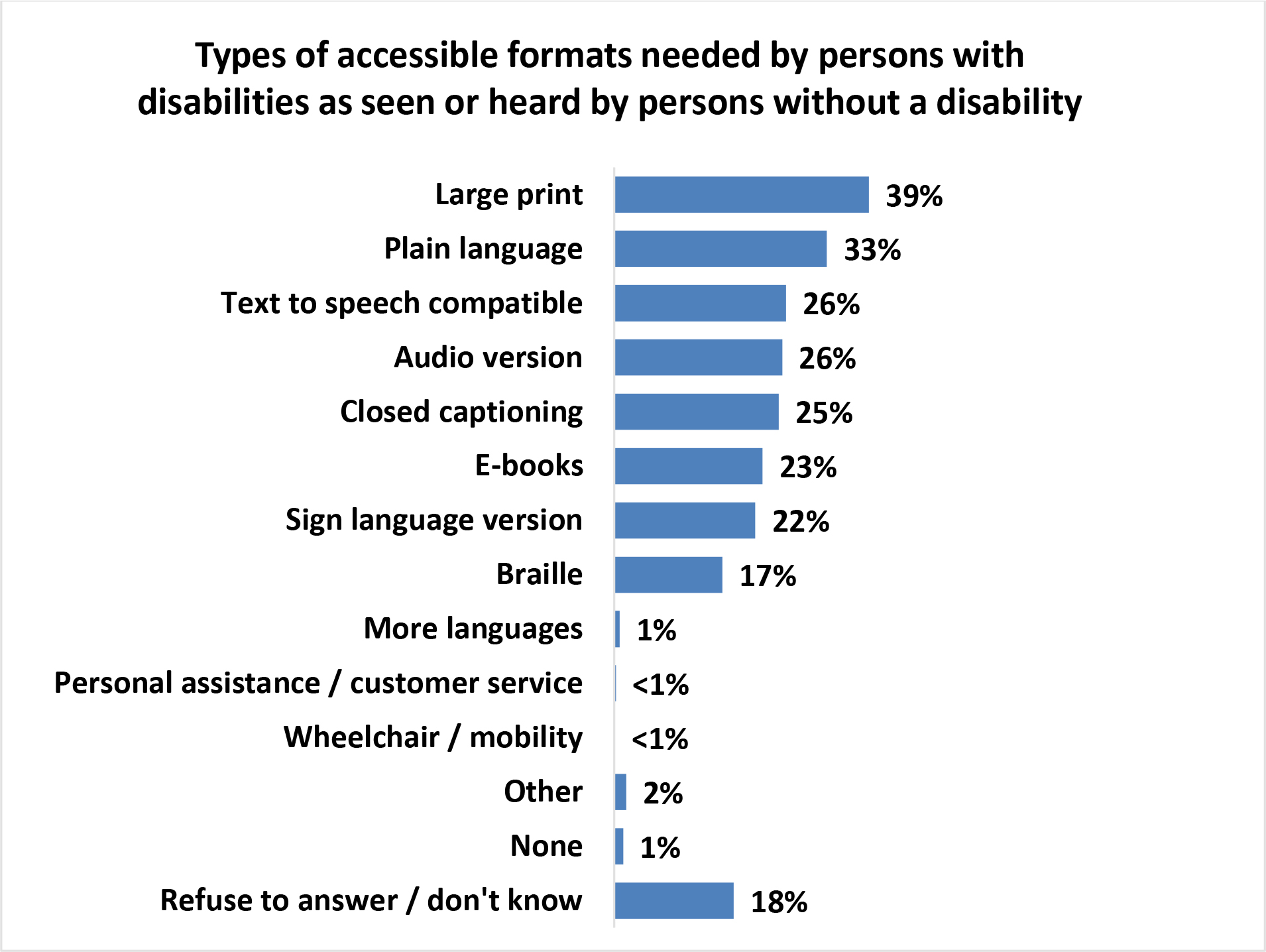
A horizontal bar graph titled, Types of accessible formats needed by persons with disabilities as seen or heard by persons without a disability
The values are as follows. Large print, 39 percent. Plain language, 33 percent. Text to speech compatible, 26 percent. Audio version, 26 percent. Closed captioning, 25 percent. E-books, 23 percent. Sign language version, 22 percent. Braille, 17 percent. More languages, 1 percent. Personal assistance forward slash customer service, less than 1 percent. Wheelchair forward slash mobility, less than 1 percent. Other, 2 percent. None, 1 percent. Refuse to answer forward slash don’t know, 18 percent.
Disability types among PWDs
When PWD respondents were asked if they identified themselves as a person with a disability, 65% agreed. To ultimately determine whether a respondent was considered, for the purposes of this research, as a person with a disability according to the study criteria, a more comprehensive approach was used, as described below.
As a continuation of the first wave of research in 2019, a series of questions was developed by Quorus and ESDC to identify persons with disabilities. Wording for some of these questions was borrowed from existing survey instruments and was customized for the purposes of this particular study.
All survey respondents were asked to indicate if they had any of 13 different disabilities: mobility, pain, flexibility, dexterity, mental health-related, memory, seeing, hearing, learning, communication, speech, developmental, language, or any other type of disability. More information on how these disabilities were described to respondents is provided in the following section.
The incidence of a given disability was determined in two different ways:
The unadjusted incidence considers the proportion of individuals who answer “yes” when asked if they had a given disability.
These individuals were then asked up to two additional questions to determine the overall “adjusted incidence” of a given disability:
They were first asked to also specify how often they felt limited in terms of being included in society because of this disability. Those who responded “always”, “often” or “sometimes” were included in the calculation of the adjusted incidence.
Those who responded “rarely” were then asked the level of difficulty they had with that disability and all those who said they had at least “some difficulty” were included in the calculation of the adjusted incidence6.
Participants who met the criteria for the adjusted incidence for at least one type of disability were part of the disability segment7.
The following section shows the results for these questions for each disability, followed by a graphic based on the respondents who were eventually categorized for that particular disability (adjusted incidence for the disability). Where sample sizes were sufficient, level of difficulty experienced with a particular disability was included.
Pain disability
Over half (53%) of survey respondents with a disability said they suffer from pain, remaining consistent with results observed in 2019. This disability was described as “a chronic pain disorder that affects a person’s ability to function due to pain, this is the type of pain that continues over a long period of time and disrupts a person’s life”. Nearly four in five of these respondents (78%) said this disability “always”, “often”, or “sometimes” limited their inclusion in society. Among those who said this happens “rarely”, 98% said they have at least “some difficulty” with pain.
Figure 16: Persons with disabilities – pain (unadjusted incidence): have this type of disability
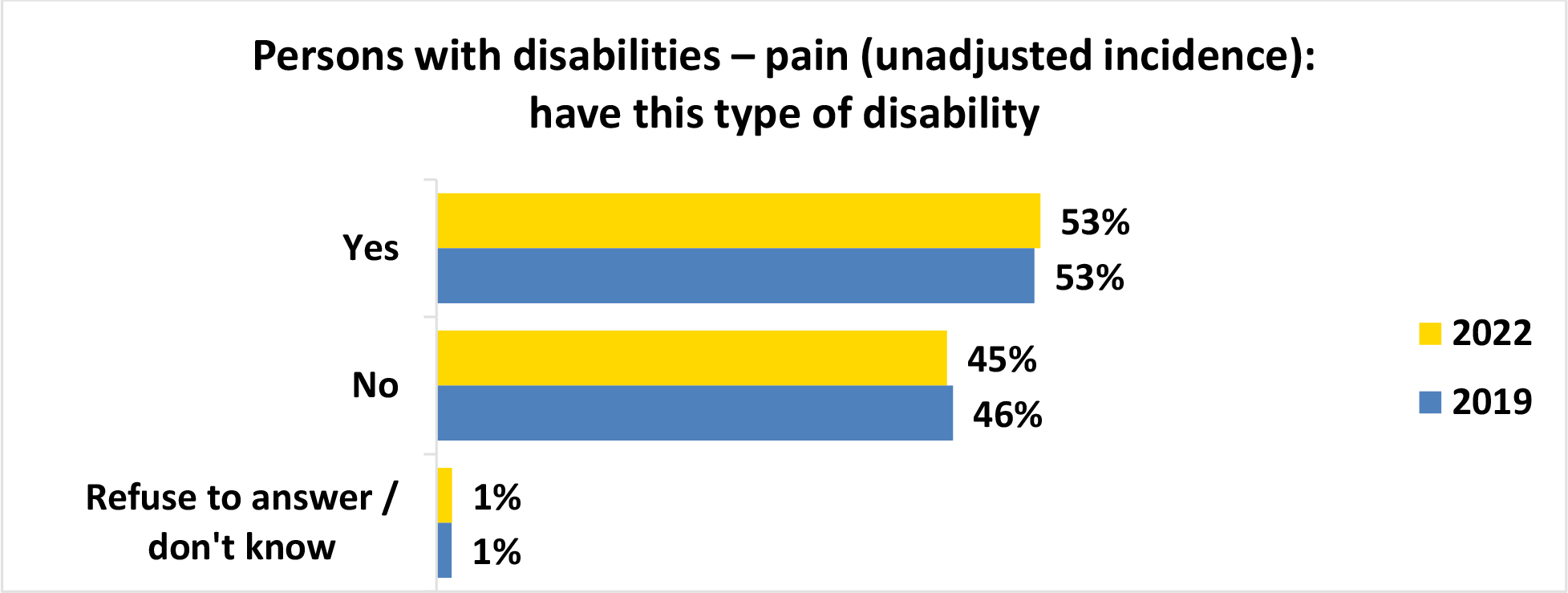
A horizontal bar graph titled, Persons with disabilities pain open parenthesis unadjusted incidence close parenthesis have this type of disability
The values are as follows. Yes. 2022, 53 percent. 2019, 53 percent. No. 2022, 45 percent. 2019, 46 percent. Refuse to answer forward slash don’t know. 2022, 1 percent. 2019, 1 percent.
Figure 17: Persons with disabilities – pain: frequency of environment limiting inclusion in society

A horizontal bar graph titled, Persons with disabilities – pain: frequency of environment limiting inclusion in society
The values are as follows. 2022. Always, 14 percent. Often, 29percent. Sometimes, 36 percent. Rarely, 12 percent. Never, 9 percent. 2019. Always, 21 percent. Often, 31 percent. Sometimes, 28 percent. Rarely, 13 percent. Never, 7 percent.
Figure 18: Persons with disabilities – pain: difficulty with disability
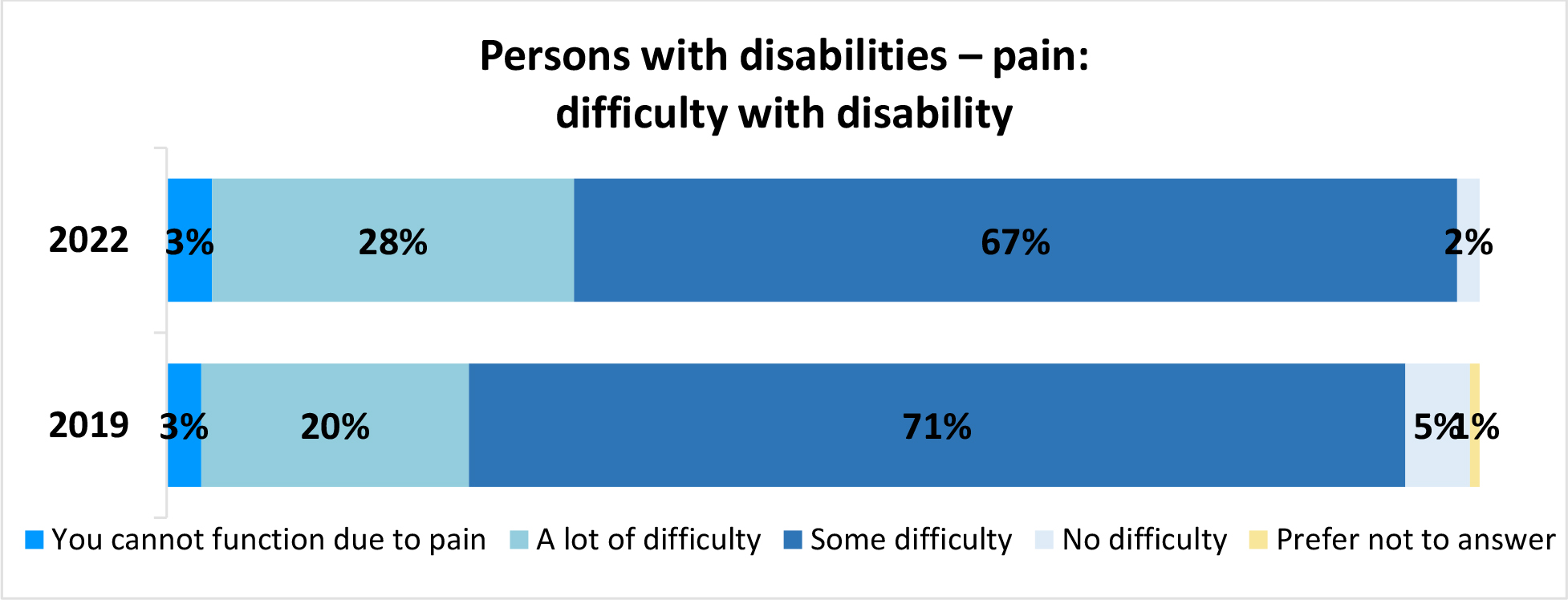
A horizontal bar graph titled, Persons with disabilities – pain: difficulty with disability
The values are as follows. 2022. You cannot function due to pain, 3 percent. A lot of difficulty, 28 percent. Some difficulty, 67 percent. No difficulty, 2 percent. 2019. You cannot function due to pain, 3 percent. A lot of difficulty, 20 percent. Some difficulty, 71 percent. No difficulty, 5 percent. prefer not to answer, 4 percent.
Once the incidence was adjusted for those with a pain disability, 48% of participants had this disability in 2022. More women said they had this disability than men, it was less common among respondents 18 to 34 years of age, and it was more common among those in households earning no more than $40,000 per year. The regions with the highest proportion of respondents with this disability were British Columbia, Atlantic Canada, and Ontario.
Figure 19: Persons with disabilities – pain (adjusted incidence): have this type of disability
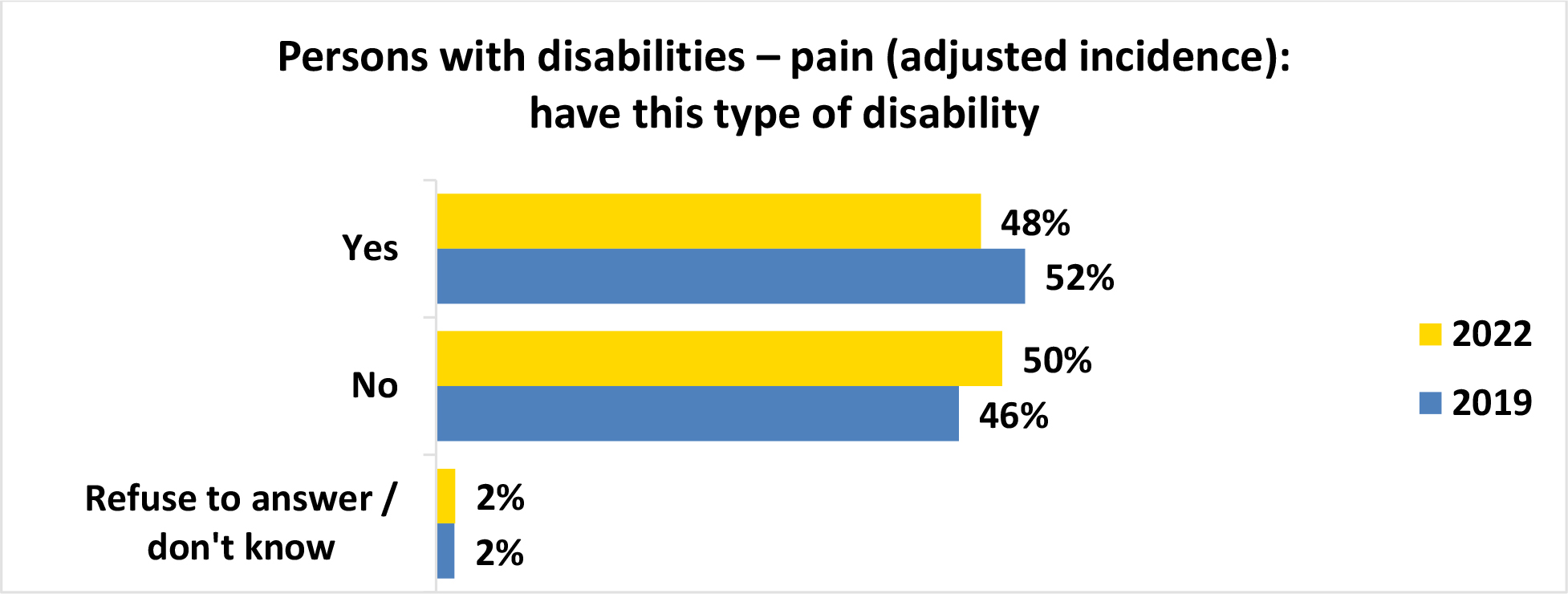
A horizontal bar graph titled, Persons with disabilities pain open parenthesis unadjusted incidence close parenthesis have this type of disability
The values are as follows. Yes. 2022, 48 percent. 2019, 52 percent. No. 2022, 50 percent. 2019, 46 percent. Refuse to answer forward slash don’t know. 2022, 2 percent. 2019, 2 percent.
Mobility disability
Half of all survey respondents with a disability said they had a mobility disability (50%), a slight decrease from results observed in 2019 (55%). This was described as “a physical disability that affects a person’s ability to move”. Nearly four in five of these respondents (78%) said this disability “always”, “often”, or “sometimes” limited their inclusion in society, down slightly from 2019 (83%). Among those who said this happens “rarely”, 90% said they have at least “some difficulty” moving.
Figure 20: Persons with disabilities – mobility (unadjusted incidence): have this type of disability
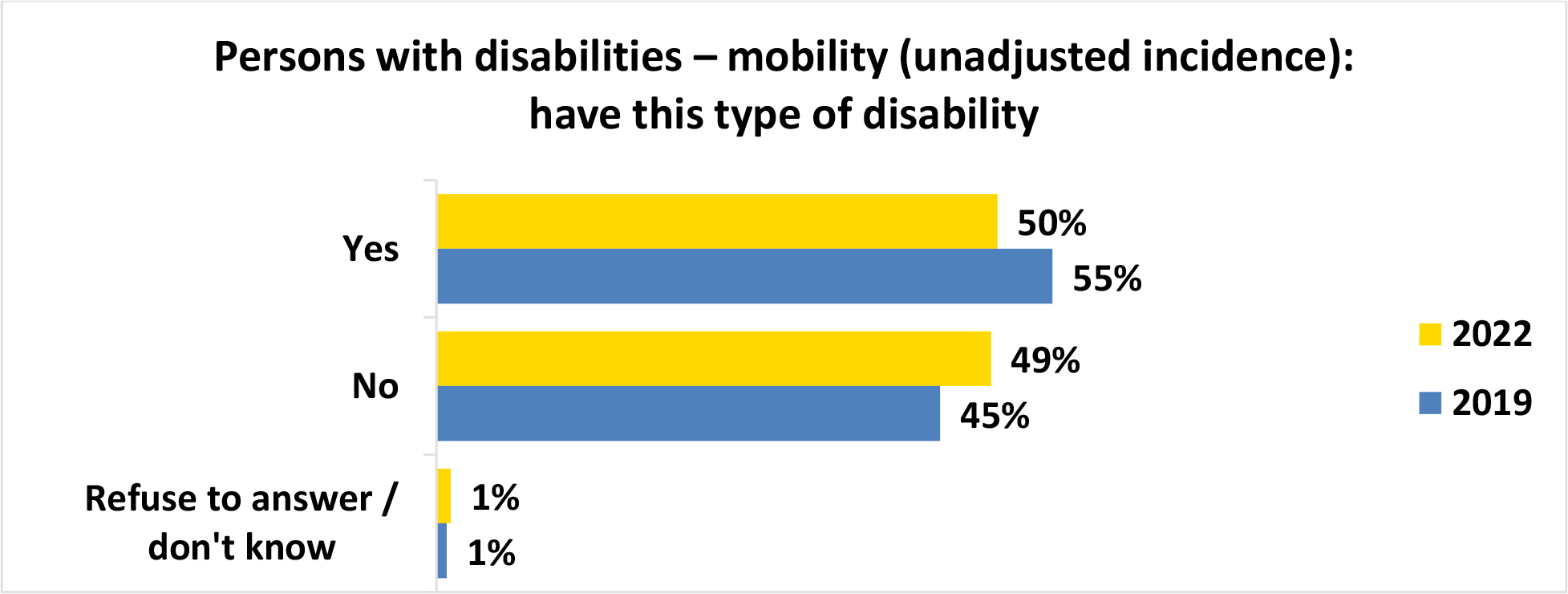
A horizontal bar graph titled, Persons with disabilities mobility open parenthesis unadjusted incidence close parenthesis have this type of disability
The values are as follows. Yes. 2022, 50 percent. 2019, 55 percent. No. 2022, 49 percent. 2019, 45 percent. Refuse to answer forward slash don’t know. 2022, 1 percent. 2019, 1 percent.
Figure 21: Persons with disabilities – mobility: frequency of environment limiting inclusion in society
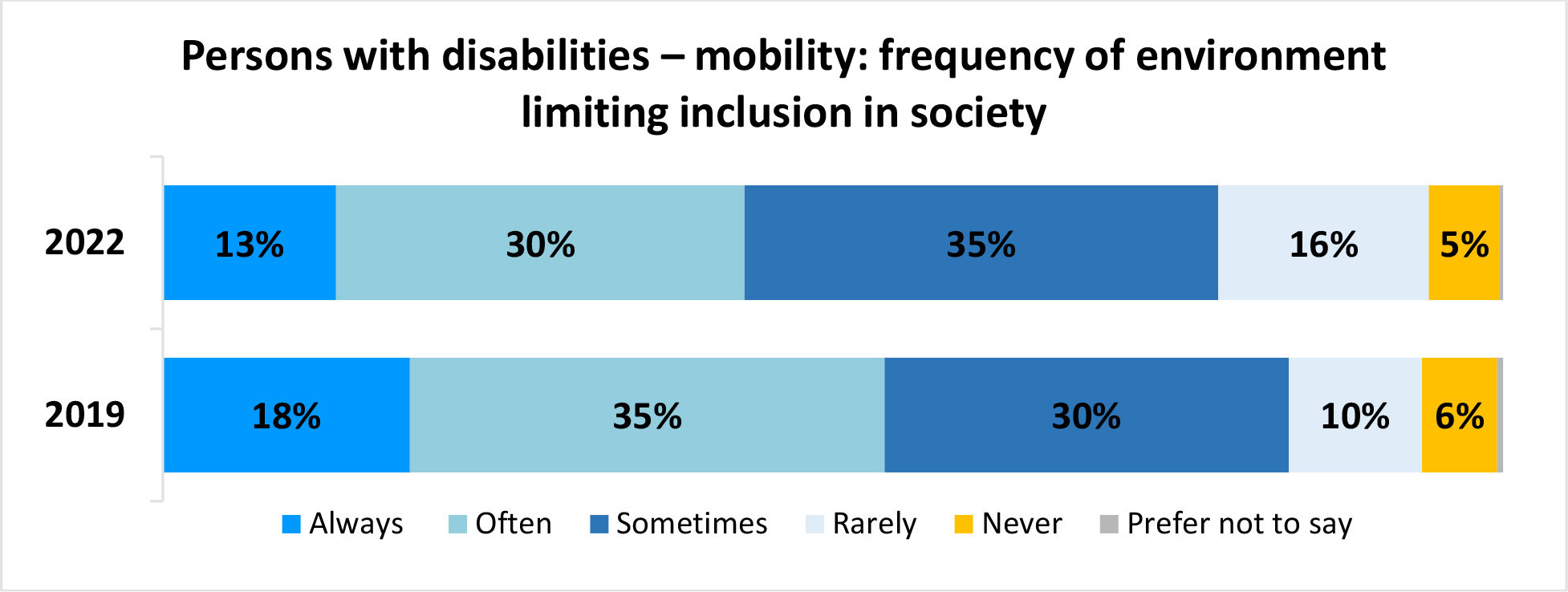
A horizontal bar graph titled, Persons with disabilities – mobility: frequency of environment limiting inclusion in society
The values are as follows. 2022. Always, 13 percent. Often, 30 percent. Sometimes, 35 percent. Rarely, 16 percent. Never, 5 percent. 2019. Always, 18 percent. Often, 35 percent. Sometimes, 30 percent. Rarely, 10 percent. Never, 6 percent.
Figure 22: Persons with disabilities – mobility: difficulty with disability
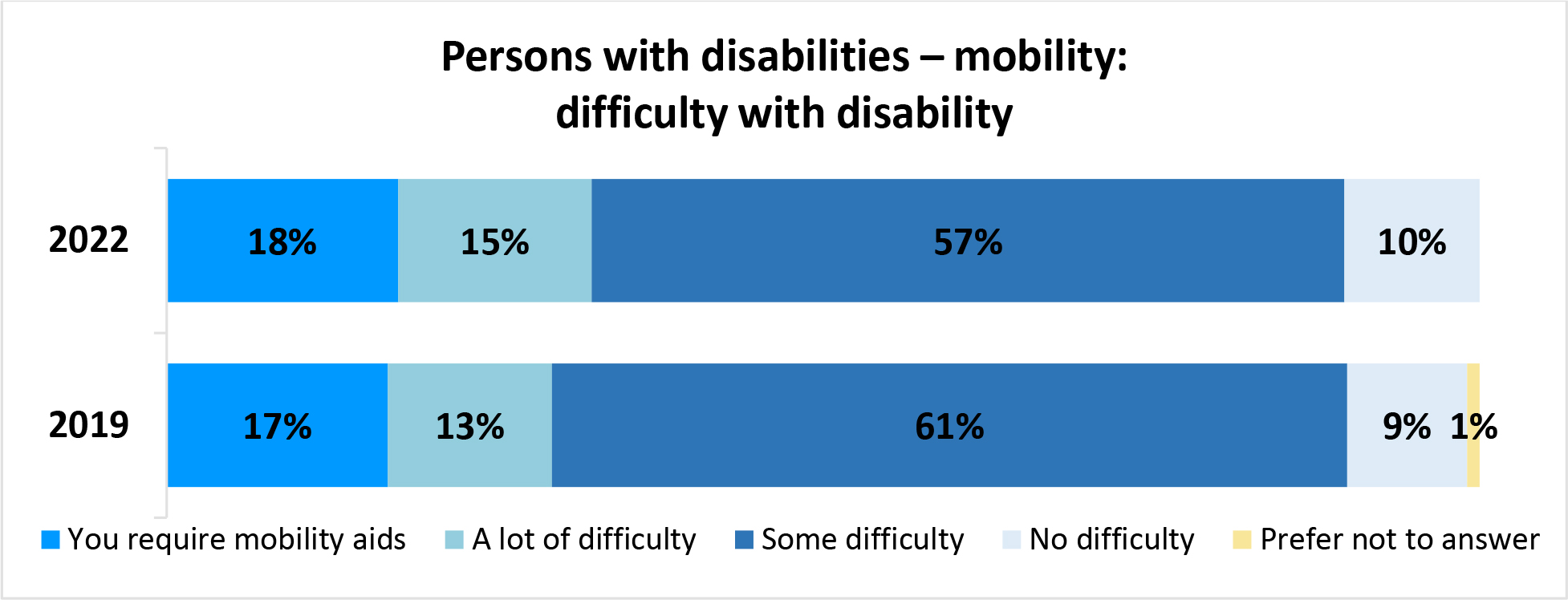
A horizontal bar graph titled, Persons with disabilities – mobility: difficulty with disability
The values are as follows. 2022. You require mobility aids, 18 percent. A lot of difficulty, 15 percent. Some difficulty, 57 percent. No difficulty, 10 percent. 2019. You require mobility aids, 17 percent. A lot of difficulty, 13 percent. Some difficulty, 61 percent. No difficulty, 9 percent. prefer not to answer, 1 percent.
Once the incidence was adjusted, 46% of participants were affected by a mobility disability in 2022. The older respondents were, the more likely they were to indicate having a mobility impairment. The lower the income of the respondent the more commonly they had a mobility disability. Atlantic Canada and British Columbia had the highest proportion of respondents with this disability.
Figure 23: Persons with disabilities – mobility (adjusted incidence): have this type of disability
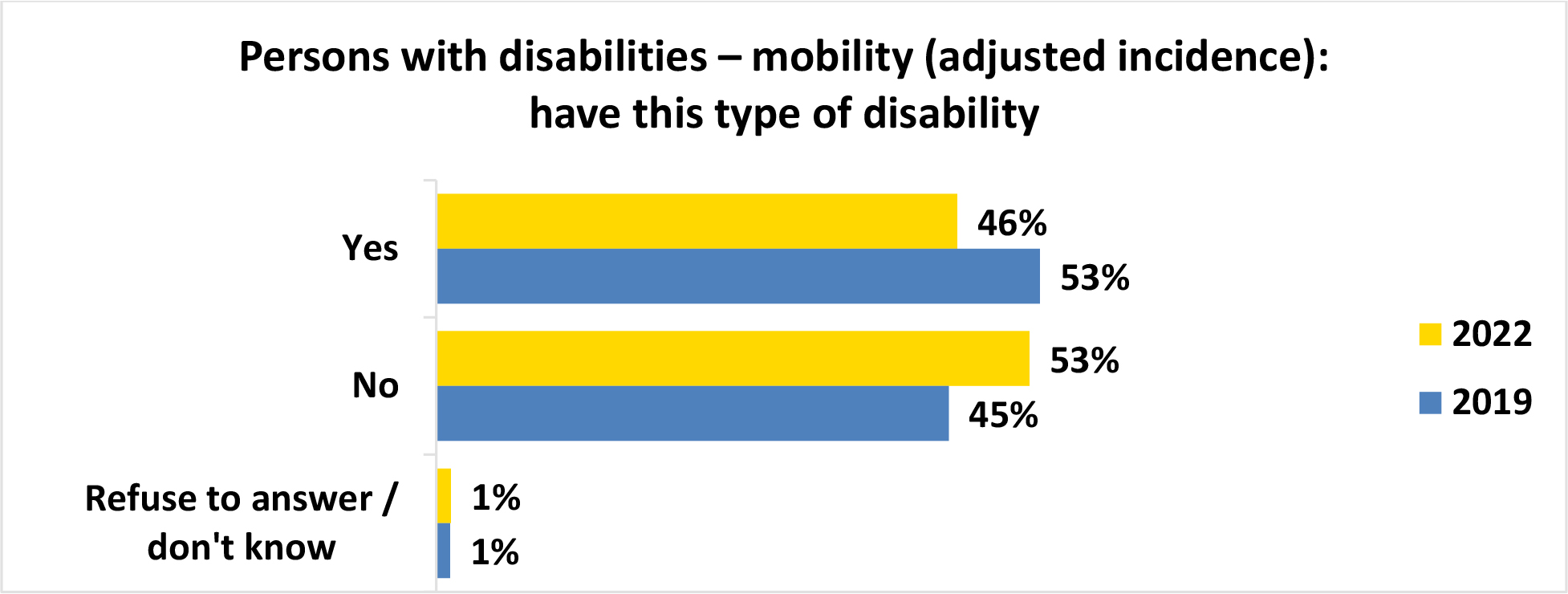
A horizontal bar graph titled, Persons with disabilities mobility open parenthesis unadjusted incidence close parenthesis have this type of disability
The values are as follows. Yes. 2022, 46 percent. 2019, 53 percent. No. 2022, 53 percent. 2019, 45 percent. Refuse to answer forward slash don’t know. 2022, 1 percent. 2019, 1 percent.
Flexibility disability
Nearly half (45%) of survey respondents said they had a flexibility disability, down slightly from the previous wave. This disability was described as “a physical disability that affects a person’s ability to move their joints”. Nearly three quarters of these respondents (74%) said this disability “always”, “often”, or “sometimes” limited their inclusion in society. Among those who said this happens “rarely”, 95% said they have at least “some difficulty” with flexibility.
Figure 24: Persons with disabilities – flexibility (unadjusted incidence): have this type of disability
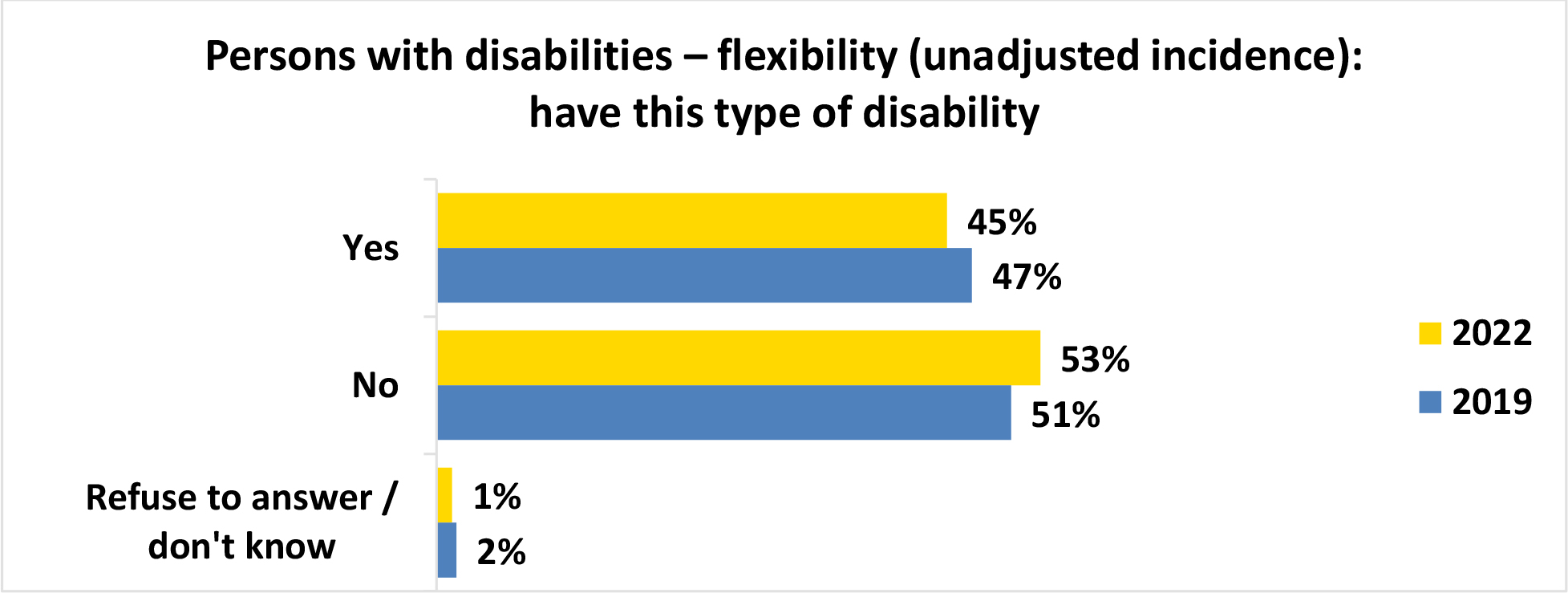
A horizontal bar graph titled, Persons with disabilities flexibility open parenthesis unadjusted incidence close parenthesis have this type of disability
The values are as follows. Yes. 2022, 45 percent. 2019, 47 percent. No. 2022, 53 percent. 2019, 51 percent. Refuse to answer forward slash don’t know. 2022, 1 percent. 2019, 2 percent.
Figure 25: Persons with disabilities – flexibility: frequency of environment limiting inclusion in society
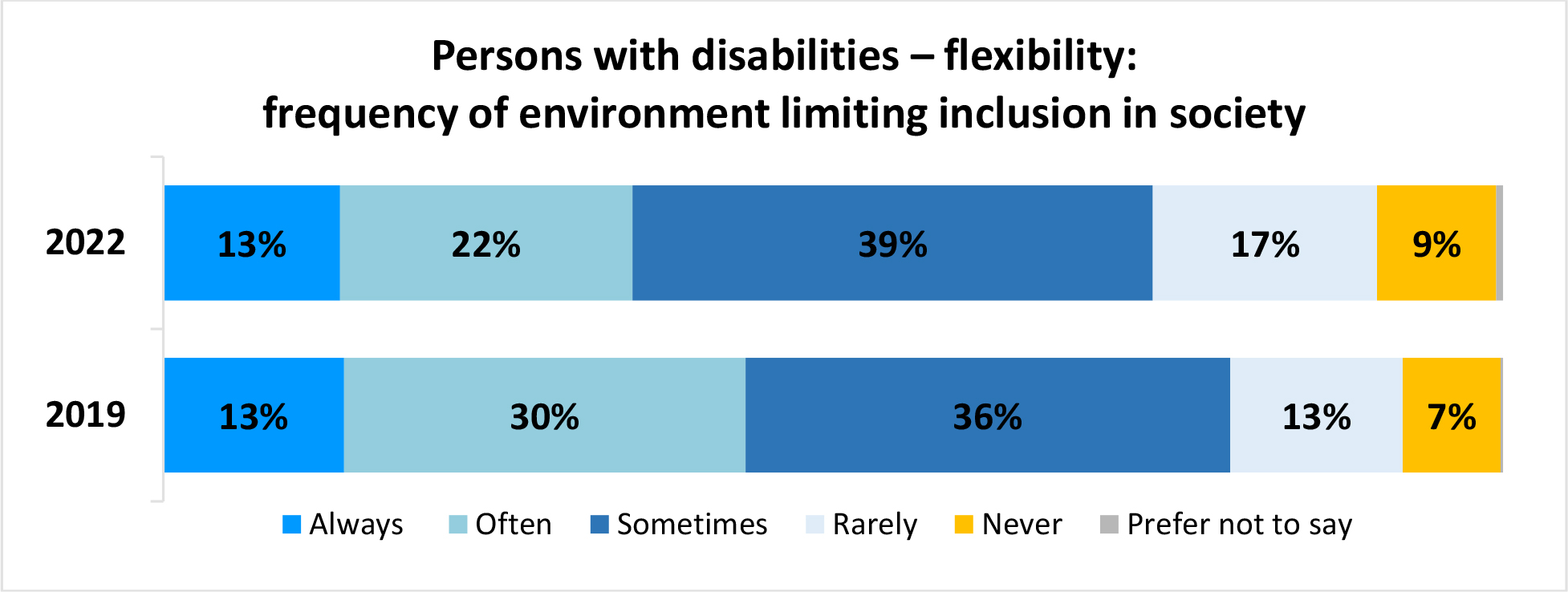
A horizontal bar graph titled, Persons with disabilities – flexibility: frequency of environment limiting inclusion in society
The values are as follows. 2022. Always, 13 percent. Often, 22 percent. Sometimes, 39 percent. Rarely, 17 percent. Never, 9 percent. 2019. Always, 13 percent. Often, 30 percent. Sometimes, 36 percent. Rarely, 13 percent. Never, 7 percent.
Figure 26: Persons with disabilities – flexibility: difficulty with disability
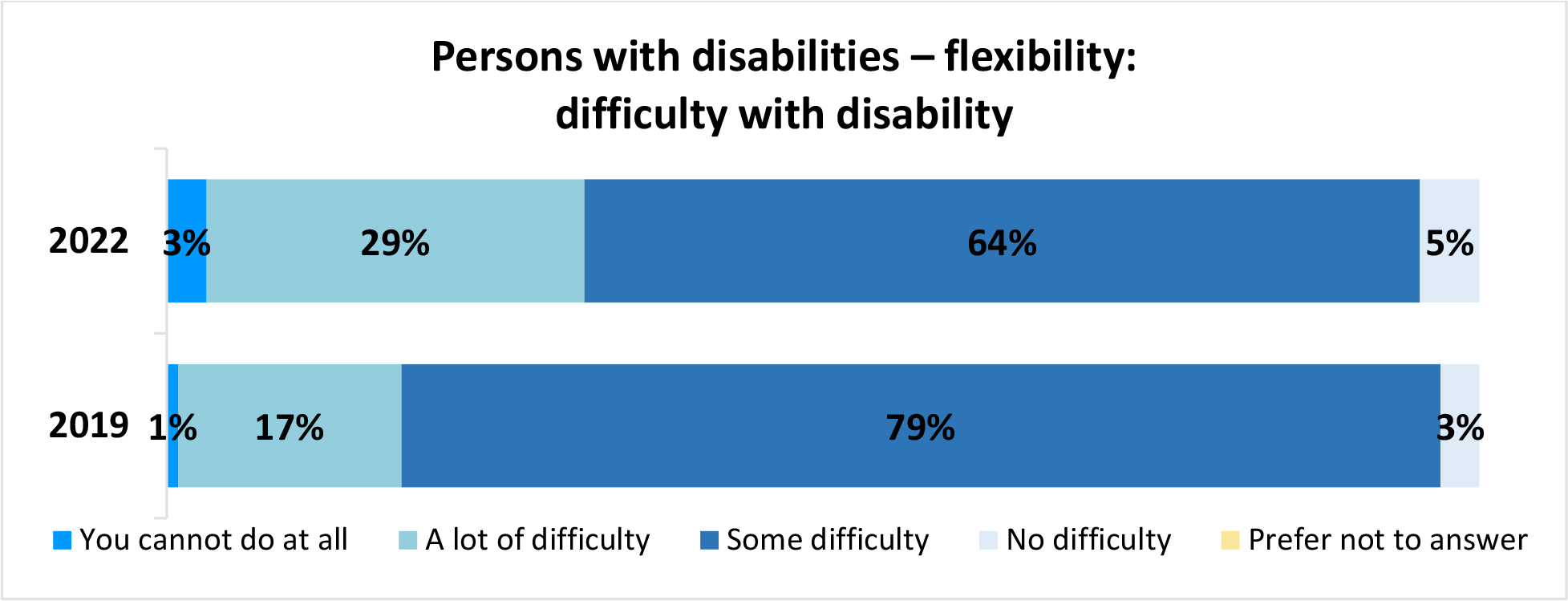
A horizontal bar graph titled, Persons with disabilities – flexibility: difficulty with disability
The values are as follows. 2022. You cannot do at all, 3 percent. A lot of difficulty, 29 percent. Some difficulty, 64 percent. No difficulty, 5 percent. 2019. You cannot do at all, 1 percent. A lot of difficulty, 17 percent. Some difficulty, 79 percent. No difficulty, 3 percent.
More than two in five participants (41%) had this disability once social inclusion and level of difficulty were factored in. Age seemed to have an impact on the incidence of this disability - the older respondents were, the more likely they were to say they have a flexibility disability. Respondents who were retired or not in the workforce were generally more likely to say they have this disability.
Figure 27: Persons with disabilities – flexibility (adjusted incidence): have this type of disability
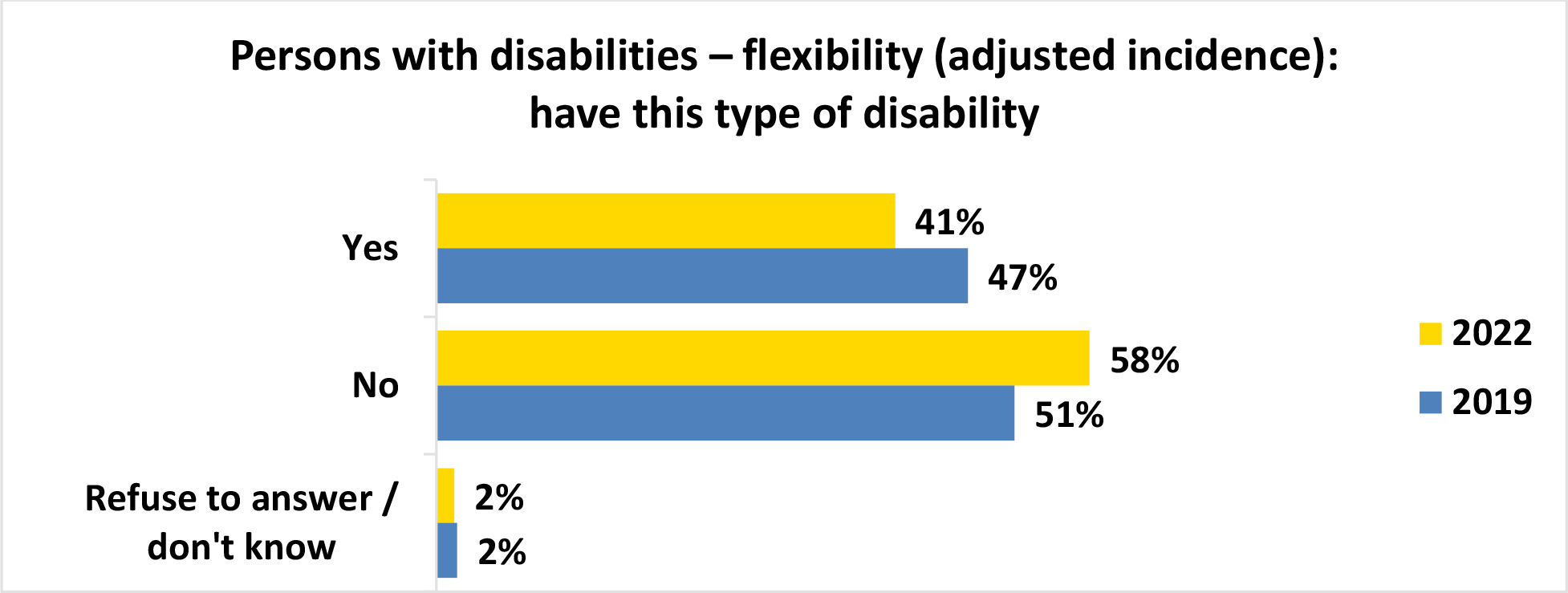
A horizontal bar graph titled, Persons with disabilities flexibility open parenthesis unadjusted incidence close parenthesis have this type of disability
The values are as follows. Yes. 2022, 41 percent. 2019, 47 percent. No. 2022, 58 percent. 2019, 51 percent. Refuse to answer forward slash don’t know. 2022, 2 percent. 2019, 2 percent.
Mental health-related disability
More than one third (36%) of survey respondents said they had a mental health-related disability, up slightly from results observed in 2019. This disability was described as “a mental illness that affects a person’s psychology or their behavior, in other words their ability to think, their emotions, and their behaviour”. More than four in five respondents (86%) said this disability “always”, “often”, or “sometimes” limited their inclusion in society. Among those who said this happens “rarely”, 91% said they have at least “some difficulty” with their mental health condition.
Figure 28: Persons with disabilities – mental health-related (unadjusted incidence): have this type of disability
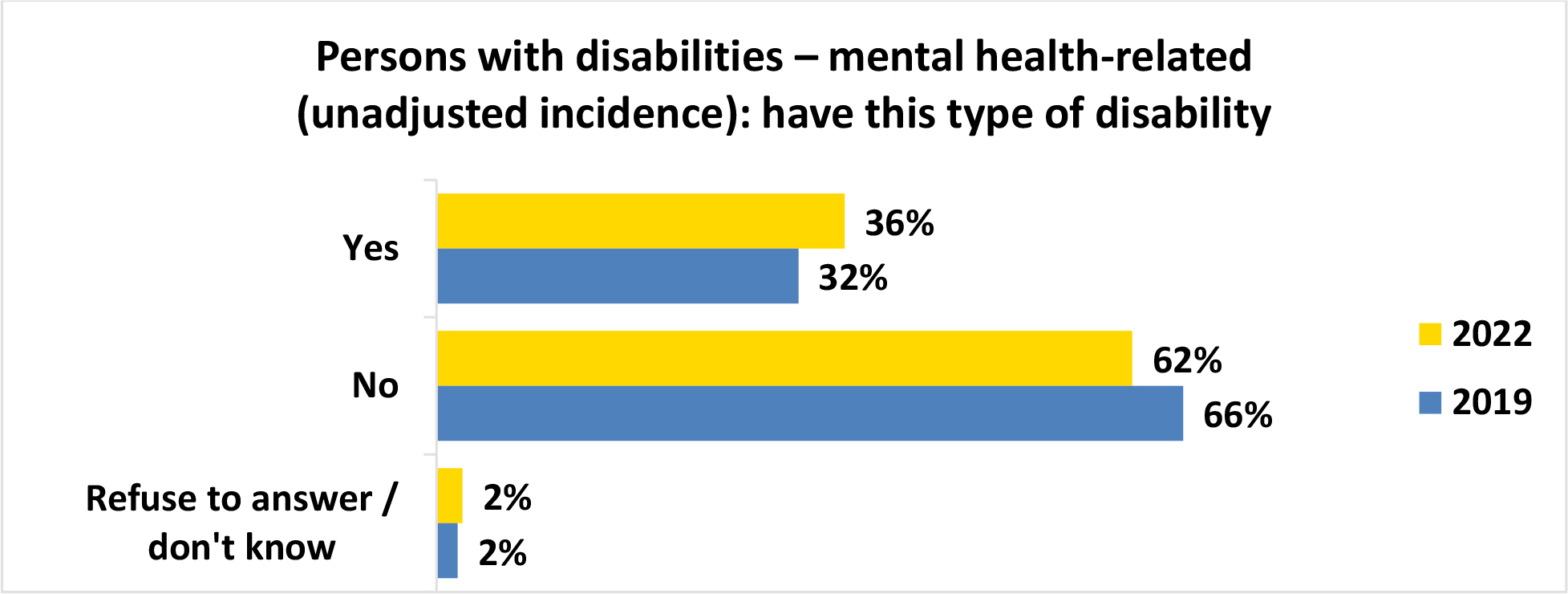
A horizontal bar graph titled, Persons with disabilities mental health related open parenthesis unadjusted incidence close parenthesis have this type of disability
The values are as follows. Yes. 2022, 36 percent. 2019, 32 percent. No. 2022, 62 percent. 2019, 66 percent. Refuse to answer forward slash don’t know. 2022, 2 percent. 2019, 2 percent.
Figure 29: Persons with disabilities – mental health-related: frequency of environment limiting inclusion in society
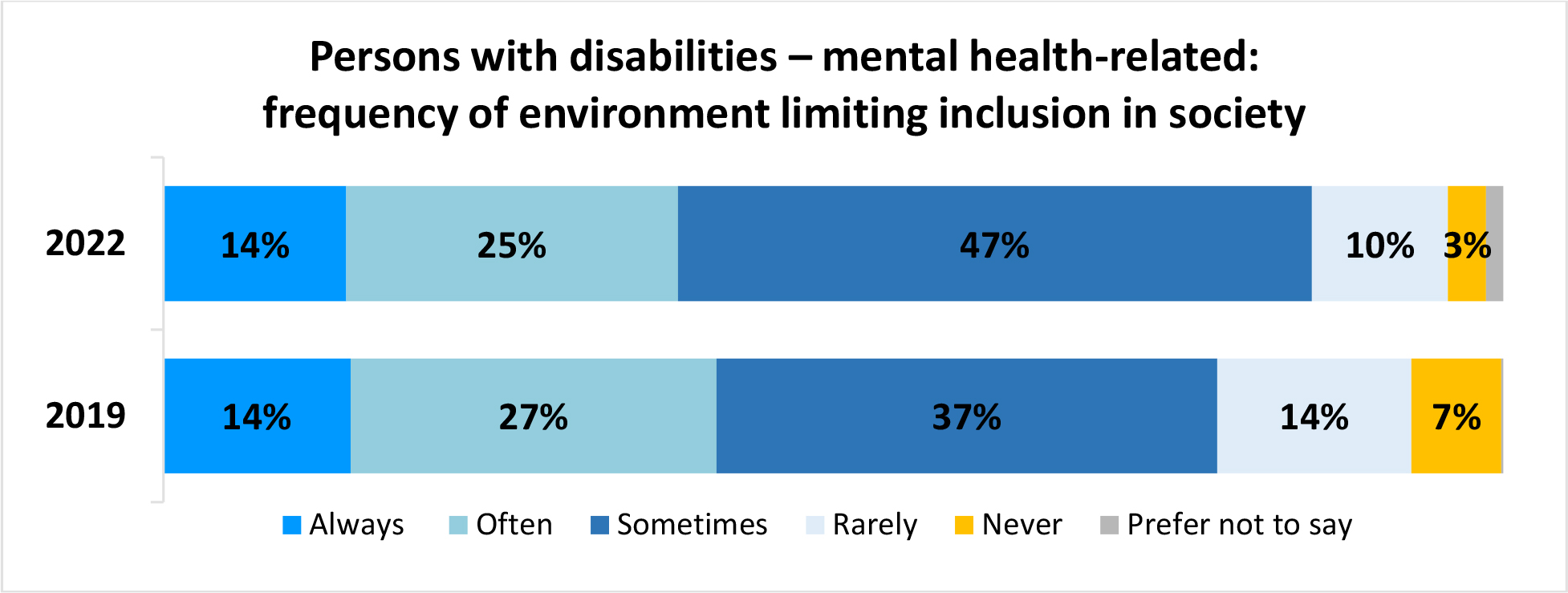
A horizontal bar graph titled, Persons with disabilities – mental health related: frequency of environment limiting inclusion in society
The values are as follows. 2022. Always, 14 percent. Often, 25 percent. Sometimes, 47 percent. Rarely, 10 percent. Never, 3 percent. Prefer not to say, 1 percent. 2019. Always, 14 percent. Often, 27 percent. Sometimes, 37 percent. Rarely, 14 percent. Never, 7 percent.
Figure 30: Persons with disabilities – mental health-related: difficulty with disability
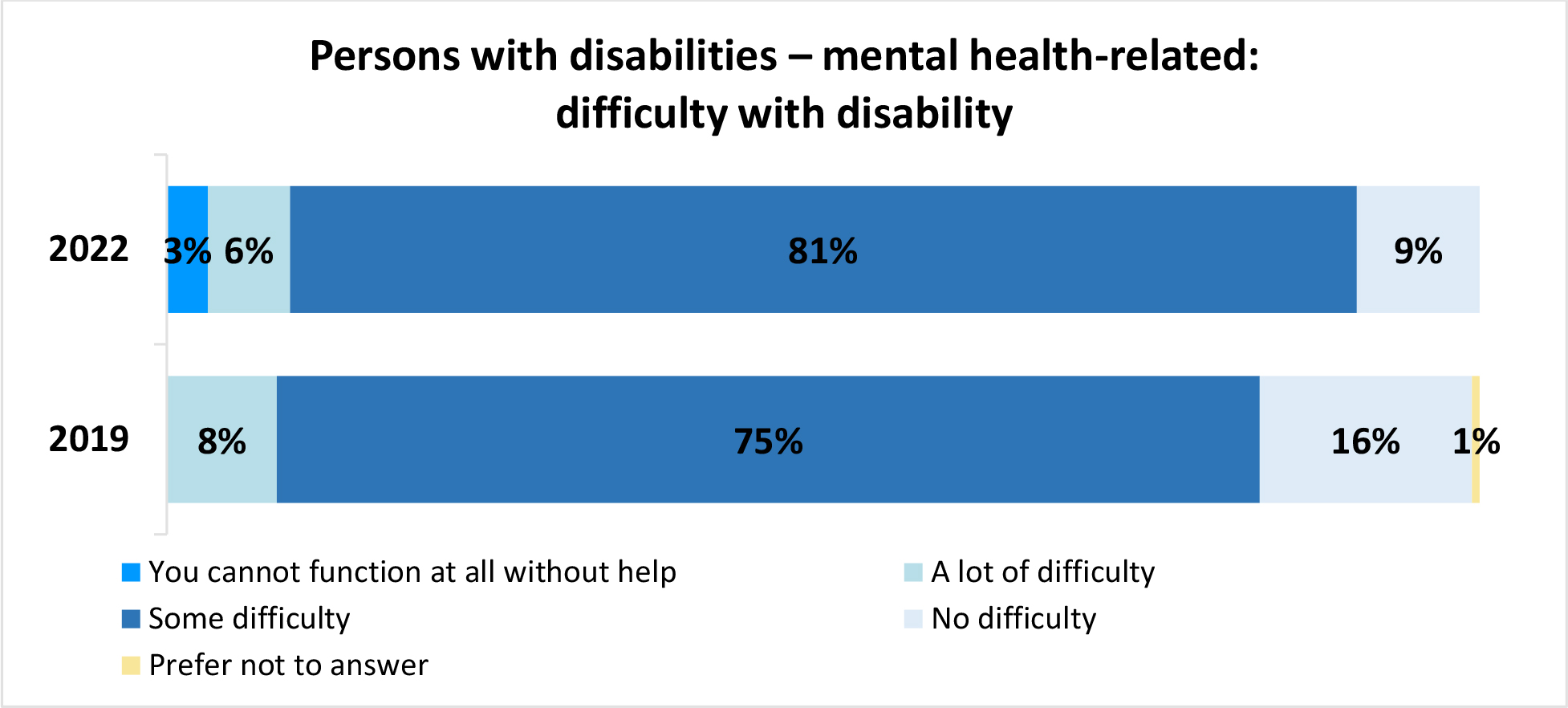
A horizontal bar graph titled, Persons with disabilities – mental health related: difficulty with disability
The values are as follows. 2022. You cannot function at all without help, 3 percent. A lot of difficulty, 6 percent. Some difficulty, 81 percent. No difficulty, 9 percent. 2019. A lot of difficulty, 8 percent. Some difficulty, 75 percent. No difficulty, 16 percent. Prefer not to say, 1 percent.
Accounting for the adjusted incidence for a mental health disability, more than one in three (34%) respondents had this disability. The younger the age of the respondent, the higher the incidence of this disability. This also seemed to affect more women than men. Those that are a member of the LGBTQ2+ community tended to be affected to a greater extent than those who are not. Respondents with lower household incomes tended to have a higher incidence of this disability.
Figure 31: Persons with disabilities – mental health-related (adjusted incidence): have this type of disability
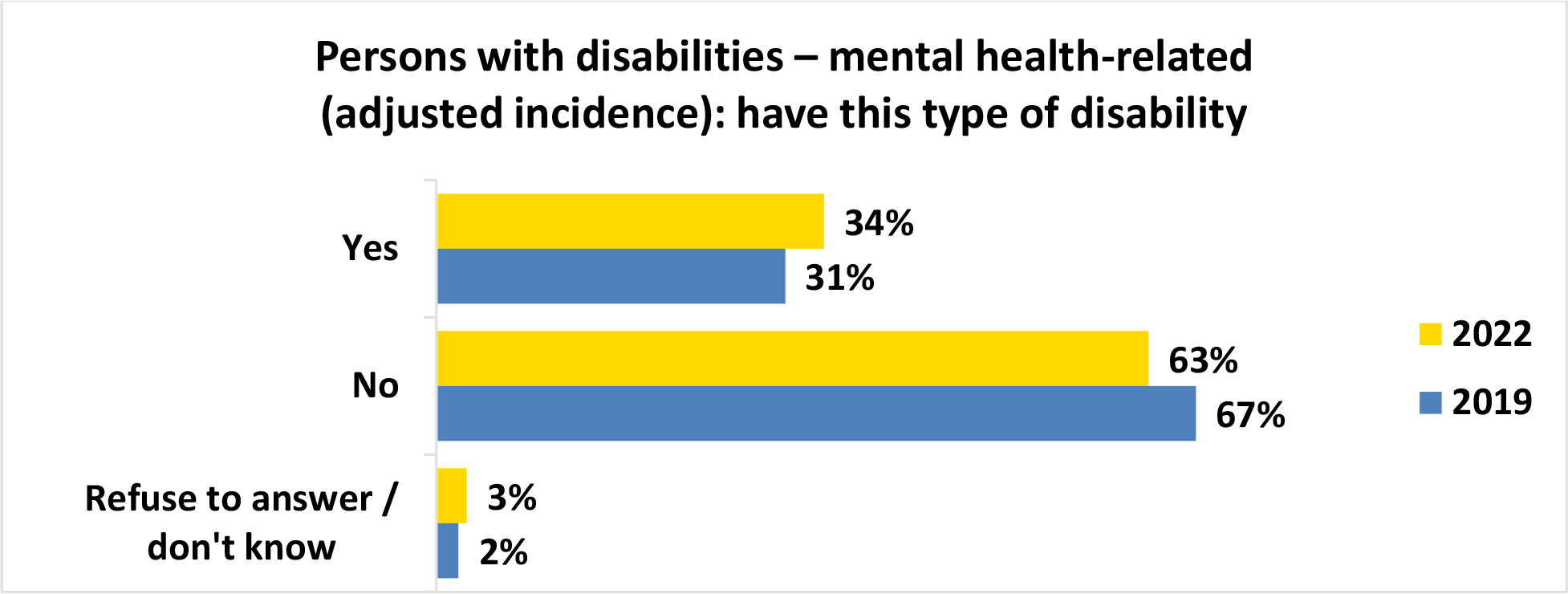
A horizontal bar graph titled, Persons with disabilities mental health related open parenthesis unadjusted incidence close parenthesis have this type of disability
The values are as follows. Yes. 2022, 34 percent. 2019, 31 percent. No. 2022, 63 percent. 2019, 67 percent. Refuse to answer forward slash don’t know. 2022, 3 percent. 2019, 2 percent.
Seeing disability
A third of respondents (33%) said they had a disability related to seeing. This disability was described as “a visual impairment that affects a person’s ability to see, even when wearing glasses or contact lenses”. Over three in five of these respondents (64%) said this disability “always”, “often”, or “sometimes” limited their inclusion in society. Among those who said this happens “rarely”, 84% said they have at least “some difficulty” seeing, even when wearing glasses or contact lenses.
Figure 32: Persons with disabilities – seeing (unadjusted incidence): have this type of disability
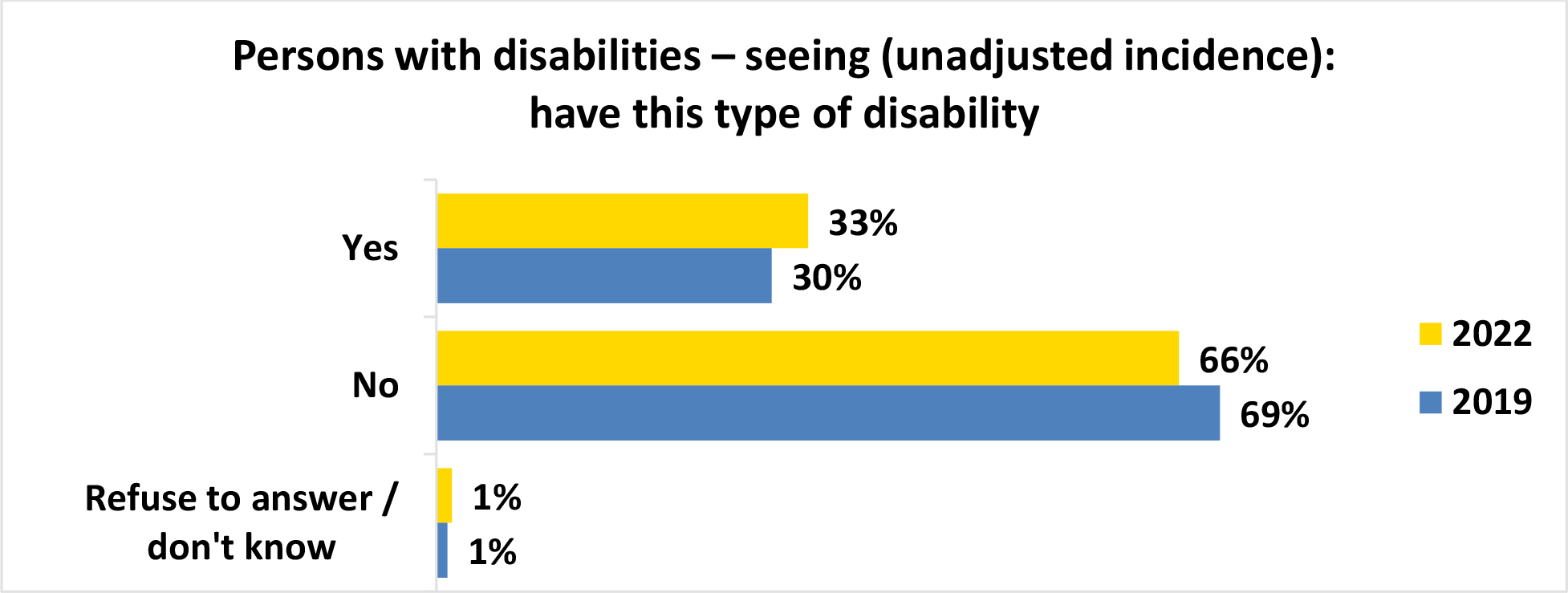
A horizontal bar graph titled, Persons with disabilities seeing open parenthesis unadjusted incidence close parenthesis have this type of disability
The values are as follows. Yes. 2022, 33 percent. 2019, 30 percent. No. 2022, 66 percent. 2019, 69 percent. Refuse to answer forward slash don’t know. 2022, 1 percent. 2019, 1 percent.
Figure 33: Persons with disabilities – seeing: frequency of environment limiting inclusion in society
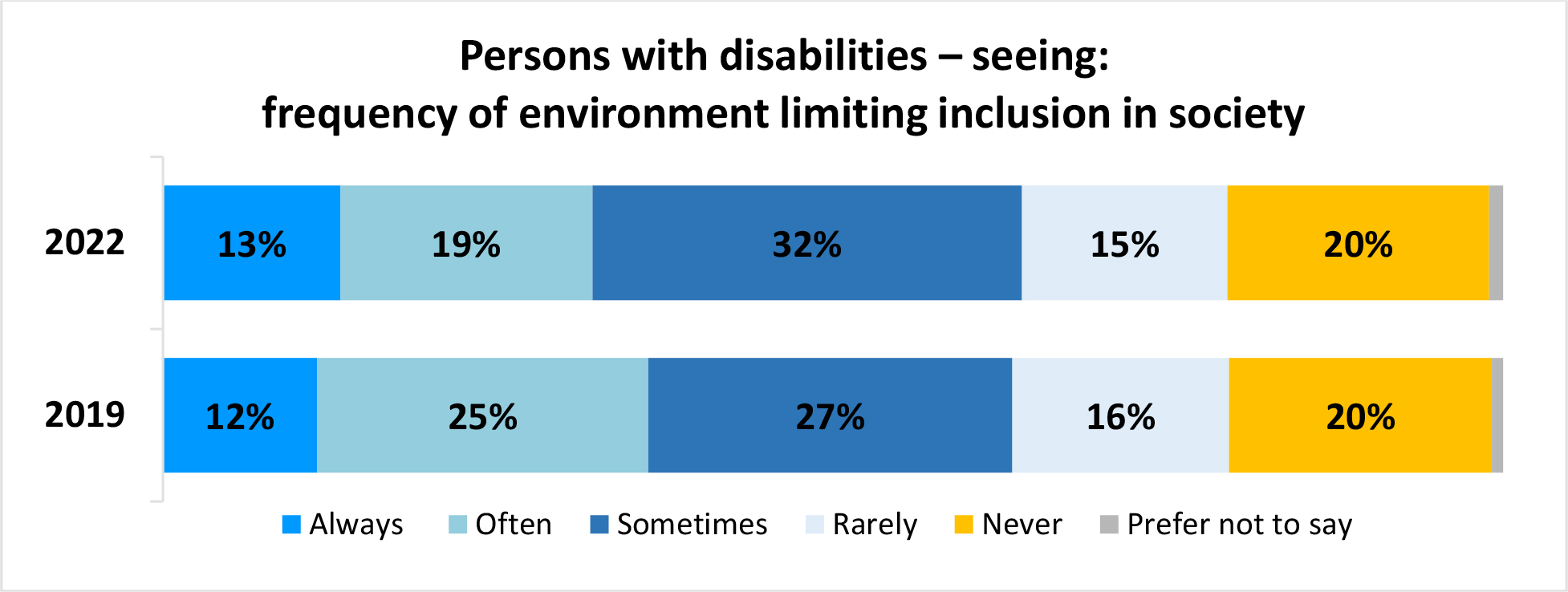
A horizontal bar graph titled, Persons with disabilities – seeing: frequency of environment limiting inclusion in society
The values are as follows. 2022. Always, 13 percent. Often, 19 percent. Sometimes, 32 percent. Rarely, 15 percent. Never, 20 percent. Prefer not to say, 1 percent. 2019. Always, 12 percent. Often, 25 percent. Sometimes, 27 percent. Rarely, 16 percent. Never, 20 percent. Prefer not to say, 1 percent.
Figure 34: Persons with disabilities – seeing: difficulty with disability
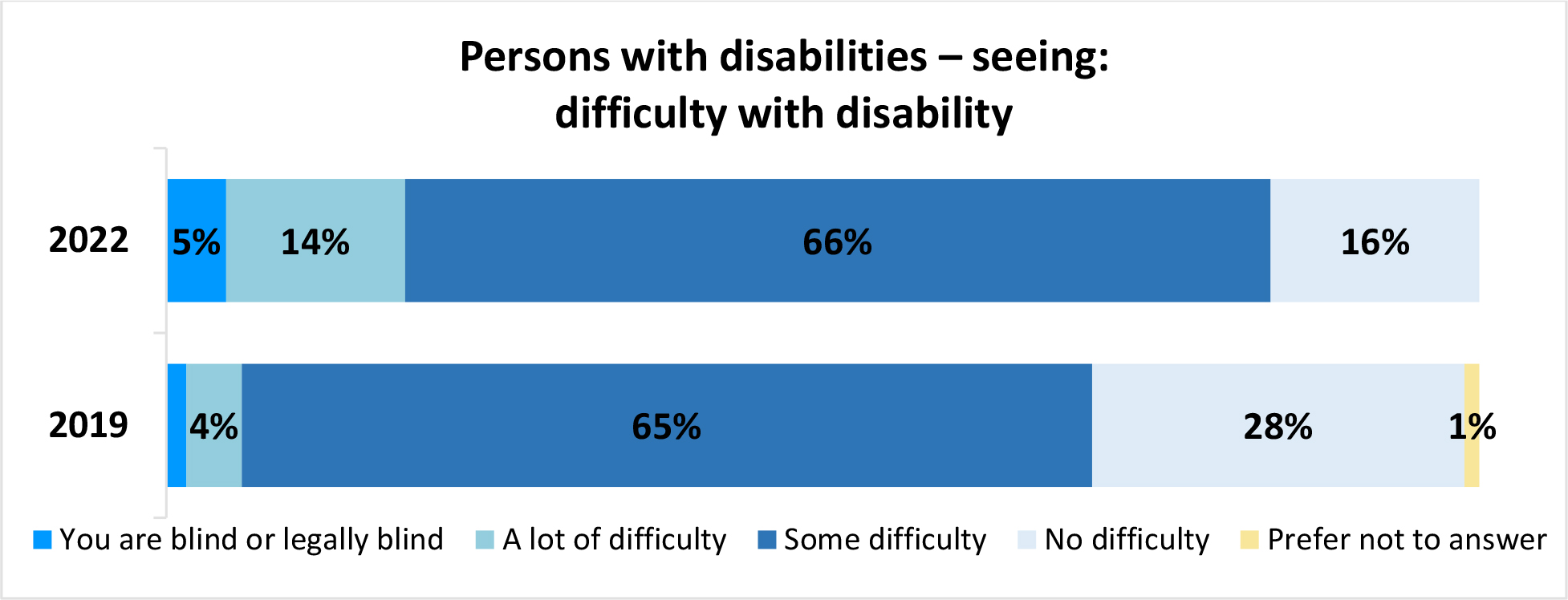
A horizontal bar graph titled, Persons with disabilities – seeing: difficulty with disability
The values are as follows. 2022. You are blind or legally blind, 5 percent. A lot of difficulty, 14 percent. Some difficulty, 66 percent. No difficulty, 16 percent. 2019. You are blind or legally blind, 1 percent. A lot of difficulty, 4 percent. Some difficulty, 65 percent. No difficulty, 28 percent. Prefer not to say, 1 percent.
Once the incidence was adjusted, a quarter of respondents (25%) had a seeing disability. As age increased, tendency to report a seeing disability increased. From a regional perspective, a seeing disability was more common in Quebec. Respondents with a household income of less than $80,000 more commonly had a seeing disability compared to those with a higher income.
Figure 35: Persons with disabilities – seeing (adjusted incidence): have this type of disability
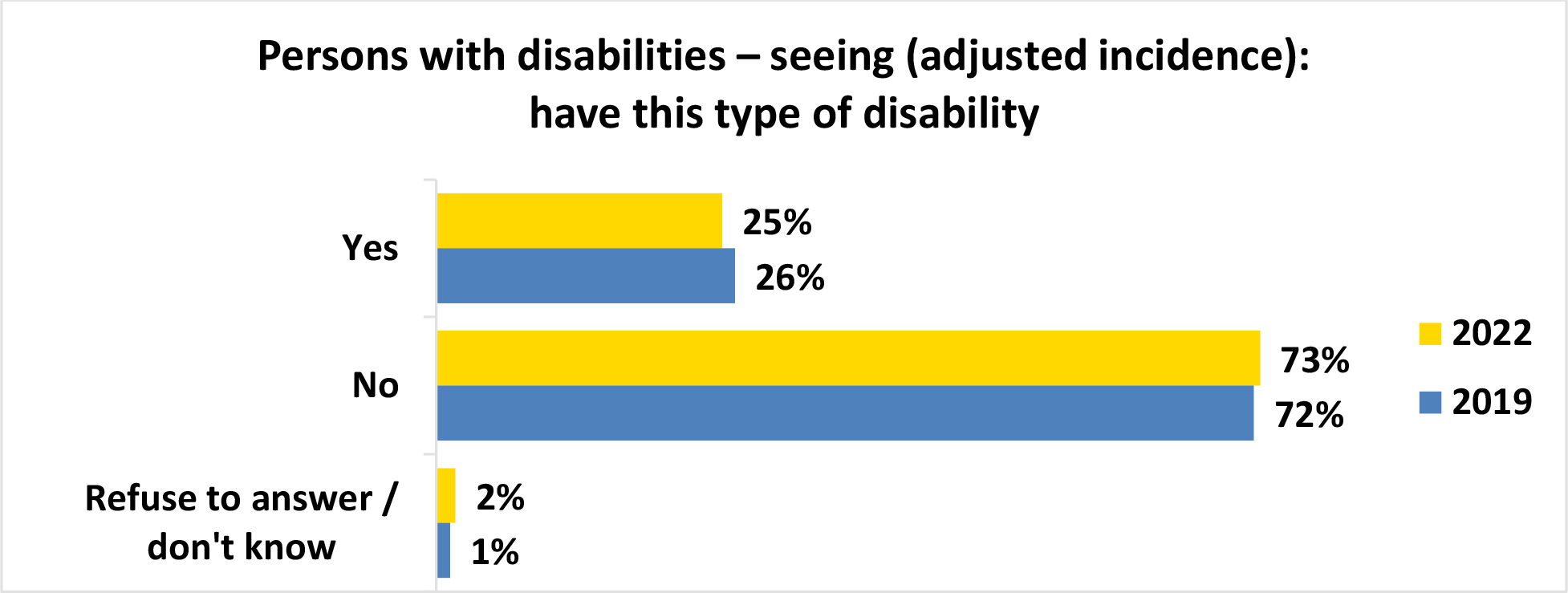
A horizontal bar graph titled, Persons with disabilities seeing open parenthesis unadjusted incidence close parenthesis have this type of disability
The values are as follows. Yes. 2022, 25 percent. 2019, 26 percent. No. 2022, 73 percent. 2019, 72 percent. Refuse to answer forward slash don’t know. 2022, 2 percent. 2019, 1 percent.
Dexterity disability
Nearly one third (31%) of survey respondents said they had a dexterity disability, down slightly from the previous wave. This disability was described as “a physical disability that affects a person’s ability to do tasks, especially with their hands”. Over four in five of these respondents (81%) said this disability “always”, “often”, or “sometimes” limited their inclusion in society. Among those who said this happens “rarely”, 83% said they have at least “some difficulty” grasping small objects.
Figure 36: Persons with disabilities – dexterity (unadjusted incidence): have this type of disability
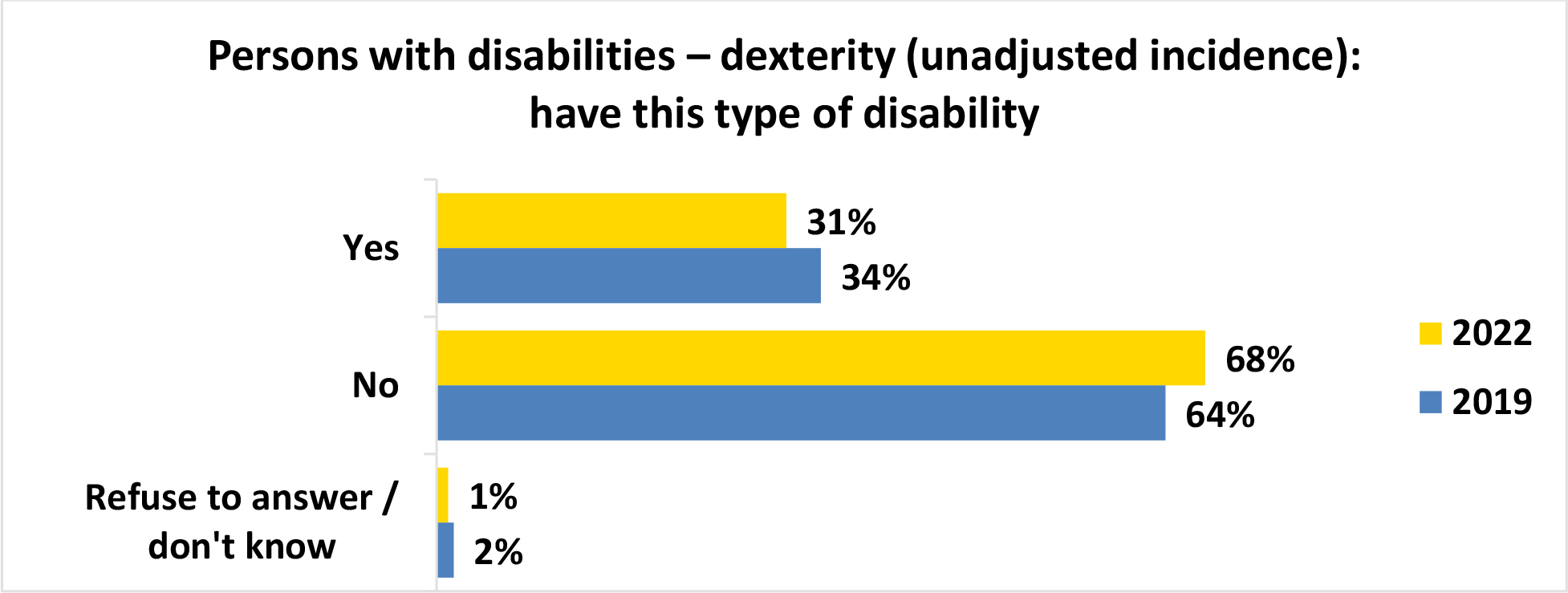
A horizontal bar graph titled, Persons with disabilities dexterity open parenthesis unadjusted incidence close parenthesis have this type of disability
The values are as follows. Yes. 2022, 31 percent. 2019, 34 percent. No. 2022, 68 percent. 2019, 64 percent. Refuse to answer forward slash don’t know. 2022, 1 percent. 2019, 2 percent.
Figure 37: Persons with disabilities – dexterity: frequency of environment limiting inclusion in society
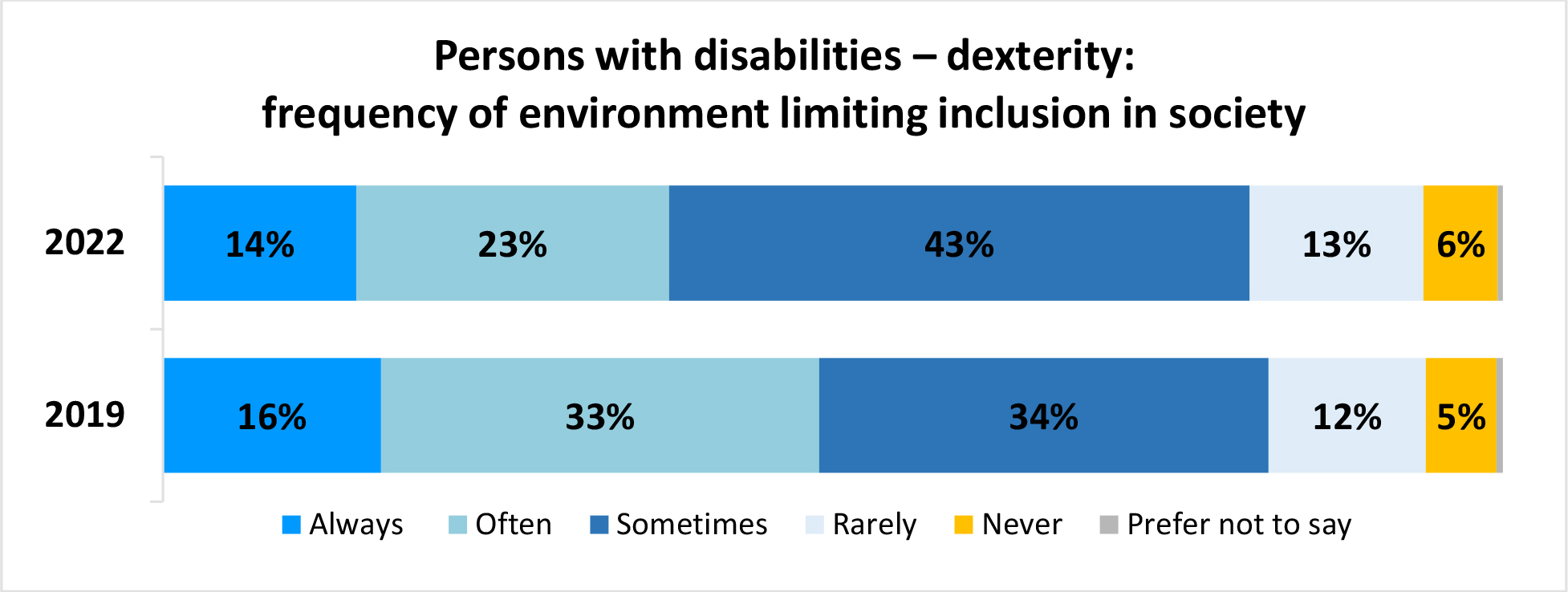
A horizontal bar graph titled, Persons with disabilities – dexterity: frequency of environment limiting inclusion in society
The values are as follows. 2022. Always, 14 percent. Often, 23 percent. Sometimes, 43 percent. Rarely, 13 percent. Never, 6percent. 2019. Always, 16 percent. Often, 33 percent. Sometimes, 34 percent. Rarely, 12 percent. Never, 5 percent.
Figure 38: Persons with disabilities – dexterity: difficulty with disability
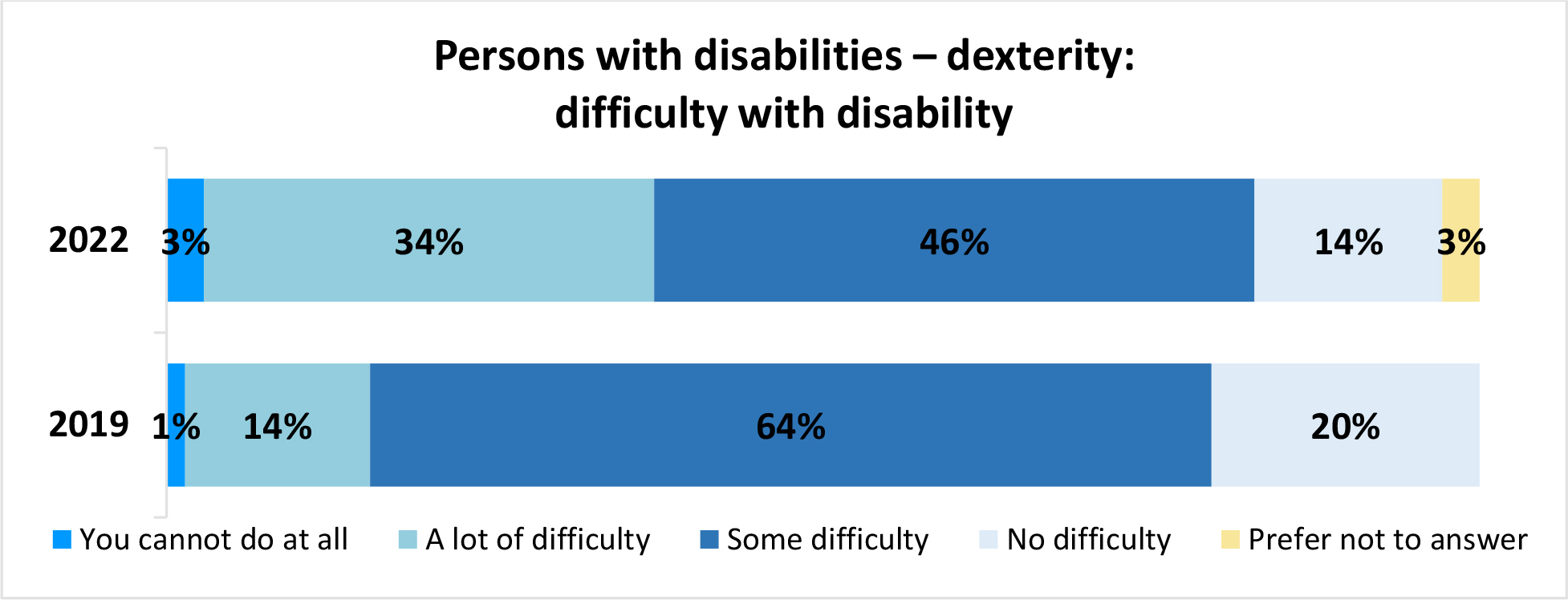
A horizontal bar graph titled, Persons with disabilities – dexterity: difficulty with disability
The values are as follows. 2022. You cannot do at all, 3 percent. A lot of difficulty, 34 percent. Some difficulty, 46 percent. No difficulty, 14 percent. Prefer not to say, 3percent. 2019. You cannot do at all, 1 percent. A lot of difficulty, 14 percent. Some difficulty, 64 percent. No difficulty, 20 percent.
Once the incidence was adjusted for this disability, 28% of participants had this disability in 2022. Respondents with lower household incomes tended to have a higher incidence of this disability. The province with the highest proportion of respondents with this disability was Quebec.
Figure 39: Persons with disabilities – dexterity (adjusted incidence): have this type of disability
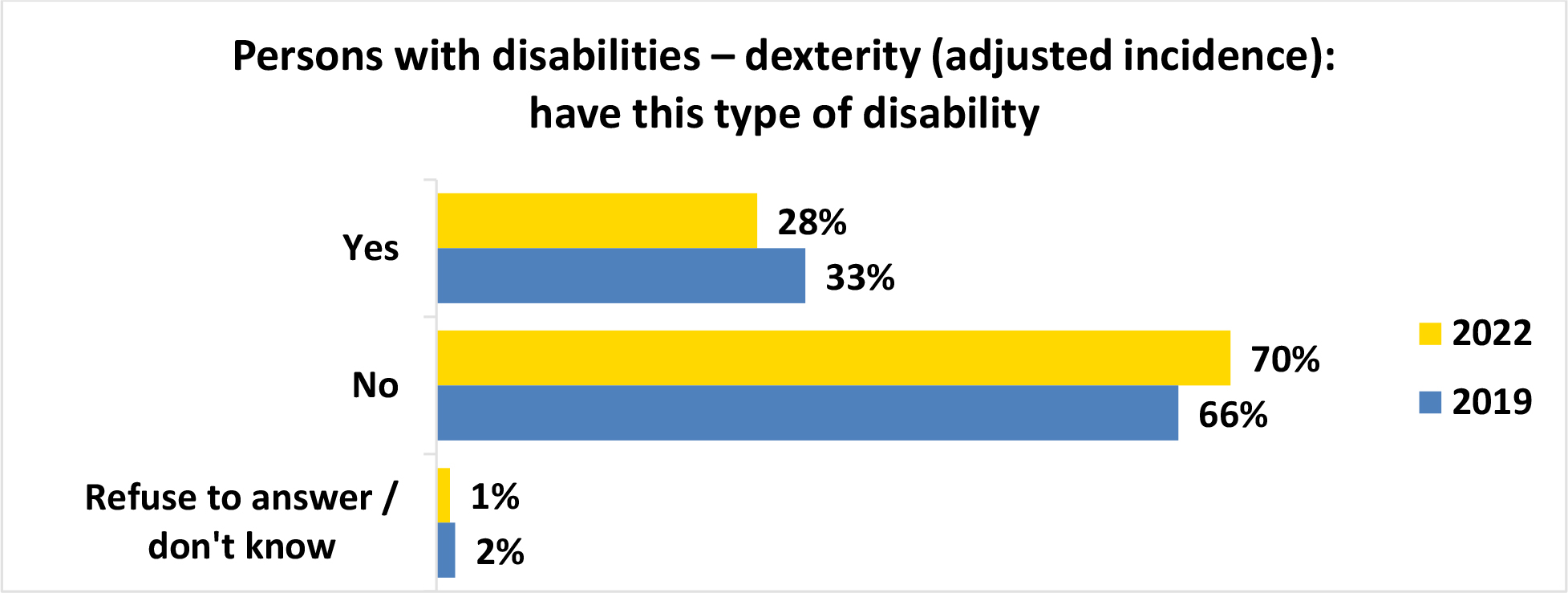
A horizontal bar graph titled, Persons with disabilities dexterity open parenthesis unadjusted incidence close parenthesis have this type of disability
The values are as follows. Yes. 2022, 28 percent. 2019, 33 percent. No. 2022, 70 percent. 2019, 66 percent. Refuse to answer forward slash don’t know. 2022, 1 percent. 2019, 2 percent.
Memory disability
Over one quarter (29%) of survey respondents said they had a memory disability, remaining consistent with results observed in the previous quarter. This disability was described as “a memory disorder that affects a person’s ability to remember information”. Over four in five of these respondents (83%) said this disability “always”, “often”, or “sometimes” limited their inclusion in society. Among those who said this happens “rarely”, 86% said they have at least “some difficulty” with their memory.
Figure 40: Persons with disabilities – memory (unadjusted incidence): have this type of disability
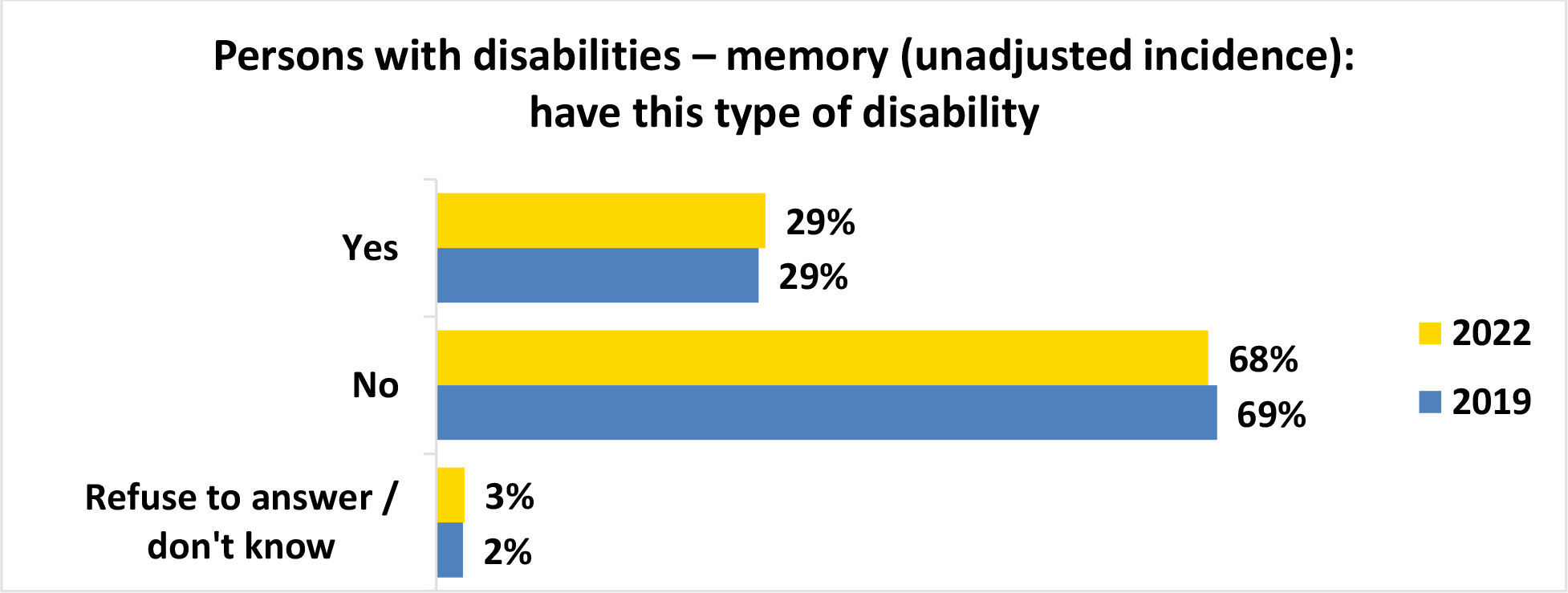
A horizontal bar graph titled, Persons with disabilities memory open parenthesis unadjusted incidence close parenthesis have this type of disability
The values are as follows. Yes. 2022, 29 percent. 2019, 29 percent. No. 2022, 68 percent. 2019, 69 percent. Refuse to answer forward slash don’t know. 2022, 3 percent. 2019, 2 percent.
Figure 41: Persons with disabilities – memory: frequency of environment limiting inclusion in society
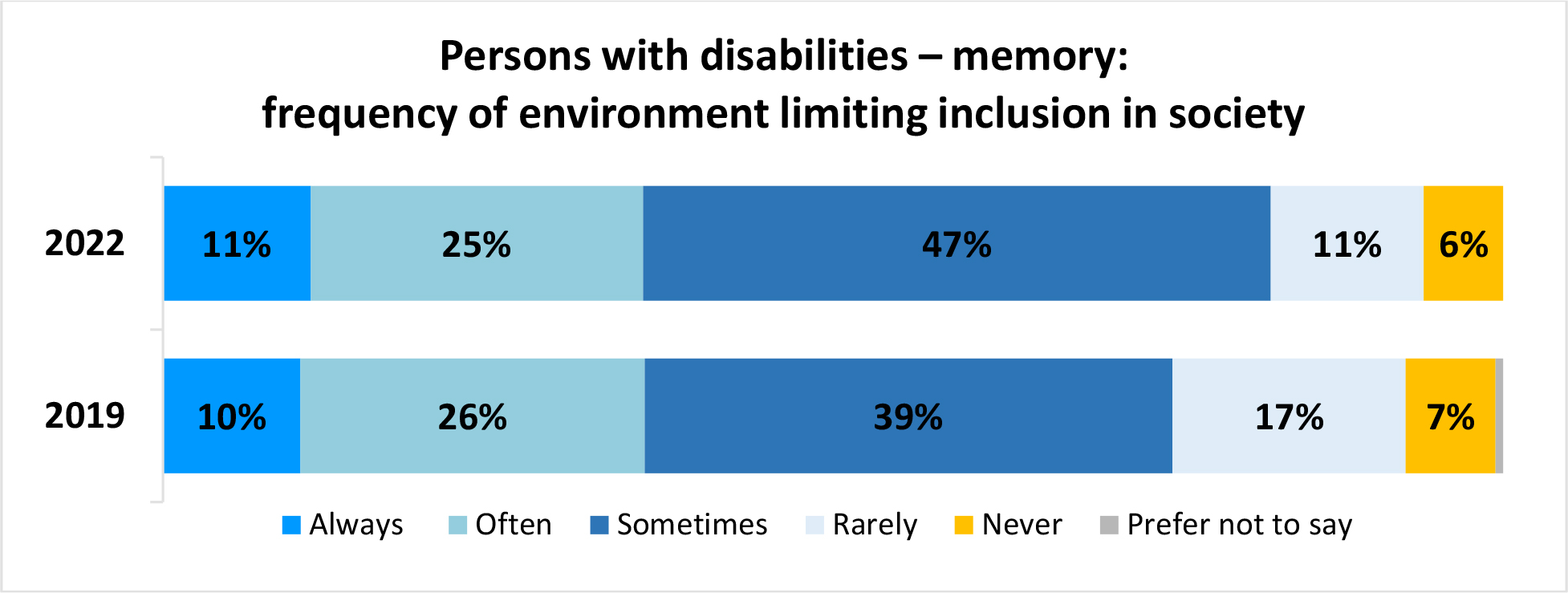
A horizontal bar graph titled, Persons with disabilities – memory: frequency of environment limiting inclusion in society
The values are as follows. 2022. Always, 11 percent. Often, 25 percent. Sometimes, 47 percent. Rarely, 11 percent. Never, 6 percent. 2019. Always, 10 percent. Often, 26 percent. Sometimes, 39 percent. Rarely, 17 percent. Never, 7percent.
Figure 42: Persons with disabilities – memory: difficulty with disability
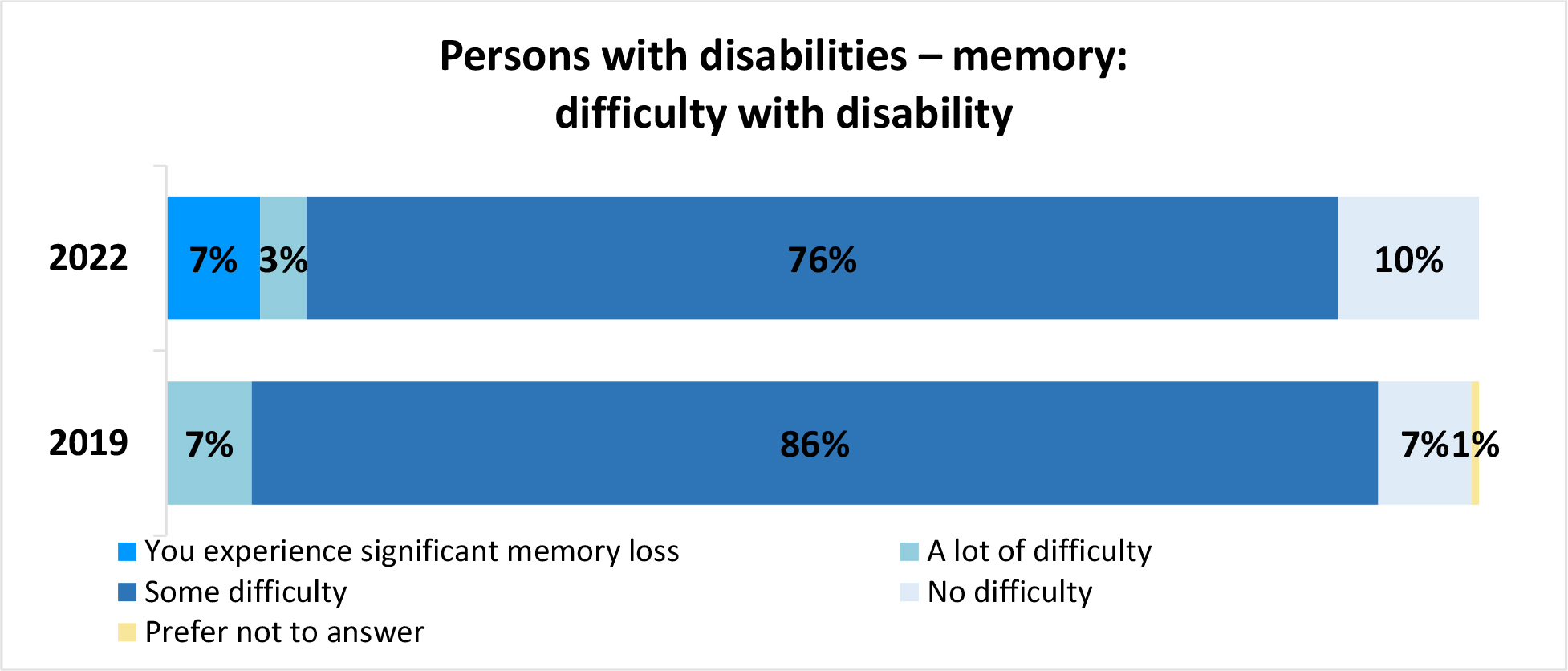
A horizontal bar graph titled, Persons with disabilities – memory: difficulty with disability
The values are as follows. 2022. You experience significant memory loss, 7 percent. A lot of difficulty, 3 percent. Some difficulty, 76 percent. No difficulty, 10 percent. 2019. A lot of difficulty, 7 percent. Some difficulty, 86 percent. No difficulty, 7 percent. Prefer not to answer, 1 percent.
Once the incidence was adjusted for this disability, 27% of respondents had a memory disability. As level of education decreased, the tendency to have a memory disability increased. Memory disabilities seemed to occur relatively more to respondents in Ontario, Manitoba, or Saskatchewan. As household income decreased, the incidence of a memory disability increased.
Figure 43: Persons with disabilities – memory (adjusted incidence): have this type of disability
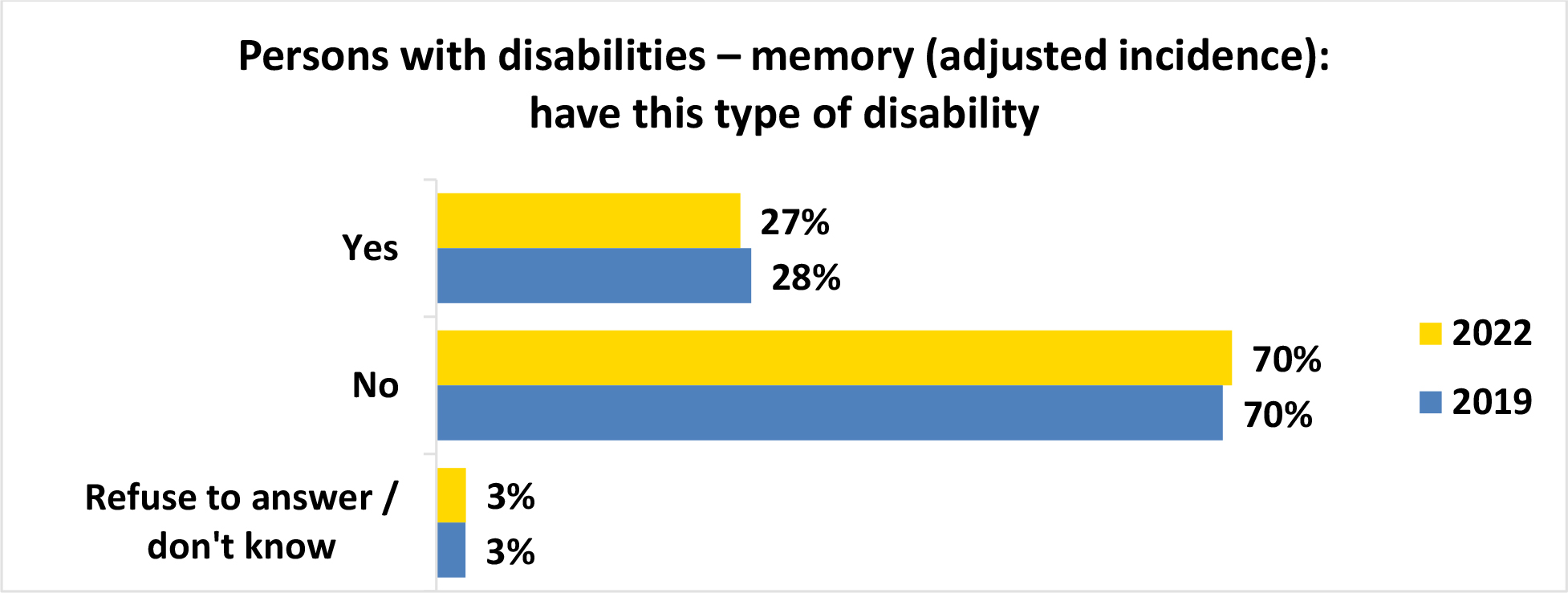
A horizontal bar graph titled, Persons with disabilities memory open parenthesis unadjusted incidence close parenthesis have this type of disability
The values are as follows. Yes. 2022, 27 percent. 2019, 28 percent. No. 2022, 70 percent. 2019, 70 percent. Refuse to answer forward slash don’t know. 2022, 3 percent. 2019, 3 percent.
Hearing disability
A quarter of respondents (25%) said they had a hearing disability, remaining consistent with the previous wave. This disability was described as “Deaf or Hard of Hearing - it affects a person’s ability to hear, even when using devices like a hearing aid or cochlear implants”. Over four in five of these respondents (82%) said this disability “always”, “often”, or “sometimes” limited their inclusion in society. Among those who said this happens “rarely”, 76% said they have at least “some difficulty” hearing, even when using a hearing aid.
Figure 44: Persons with disabilities – hearing (unadjusted incidence): have this type of disability
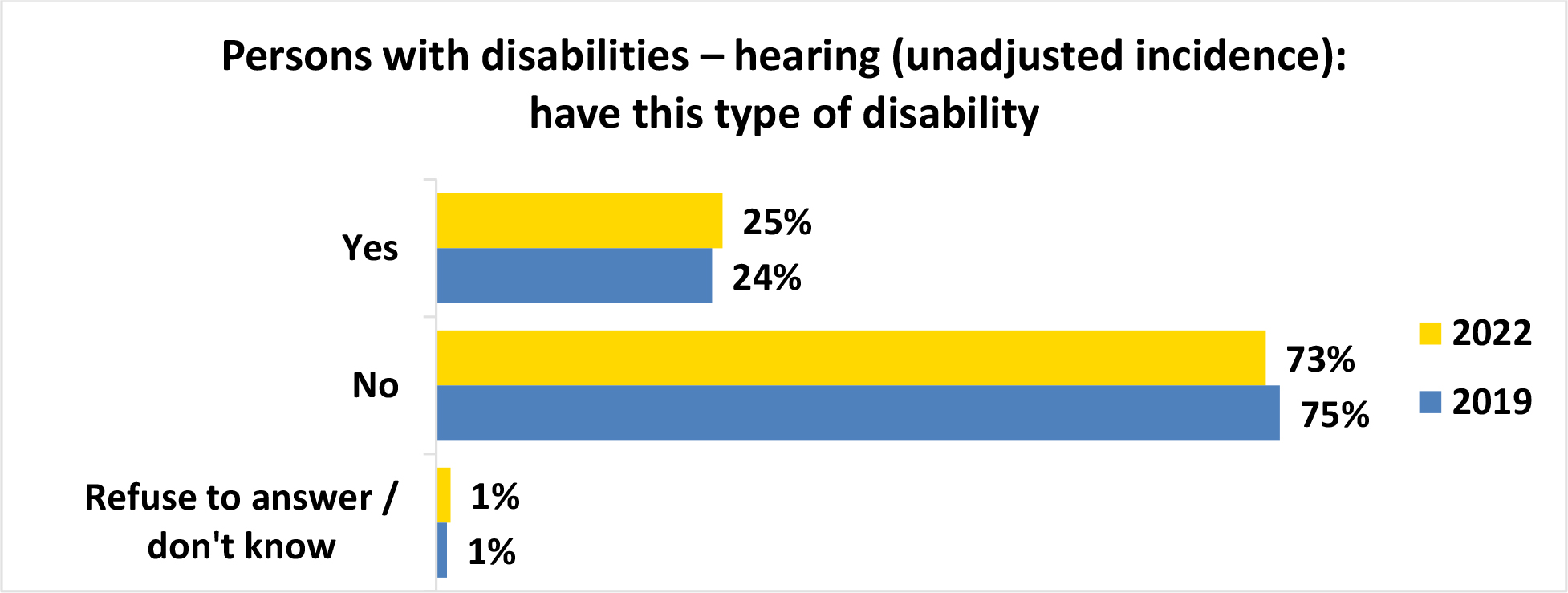
A horizontal bar graph titled, Persons with disabilities hearing open parenthesis unadjusted incidence close parenthesis have this type of disability
The values are as follows. Yes. 2022, 25 percent. 2019, 24 percent. No. 2022, 73 percent. 2019, 75 percent. Refuse to answer forward slash don’t know. 2022, 1 percent. 2019, 1 percent.
Figure 45: Persons with disabilities – hearing: frequency of environment limiting inclusion in society
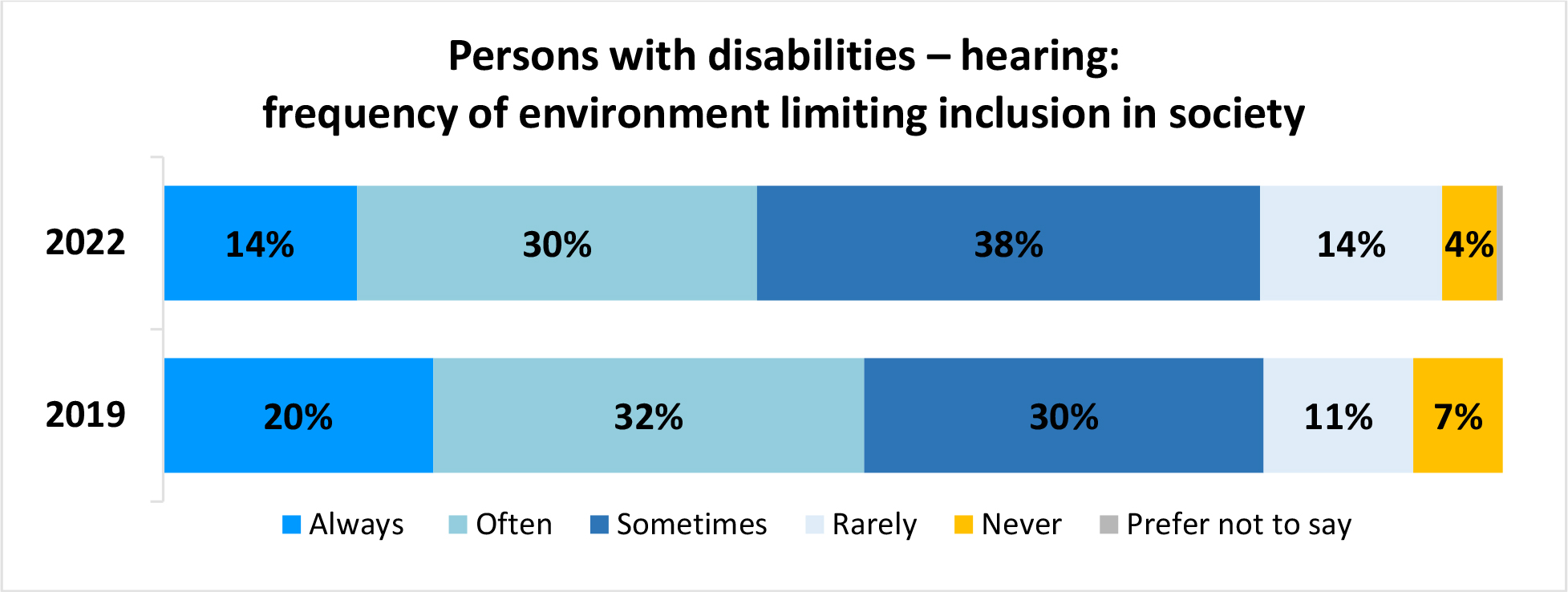
A horizontal bar graph titled, Persons with disabilities – hearing: frequency of environment limiting inclusion in society
The values are as follows. 2022. Always, 14 percent. Often, 30 percent. Sometimes, 38 percent. Rarely, 14 percent. Never, 4 percent. 2019. Always, 20 percent. Often, 32 percent. Sometimes, 30 percent. Rarely, 11 percent. Never, 7 percent.
Figure 46: Persons with disabilities – hearing: difficulty with disability
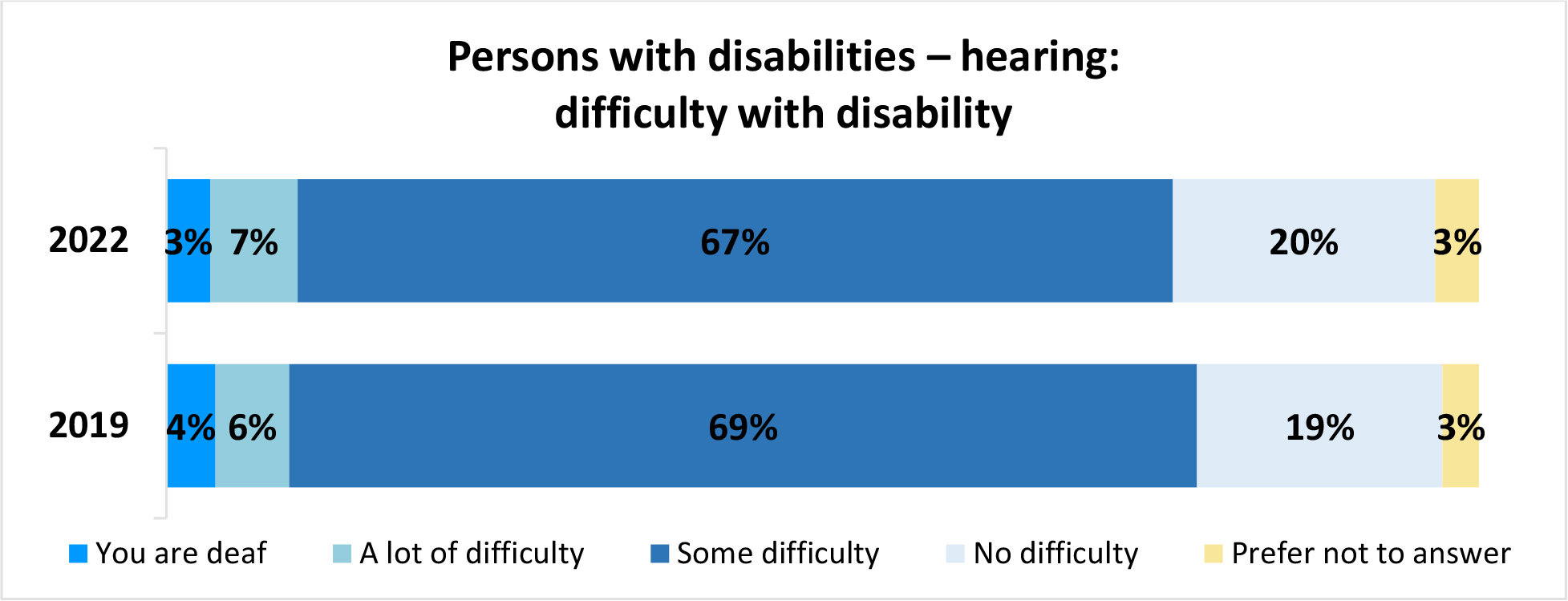
A horizontal bar graph titled, Persons with disabilities – hearing: difficulty with disability
The values are as follows. 2022. You are deaf, 3 percent. A lot of difficulty, 7 percent. Some difficulty, 67 percent. No difficulty, 20 percent. Prefer not to answer, 3 percent. 2019. You are deaf, 4 percent. A lot of difficulty, 6 percent. Some difficulty, 69 percent. No difficulty, 19 percent. Prefer not to answer, 3 percent.
Once the incidence was adjusted, 23% of participants had a hearing disability. The older respondents were, the more they said they had a hearing disability. More men than women reported having this disability. Manitoba and Saskatchewan had the highest proportion of respondents with a hearing disability.
Figure 47: Persons with disabilities – hearing (adjusted incidence): have this type of disability
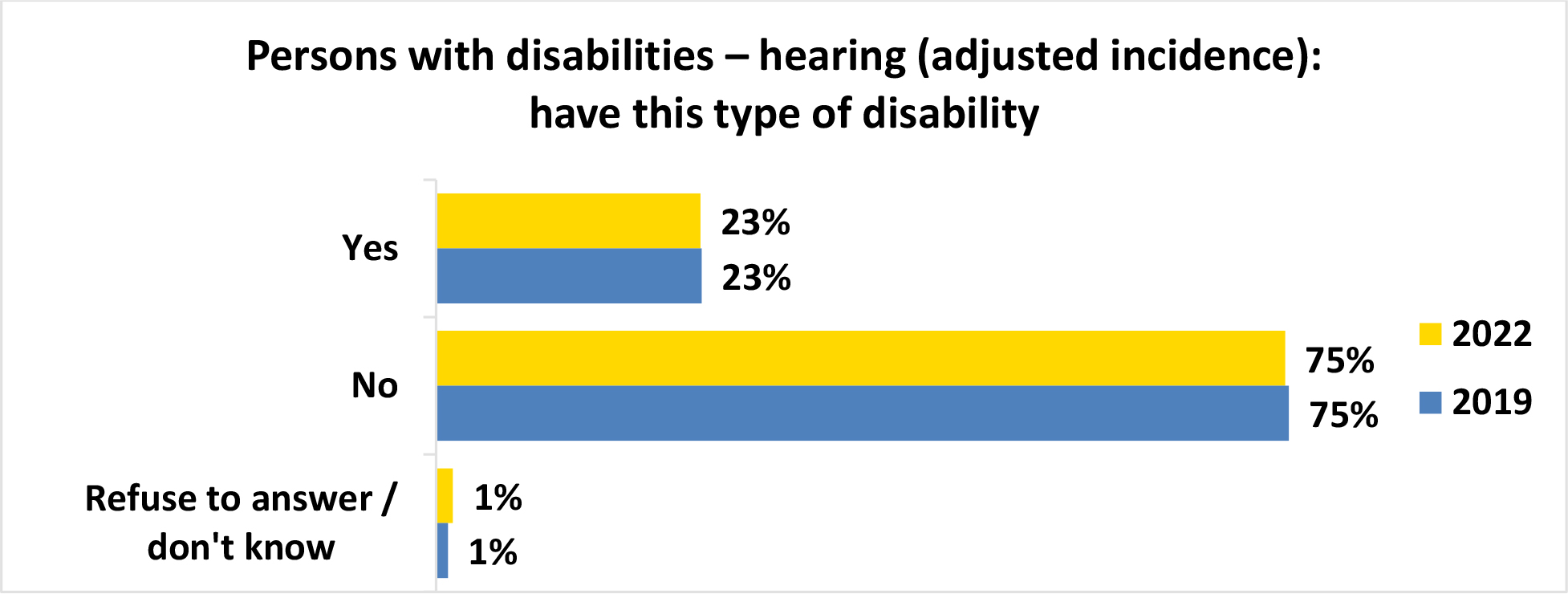
A horizontal bar graph titled, Persons with disabilities hearing open parenthesis unadjusted incidence close parenthesis have this type of disability
The values are as follows. Yes. 2022, 23 percent. 2019, 23 percent. No. 2022, 75 percent. 2019, 75 percent. Refuse to answer forward slash don’t know. 2022, 1 percent. 2019, 1 percent.
Learning disability
Nearly a quarter (24%) of survey respondents said they had a learning disability. This disability was described as one that “affects the way a person receives, understands, and uses information”. Over four in five of these respondents (86%) said this disability “always”, “often”, or “sometimes” limited their inclusion in society. Among those who said this happens “rarely”, 83% said they had at least “some difficulty” learning.
Figure 48: Persons with disabilities – learning (unadjusted incidence): have this type of disability
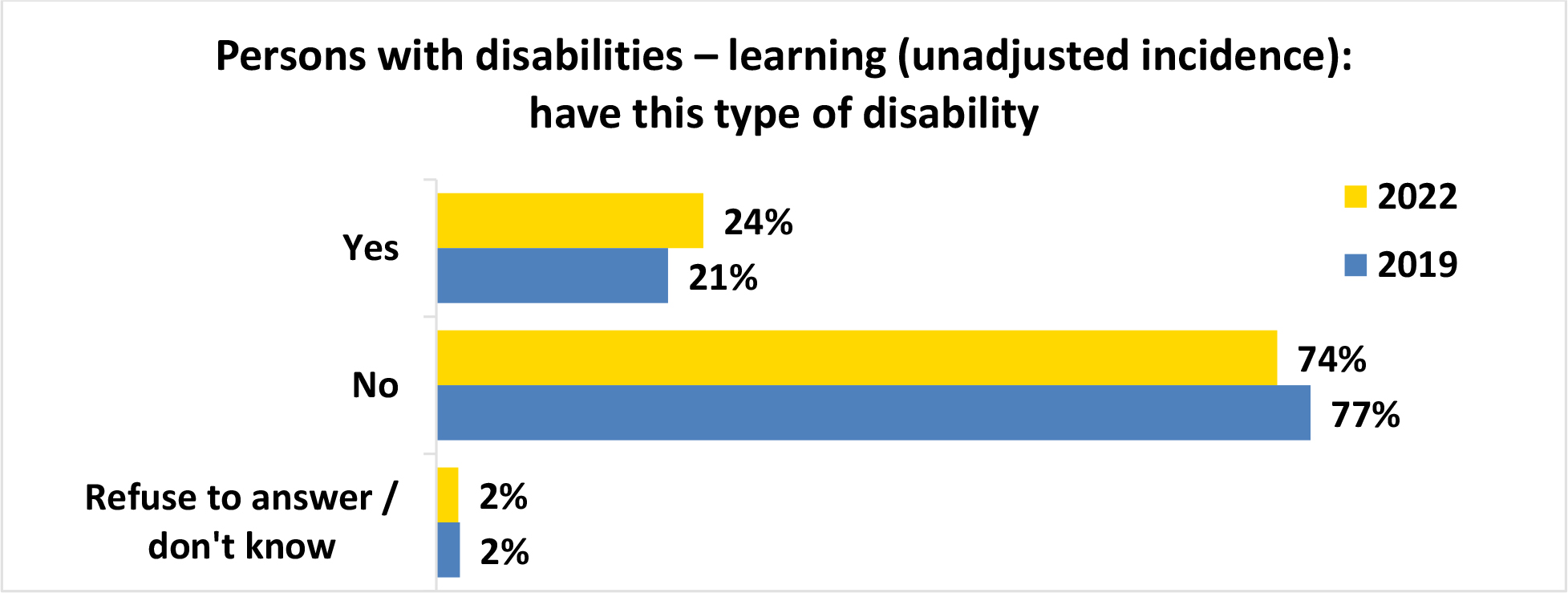
A horizontal bar graph titled, Persons with disabilities learning open parenthesis unadjusted incidence close parenthesis have this type of disability
The values are as follows. Yes. 2022, 24 percent. 2019, 21 percent. No. 2022, 74 percent. 2019, 77 percent. Refuse to answer forward slash don’t know. 2022, 2 percent. 2019, 2 percent.
Figure 49: Persons with disabilities – learning: frequency of environment limiting inclusion in society
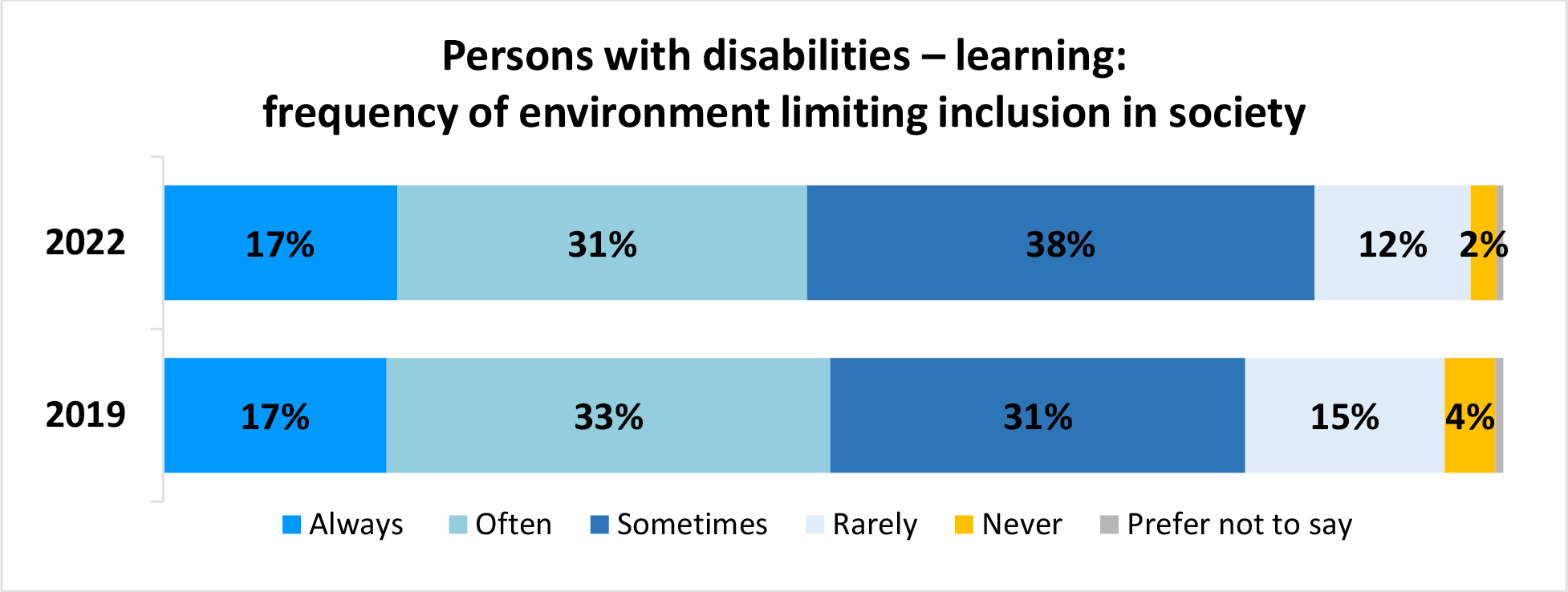
A horizontal bar graph titled, Persons with disabilities – learning: frequency of environment limiting inclusion in society
The values are as follows. 2022. Always, 17 percent. Often, 31 percent. Sometimes, 38 percent. Rarely, 12 percent. Never, 2 percent. 2019. Always, 17 percent. Often, 33 percent. Sometimes, 31 percent. Rarely, 15 percent. Never, 4 percent.
Figure 50: Persons with disabilities – learning: difficulty with disability
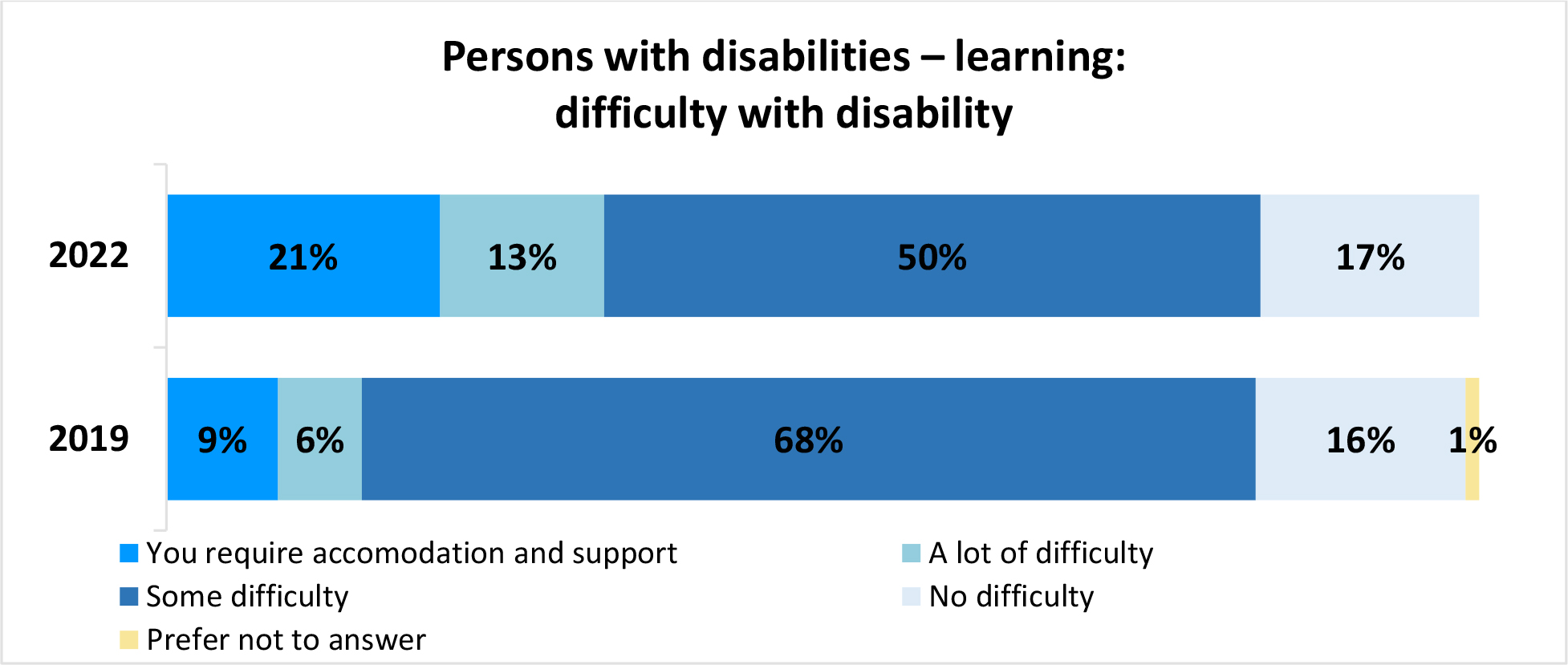
A horizontal bar graph titled, Persons with disabilities – learning: difficulty with disability
The values are as follows. 2022. You require accomodation and support, 21 percent. A lot of difficulty, 13 percent. Some difficulty, 50 percent. No difficulty, 17 percent. 2019. You require accomodation and support, 9 percent. A lot of difficulty, 6 percent. Some difficulty, 68 percent. No difficulty, 16 percent. Prefer not to answer, 1 percent.
Once the incidence was adjusted, more than one in five respondents (23%) had a learning disability, up slightly from the previous wave. The younger respondents were, the higher the incidence for this type of disability. Also, those with a household income of under $20,000 had a higher incidence of this disability. Those identifying as a visible minority reported a higher incidence of a learning disability compared to those who did not. Respondents living in Manitoba and Saskatchewan had the highest proportion of respondents with a learning disability.
Figure 51: Persons with disabilities – learning (adjusted incidence): have this type of disability
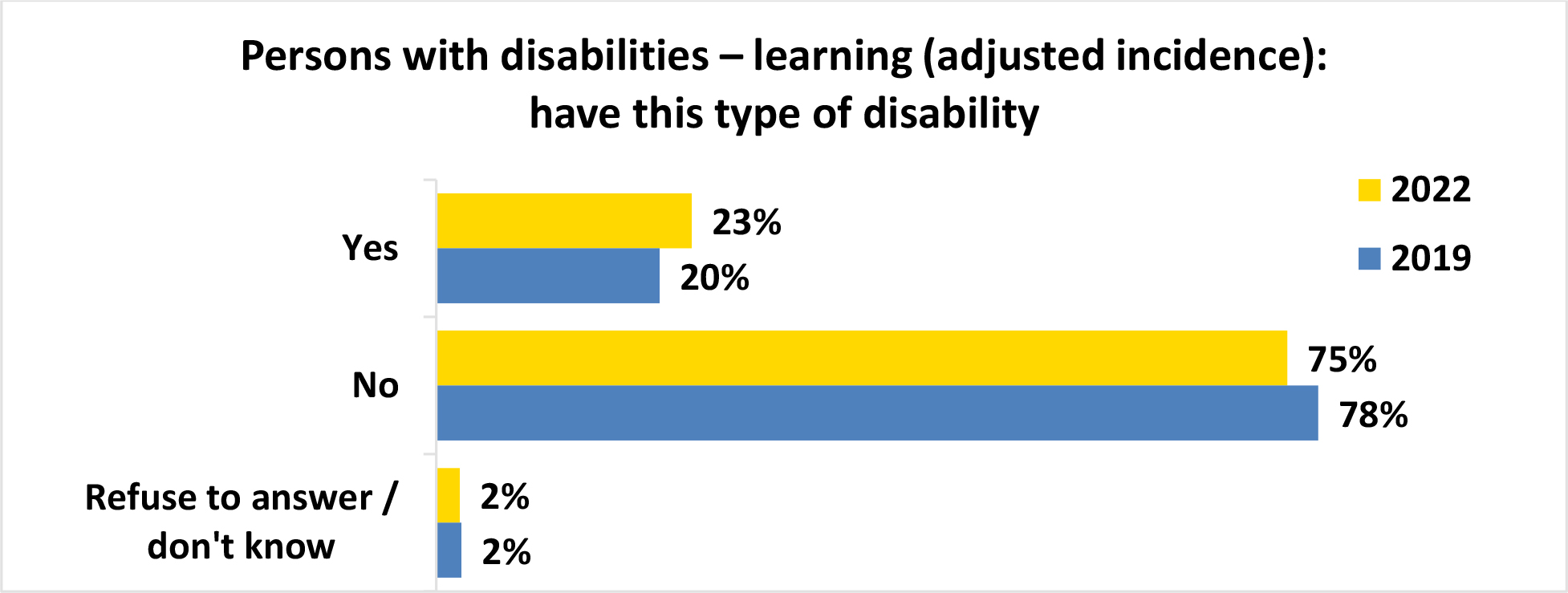
A horizontal bar graph titled, Persons with disabilities learning open parenthesis unadjusted incidence close parenthesis have this type of disability
The values are as follows. Yes. 2022, 23 percent. 2019, 20 percent. No. 2022, 75 percent. 2019, 78 percent. Refuse to answer forward slash don’t know. 2022, 2 percent. 2019, 2 percent.
Communication disability
Roughly one in five (17%) respondents said they had a communication disability. This disability was described as one that “affects the way a person receives, understands, and uses information, not including difficulties related to language”. Over four in five of these respondents (93%) said this disability “always”, “often”, or “sometimes” limited their inclusion in society. Among those who said this happens “rarely”, 86% said they have at least “some difficulty” communicating.
Figure 52: Persons with disabilities – communication (adjusted incidence): have this type of disability
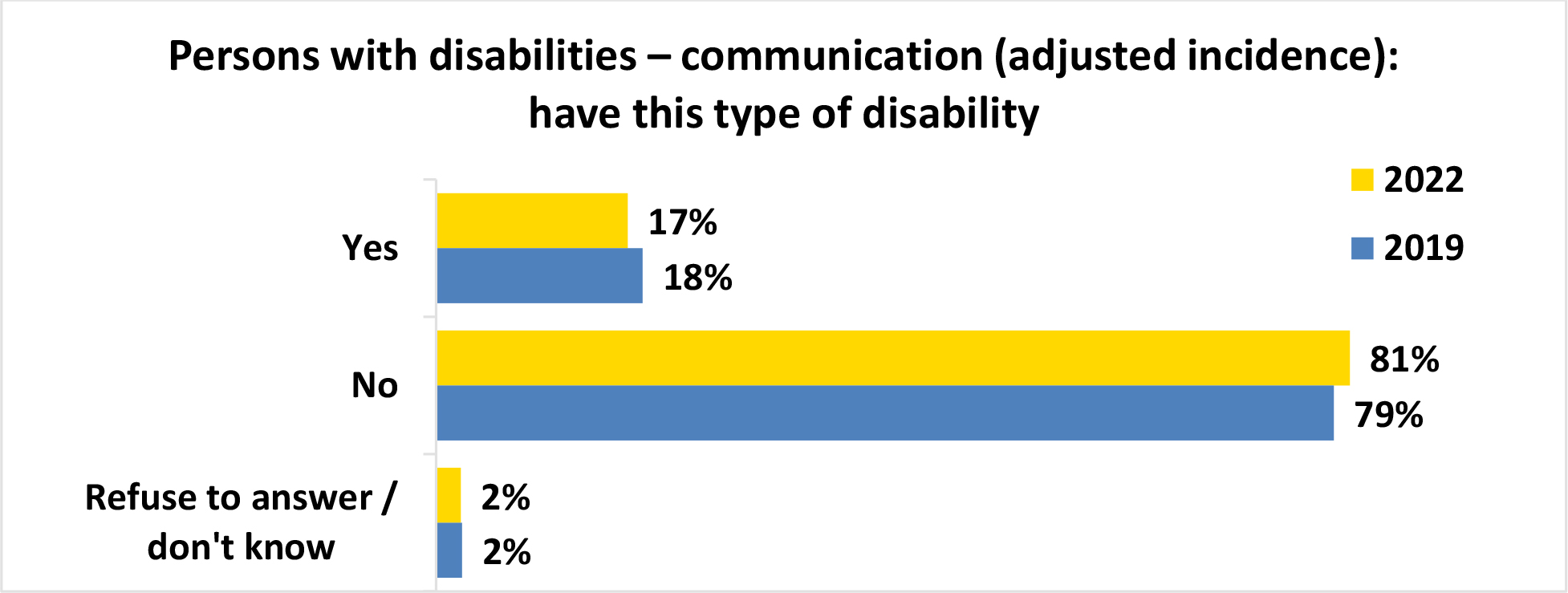
A horizontal bar graph titled, Persons with disabilities communication open parenthesis unadjusted incidence close parenthesis have this type of disability
The values are as follows. Yes. 2022, 17 percent. 2019, 18 percent. No. 2022, 81 percent. 2019, 79 percent. Refuse to answer forward slash don’t know. 2022, 2 percent. 2019, 2 percent.
Figure 53: Persons with disabilities – communication: frequency of environment limiting inclusion in society
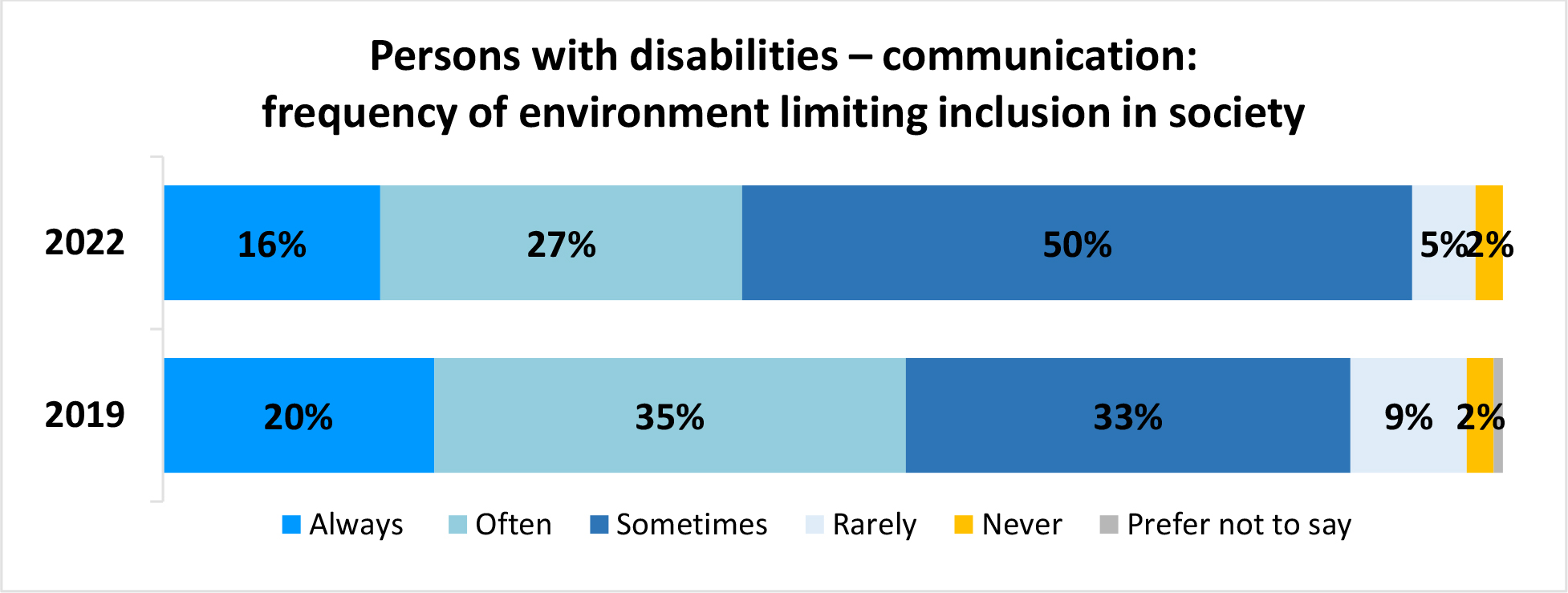
A horizontal bar graph titled, Persons with disabilities – communication: frequency of environment limiting inclusion in society
The values are as follows. 2022. Always, 16 percent. Often, 27 percent. Sometimes, 50 percent. Rarely, 5 percent. Never, 2 percent. 2019. Always, 20 percent. Often, 35 percent. Sometimes, 33 percent. Rarely, 9 percent. Never, 2 percent.
The adjusted incidence did not have much impact as still 17% of respondents had this disability once social inclusion and level of difficulty were factored in. Those with a high school education tended to have an increased incidence of a communication disability. As well, as the household income decreased, the incidence of this disability increased. Men more commonly reported a communication disability compared to women. Those living in Manitoba or Saskatchewan had the highest proportion of respondents with a communication disability.
Figure 54: Persons with disabilities – communication (adjusted incidence): have this type of disability
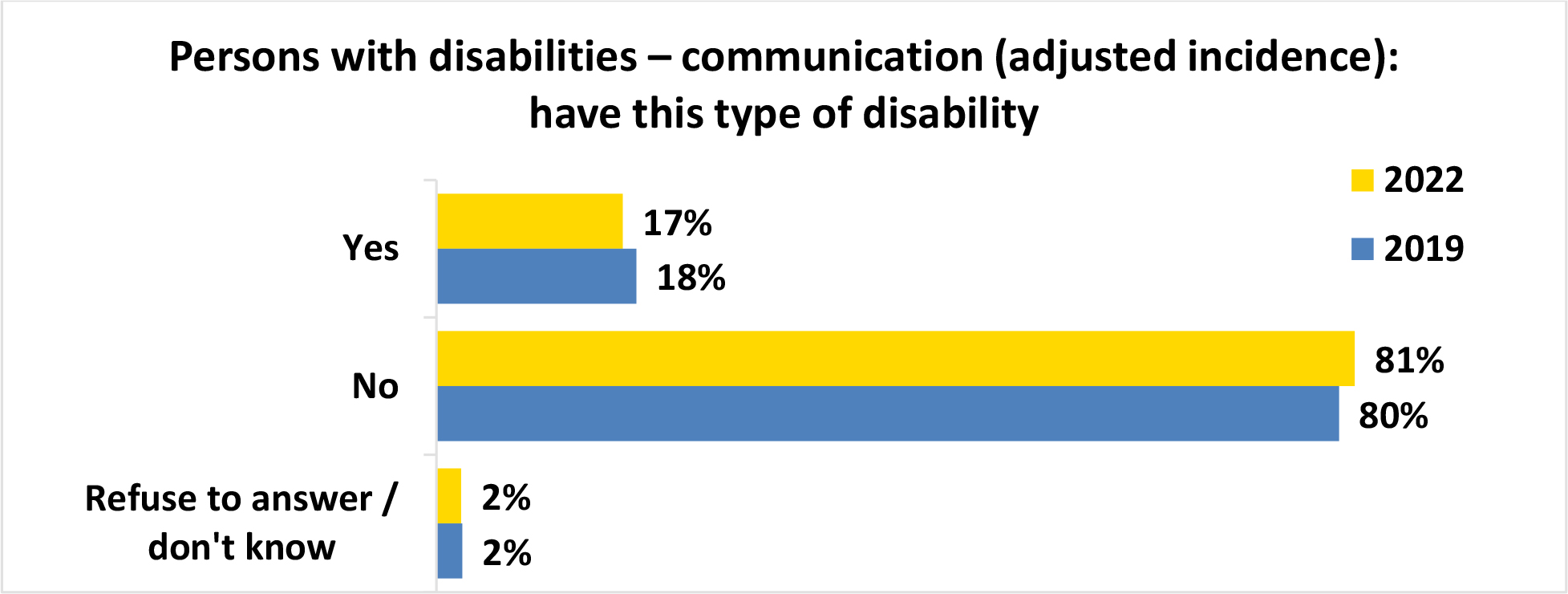
A horizontal bar graph titled, Persons with disabilities communication open parenthesis unadjusted incidence close parenthesis have this type of disability
The values are as follows. Yes. 2022, 17 percent. 2019, 18 percent. No. 2022, 81 percent. 2019, 80 percent. Refuse to answer forward slash don’t know. 2022, 2 percent. 2019, 2 percent.
Speech disability
More than one in ten (12%) survey respondents said they had a speech disability. This disability was described as “a speech disorder that affects the way a person speaks”. Over four in five of these respondents (83%) said this disability “always”, “often”, or “sometimes” limited their inclusion in society. Among those who said this happens “rarely”, 85% said they have at least “some difficulty” speaking.
Figure 55: Persons with disabilities – speech (unadjusted incidence): have this type of disability
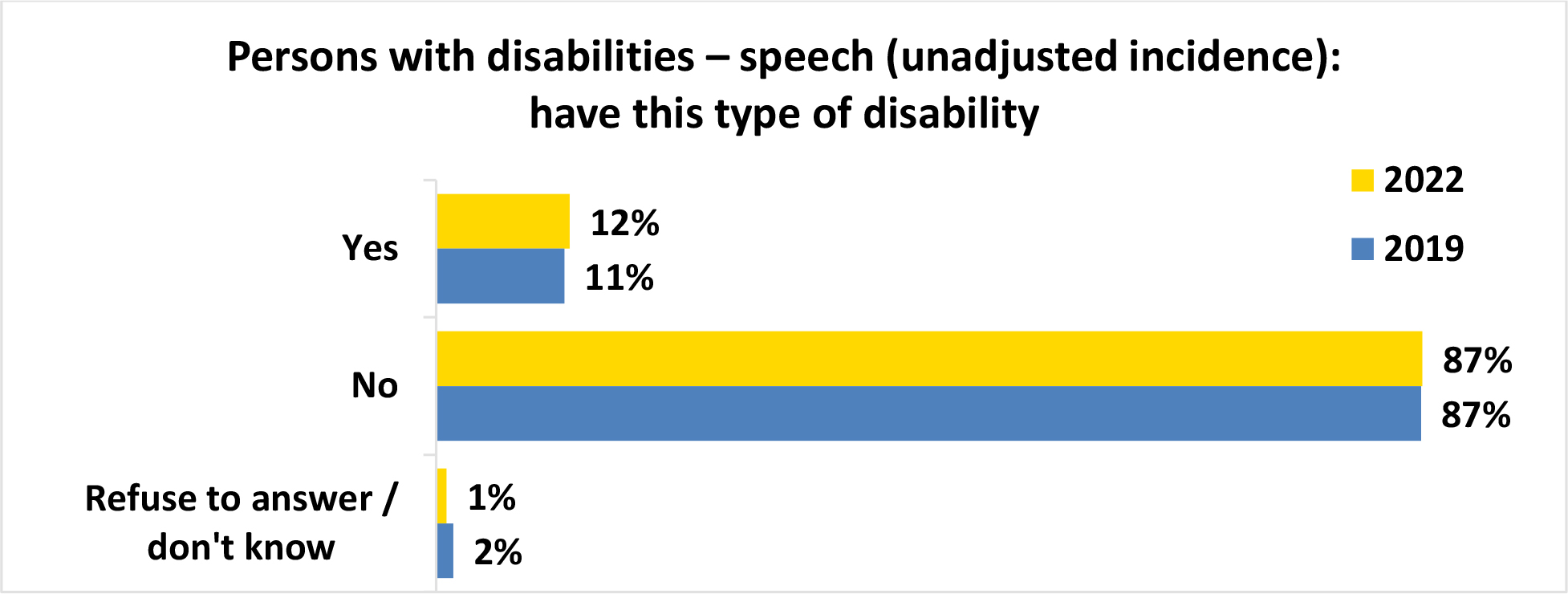
A horizontal bar graph titled, Persons with disabilities speech open parenthesis unadjusted incidence close parenthesis have this type of disability
The values are as follows. Yes. 2022, 12 percent. 2019, 11 percent. No. 2022, 87 percent. 2019, 87 percent. Refuse to answer forward slash don’t know. 2022, 1 percent. 2019, 2 percent.
Figure 56: Persons with disabilities – speech: frequency of environment limiting inclusion in society
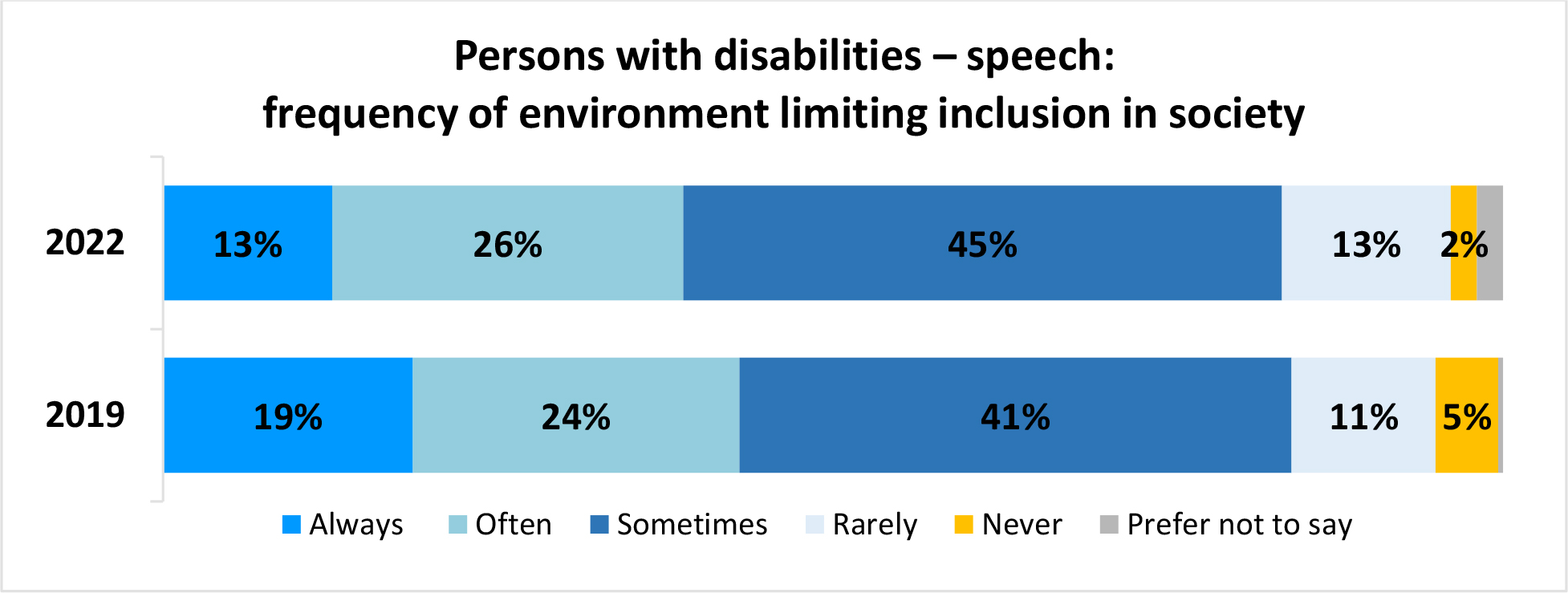
A horizontal bar graph titled, Persons with disabilities – speech: frequency of environment limiting inclusion in society
The values are as follows. 2022. Always, 13 percent. Often, 26 percent. Sometimes, 45 percent. Rarely, 13 percent. Never, 2 percent. Prefer not to say, 2 percent. 2019. Always, 19 percent. Often, 24 percent. Sometimes, 41 percent. Rarely, 11 percent. Never, 5 percent.
When accounting for the adjusted incidence, 11% of respondents reported having a speech disability. As level of education decreased, the tendency to have a speech disability increased. As household income decreased, the incidence of this disability increased. Men more commonly reported having a speech disability compared to women. Those living in Quebec had the highest proportion of respondents with a speech disability.
Figure 57: Persons with disabilities – speech (adjusted incidence): have this type of disability
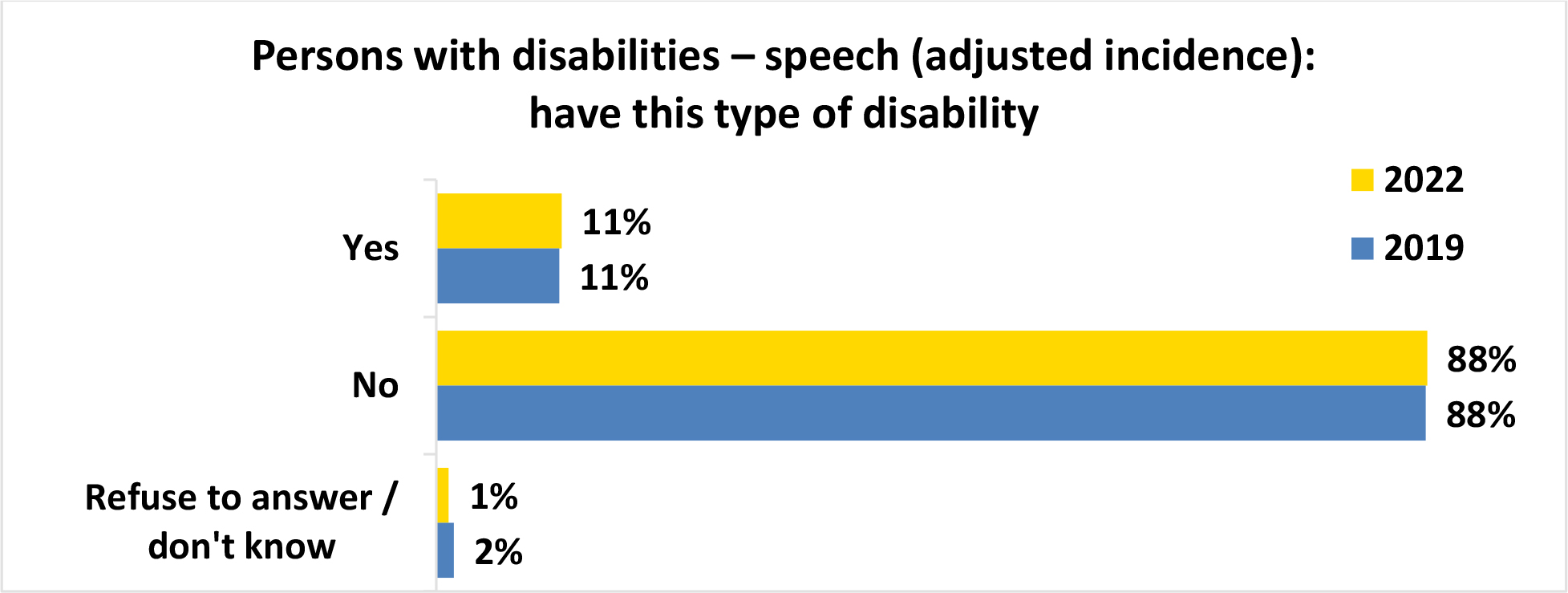
A horizontal bar graph titled, Persons with disabilities speech open parenthesis unadjusted incidence close parenthesis have this type of disability
The values are as follows. Yes. 2022, 11 percent. 2019, 11 percent. No. 2022, 88 percent. 2019, 88 percent. Refuse to answer forward slash don’t know. 2022, 1 percent. 2019, 2 percent.
Developmental disability
More than one in ten respondents (12%) said they had a developmental disability. This disability was described as “intellectual disabilities that affect a person’s ability to learn and to adapt their behavior to different situations”. Over 4 in 5 of these respondents (93%) said this disability “always”, “often”, or “sometimes” limited their inclusion in society. Among the 14 disabilities considered, persons with this disability were the most likely to indicate it “always” limited their inclusion in society (26%).
Figure 58: Persons with disabilities – developmental (unadjusted incidence): have this type of disability
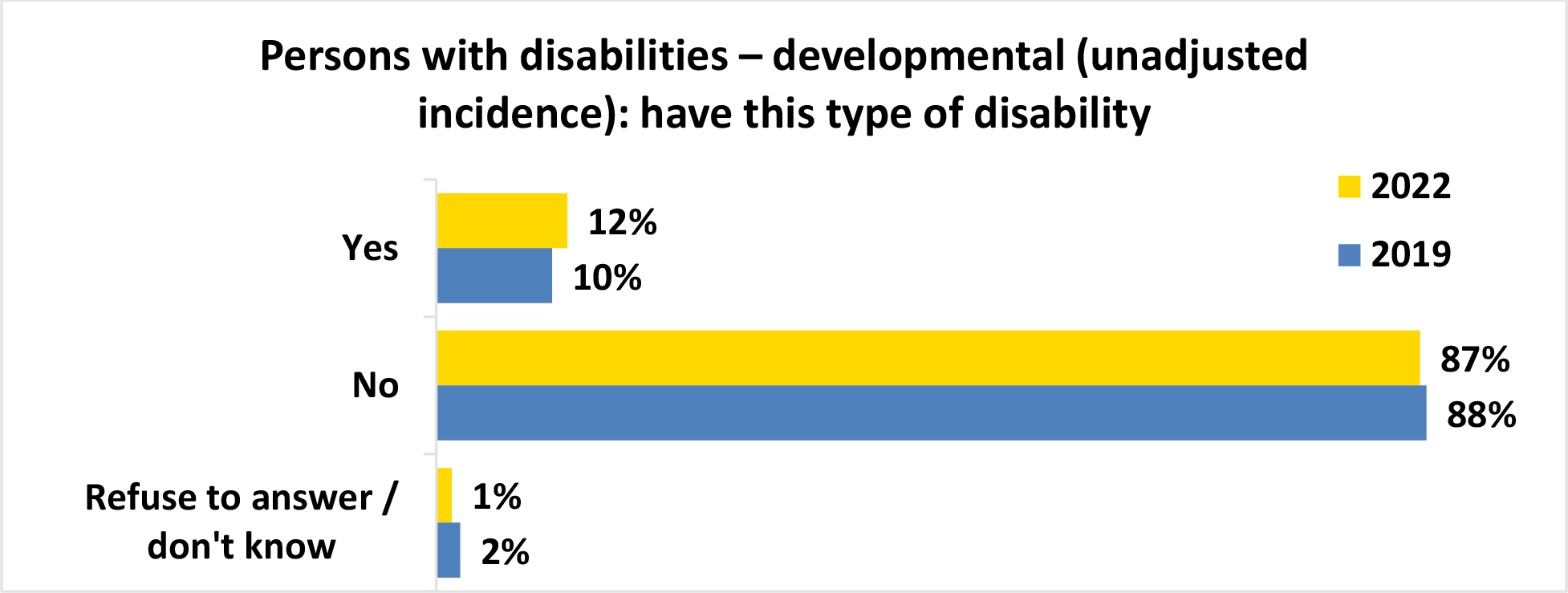
A horizontal bar graph titled, Persons with disabilities development open parenthesis unadjusted incidence close parenthesis have this type of disability
The values are as follows. Yes. 2022, 12 percent. 2019, 10 percent. No. 2022, 87 percent. 2019, 88 percent. Refuse to answer forward slash don’t know. 2022, 1 percent. 2019, 2 percent.
Figure 59: Persons with disabilities – developmental: frequency of environment limiting inclusion in society

A horizontal bar graph titled, Persons with disabilities – developmental: frequency of environment limiting inclusion in society
The values are as follows. 2022. Always, 26 percent. Often, 38 percent. Sometimes, 30 percent. Rarely, 2 percent. Never, 5 percent. 2019. Always, 24 percent. Often, 35 percent. Sometimes, 30 percent. Rarely, 7 percent. Never, 3 percent.Prefer not to say, 1 percent.
This specific disability was not adjusted for a new incidence depending on social inclusion or level of difficulty. As age of respondents decreased, the incidence of having a developmental disability increased. Respondents identifying as a visible minority more commonly reported having a developmental disability compared to those who did not. Those identifying as a member of the LGBTQ2+ community were also more likely to report this disability than those who did not. A greater proportion of men than women said they have this disability. Also, as household income decreased, the incidence of this disability increased.
Language disability
Slightly less than one in ten (8%) of survey respondents said they had a language disability. This disability was described as “a language-based disability that affects a person’s ability to understand and use spoken, signed, and written language”. Over four in five of these respondents (86%) said this disability “always”, “often”, or “sometimes” limited their inclusion in society. Among those who said this happens “rarely”, 67% said they have at least “some difficulty” with their language-based disability.
Figure 60: Persons with disabilities – language (unadjusted incidence): have this type of disability
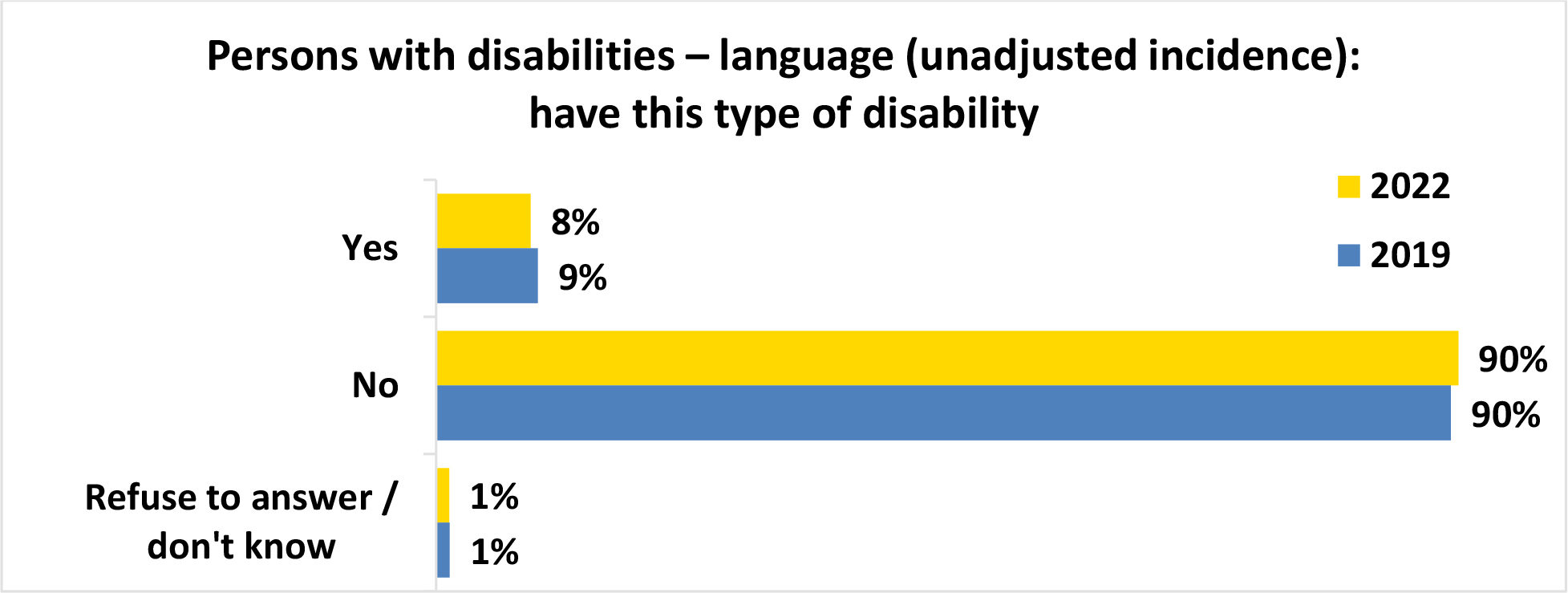
A horizontal bar graph titled, Persons with disabilities language open parenthesis unadjusted incidence close parenthesis have this type of disability
The values are as follows. Yes. 2022, 8 percent. 2019, 9 percent. No. 2022, 90 percent. 2019, 90 percent. Refuse to answer forward slash don’t know. 2022, 1 percent. 2019, 1 percent.
Figure 61: Persons with disabilities – language: frequency of environment limiting inclusion in society

A horizontal bar graph titled, Persons with disabilities – language: frequency of environment limiting inclusion in society
The values are as follows. 2022. Always, 25 percent. Often, 22 percent. Sometimes, 40 percent. Rarely, 12 percent. Never, 1 percent. 2019. Always, 22 percent. Often, 24 percent. Sometimes, 36 percent. Rarely, 13 percent. Never, 4 percent.Prefer not to say, 1 percent.
Once the incidence was adjusted, 8% of participants had a language disability. Those with a high school education tended to report having a language disability to a greater extent than respondents having completed a higher level of education. Also, those with a household income of less than $20,000 had a higher incidence of this disability. Those living in Quebec had the highest proportion of respondents with a language disability.
Figure 62: Persons with disabilities – language (adjusted incidence): have this type of disability
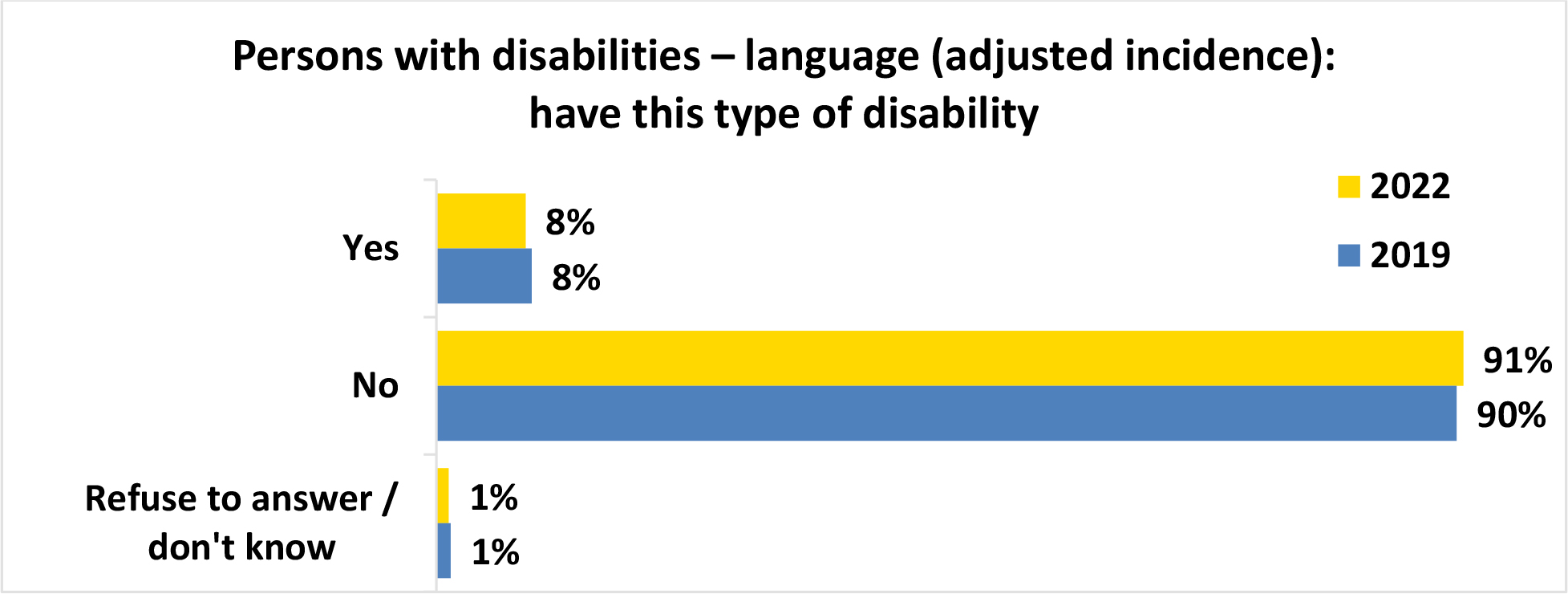
A horizontal bar graph titled, Persons with disabilities language open parenthesis unadjusted incidence close parenthesis have this type of disability
The values are as follows. Yes. 2022, 8 percent. 2019, 8 percent. No. 2022, 91 percent. 2019, 90 percent. Refuse to answer forward slash don’t know. 2022, 1 percent. 2019, 1 percent.
Other disabilities
More than two in five respondents (43%) said they have another type of disability, up from a quarter in the previous wave (25%). The most common mentions included neurological issues, additional forms of physical pain or mobility issues, general chronic conditions, diabetes, or arthritis. Three quarters of respondents (75%) said this disability “always”, “often”, or “sometimes” limited their inclusion in society.
Once the incidence was adjusted for this disability8, 39% of participants had another disability.
Figure 63: Persons with disabilities – other disability (unadjusted incidence): have this type of disability
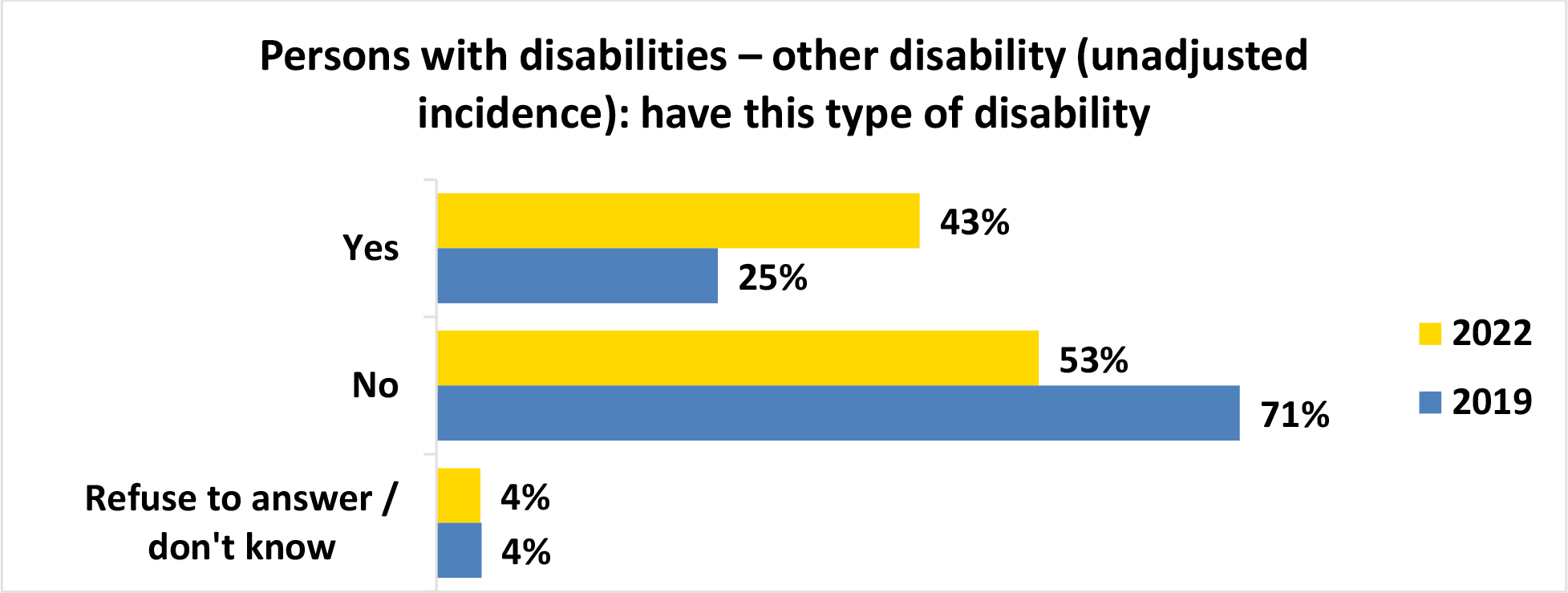
A horizontal bar graph titled, Persons with disabilities other disabilityopen parenthesis unadjusted incidence close parenthesis have this type of disability
The values are as follows. Yes. 2022, 43 percent. 2019, 25 percent. No. 2022, 53 percent. 2019, 71 percent. Refuse to answer forward slash don’t know. 2022, 4 percent. 2019, 4 percent.
Figure 64: Persons with disabilities – other disability: frequency of environment limiting inclusion in society
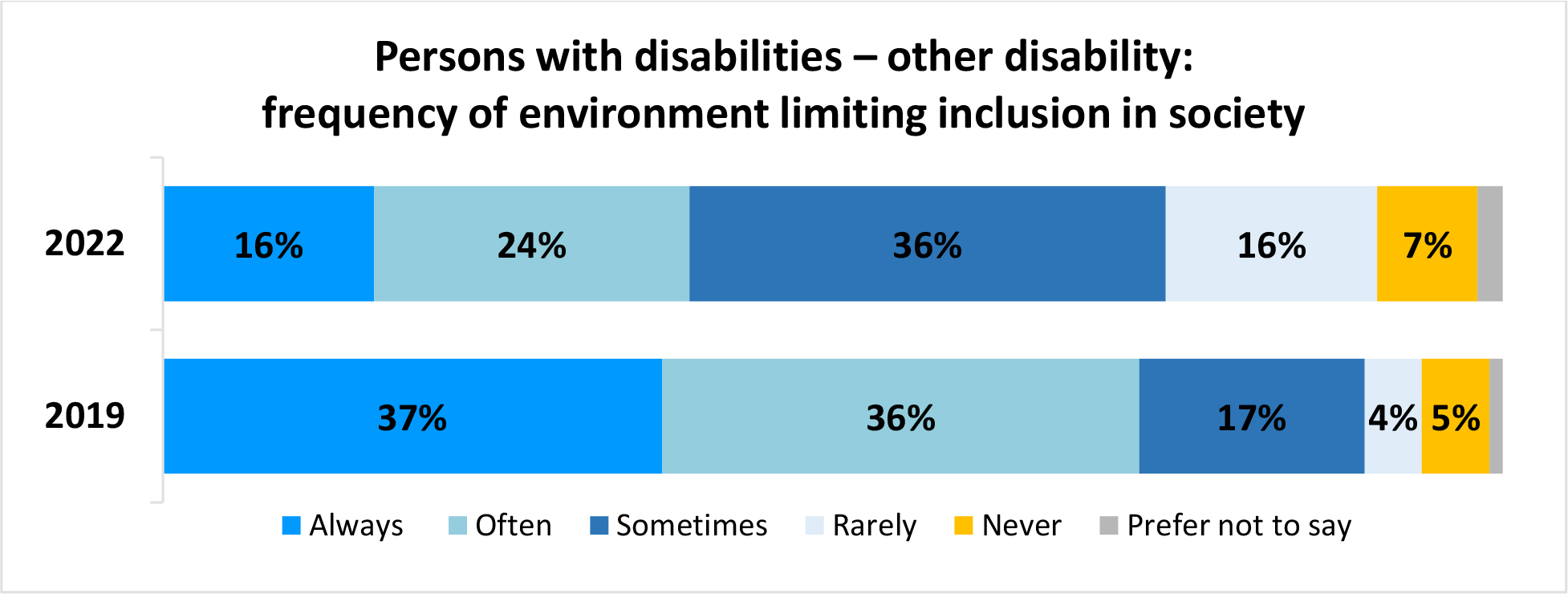
A horizontal bar graph titled, Persons with disabilities – other disability: frequency of environment limiting inclusion in society
The values are as follows. 2022. Always, 16 percent. Often, 24 percent. Sometimes, 36 percent. Rarely, 16 percent. Never, 7 percent. Prefer not to say, 1 percent. 2019. Always, 37 percent. Often, 36 percent. Sometimes, 17 percent. Rarely, 4 percent. Never, 5 percent. Prefer not to say, 1 percent.
Figure 65: Persons with disabilities – other disability (adjusted incidence): have this type of disability
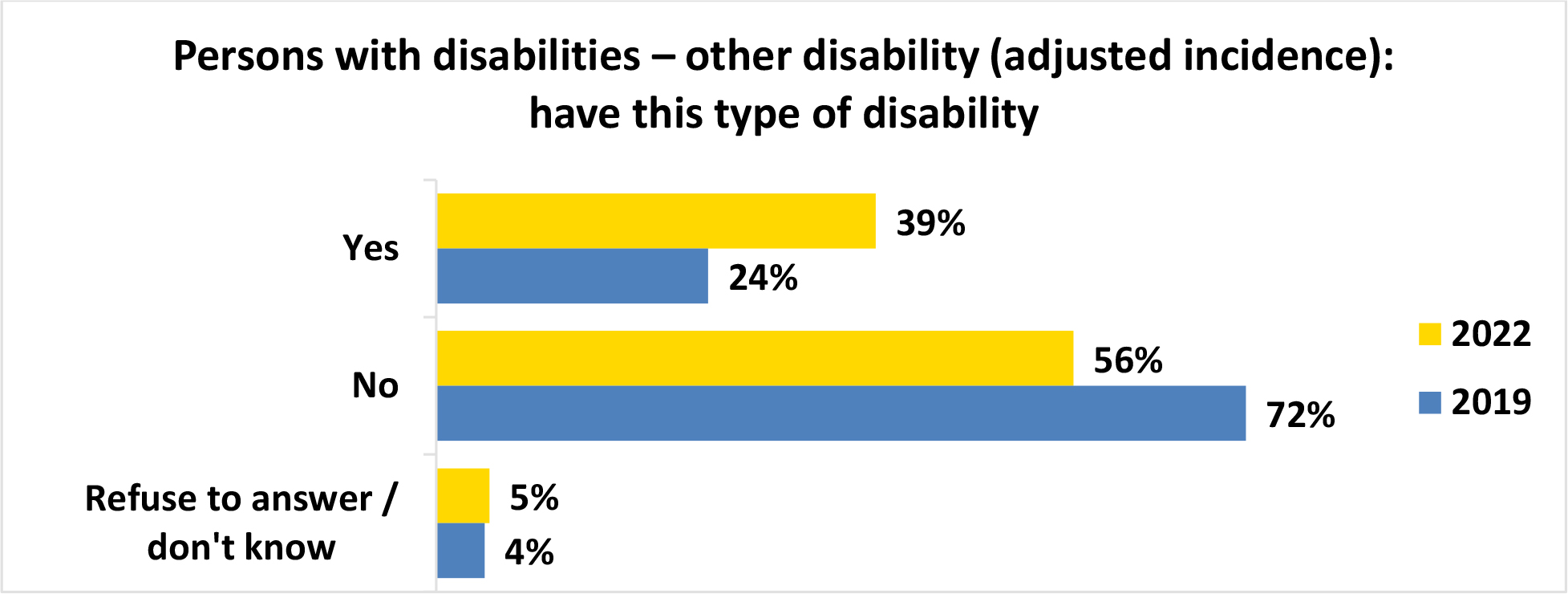
A horizontal bar graph titled, Persons with disabilities other disabilityopen parenthesis unadjusted incidence close parenthesis have this type of disability
The values are as follows. Yes. 2022, 39 percent. 2019, 24 percent. No. 2022, 56 percent. 2019, 72 percent. Refuse to answer forward slash don’t know. 2022, 5 percent. 2019, 4 percent.
Information and communication technologies (ICT) access (PWD)
To evaluate the extent to which information and communication technology (ICT) was accessible, respondents with a disability were first asked to specify whether they had access to the internet at home. Nearly all respondents (93%) reported having access to the internet, while less than one in ten (7%) did not.
Figure 66: Persons with disabilities – access to the internet at home

The following subgroup findings emerged:
Respondents aged 18 to 34 years old (97%), and those 35 to 64 years old (98%), had greater access to the internet compared to those 65 years or older (87%).
As level of education increased, access to the internet increased, as those with a university education tended to have access to the internet (98%) compared to those with a college (95%) or high school education (84%).
As household income increased, access to the internet increased, as those earning $80,000 or more had a higher tendency of access (98%) compared to those earning $40,000 to $79,999 (97%), $20,000 to $39,999 (92%), or less than $20,000 (85%).
When comparing access to the internet among various types of disabilities, those with the greatest access to the internet include respondents with a hearing (95%), mental health (95%), speech (94%), or dexterity disability (94%). Those less likely to have internet access included respondents with a developmental (85%), language / communication (88%), or memory disability (90%).
Respondents who specified they did not have access to the internet at home were then asked to describe the reasons for a lack of access. More than two in five described a lack of need or interest (42%), rather than a specific barrier to access.
Among those citing specific barriers, more than one in five were restricted by the cost to access (22%), while more than one in ten mentioned difficulties using the internet (13%). One tenth of respondents reported a lack of a device for accessing the internet (10%).
Figure 67: Persons with disabilities – reasoning for lack of internet access at home
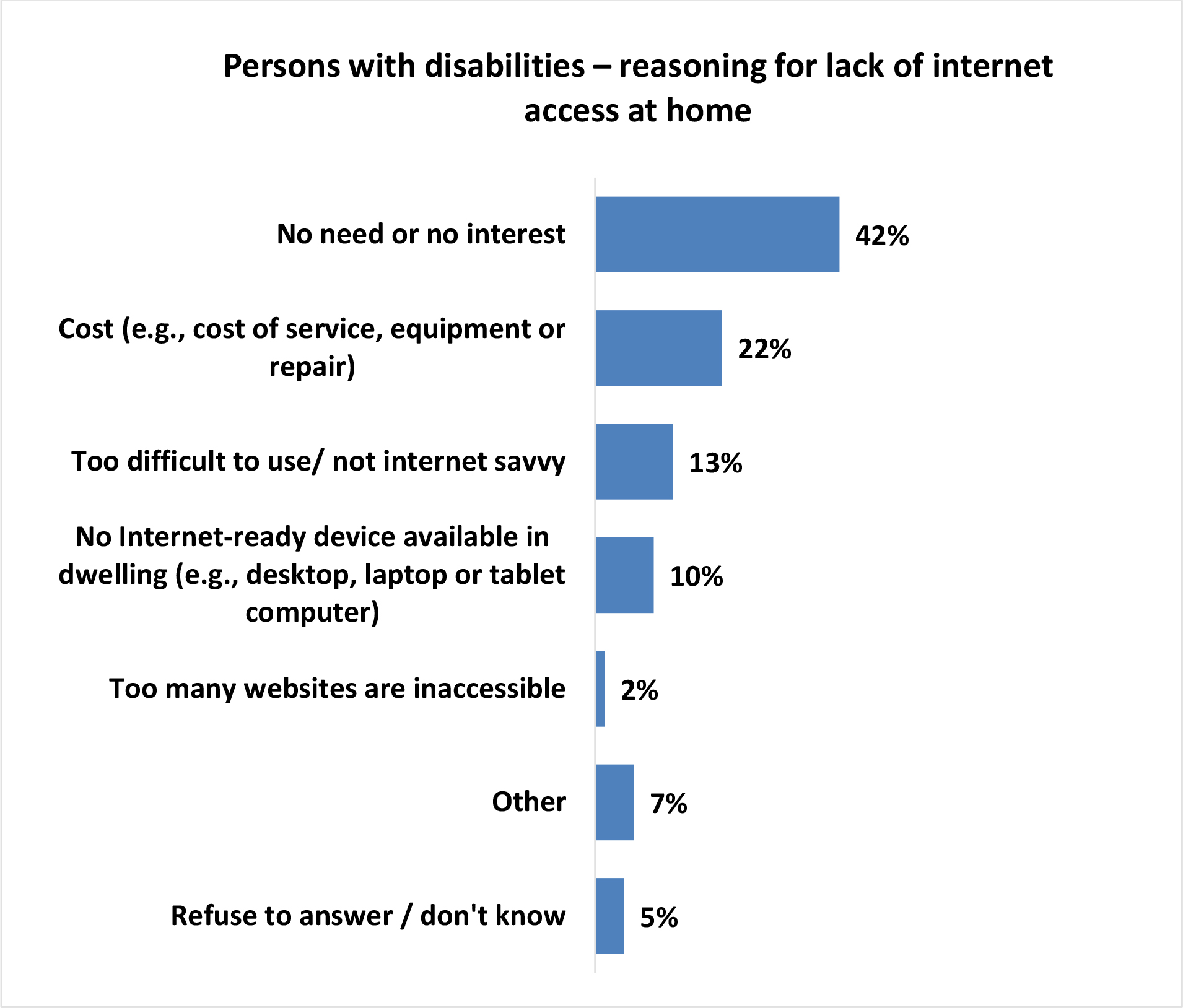
A horizontal bar chart titled, Persons with disabilities – reasoning for lack of internet access at home
The values are as follows. No need or no interest, 42 percent. Cost open parenthesis e.g., cost of service, equipment or repair close parenthesis, 22 percent. Too difficult to use forward slash not internet savvy, 13 percent. No Internet-ready device available in dwelling open parenthesis e.g., desktop, laptop or tablet computer close parenthesis, 2 percent. Too many websites are inaccessible, 2 percent. Other, 7 percent. Refuse to answer forward slash don’t know, 5 percent.
Information and communication technologies (ICT)-related barriers (PWD)
Respondents were then asked if they had experienced barriers related to the use of information and communication technology. Respondents were specifically provided with the following description for barriers to accessibility:
Over the past two years, the incidence of respondents having experienced the following technology barriers because of an accessibility issue either “always” or “often” are:
Using a website (16%),
Using self-service technology in a public place (16%),
Using a cellphone or accessing a wireless service (13%),
Watching a video on the internet, for example on YouTube, Facebook, other social media or websites (13%),
Watching a show on a streaming service such as Netflix, AppleTV, Crave, Amazon Prime, or a similar service (10%), or
Watching cable TV (10%).
Overall, less than one in five respondents said these situations do not apply to them, and another third to less than half said they “never” experienced these barriers.
The largest increases in “always” or “often” responses since 2019 were observed in using a website (12% to 16%), followed by using a cellphone or accessing a wireless service (10% to 13%).
Conversely, the largest decrease in “always” or “often” responses were observed when watching cable TV (12% to 10%).
Figure 68: Persons with disabilities – barriers to information and communication technology
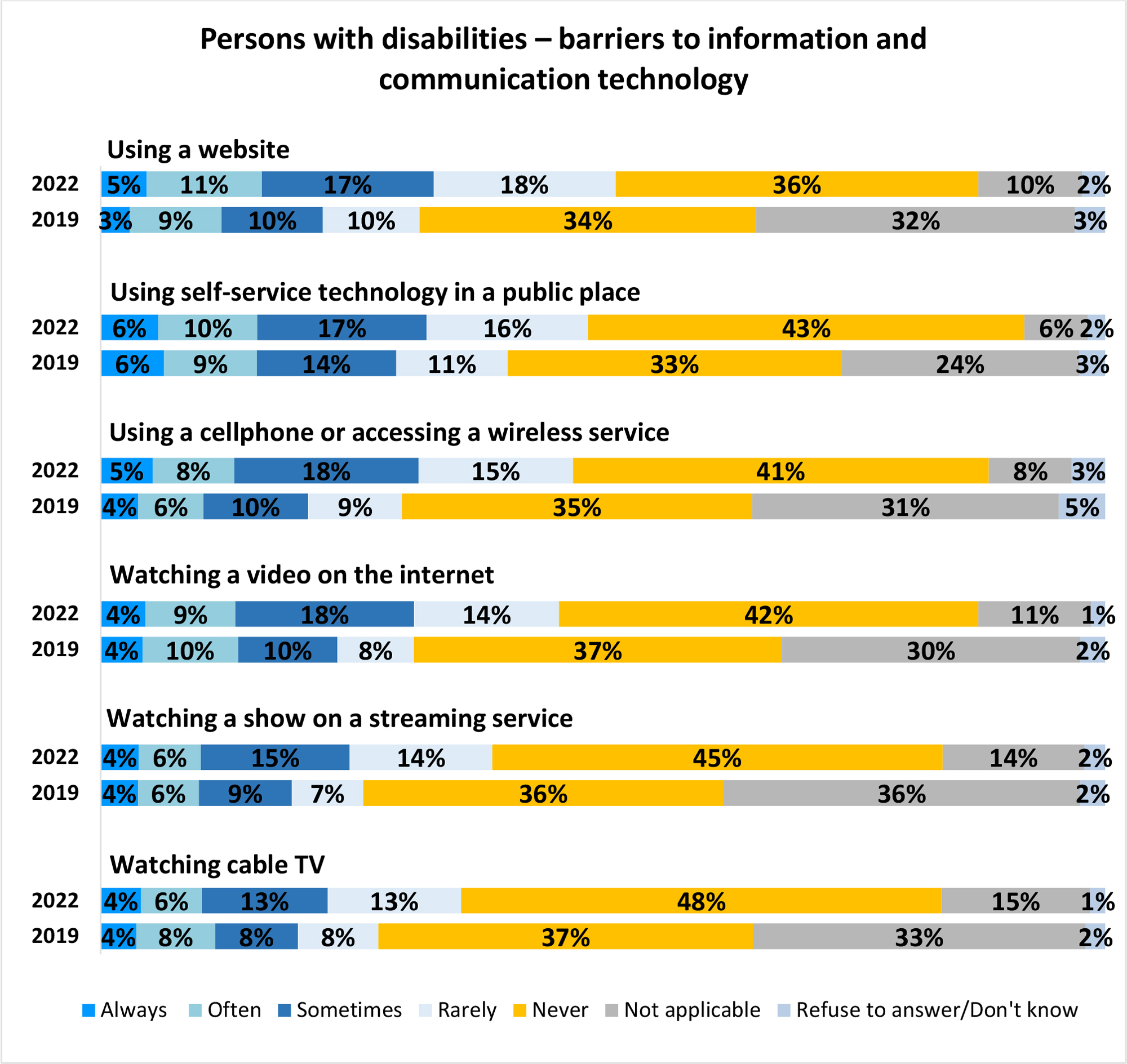
A horizontal bar chart titled, Persons with disabilities – barriers to information and communication technology
The values are as follows.
Using a website. 2022. Always, 5 percent. Often, 11 percent. Sometimes, 17 percent. Rarely, 18 percent. Never, 36 percent. Not applicable, 10 percent. Refuse to answer forward slash don’t know, 2 percent. 2019. Always, 3 percent. Often, 9 percent. Sometimes, 10 percent. Rarely, 10 percent. Never, 34 percent. Not applicable, 32 percent. Refuse to answer forward slash don’t know, 3 percent.
Using self-service technology in a public place. 2022. Always, 6 percent. Often,10 percent. Sometimes, 17 percent. Rarely, 16 percent. Never, 43 percent. Not applicable, 6 percent. Refuse to answer forward slash don’t know, 2 percent. 2019. Always, 6 percent. Often, 9 percent. Sometimes, 14 percent. Rarely, 11 percent. Never, 33 percent. Not applicable, 24 percent. Refuse to answer forward slash don’t know, 3 percent.
Using a cellphone or accessing a wireless service. 2022. Always, 5 percent. Often, 8 percent. Sometimes, 18 percent. Rarely, 15 percent. Never, 41 percent. Not applicable, 8 percent. Refuse to answer forward slash don’t know, 3 percent. 2019. Always, 4 percent. Often, 6 percent. Sometimes, 10 percent. Rarely, 9 percent. Never, 35 percent. Not applicable, 31 percent. Refuse to answer forward slash don’t know, 5 percent.
Watching a video on the internet. 2022. Always, 4 percent. Often, 9 percent. Sometimes, 18 percent. Rarely, 14 percent. Never, 42 percent. Not applicable, 11 percent. Refuse to answer forward slash don’t know, 1 percent. 2019. Always, 4 percent. Often, 10 percent. Sometimes, 10 percent. Rarely, 8 percent. Never, 37 percent. Not applicable, 30 percent. Refuse to answer forward slash don’t know, 2 percent.
Watching a show on a streaming service. 2022. Always, 4 percent. Often, 6 percent. Sometimes, 15 percent. Rarely, 14 percent. Never, 45 percent. Not applicable, 14 percent. Refuse to answer forward slash don’t know, 2 percent. 2019. Always, 4 percent. Often, 6 percent. Sometimes, 9 percent. Rarely, 7 percent. Never, 36 percent. Not applicable, 36 percent. Refuse to answer forward slash don’t know, 2 percent.
Watching cable T V. 2022. Always, 4 percent. Often, 6 percent. Sometimes, 13 percent. Rarely, 13 percent. Never, 48 percent. Not applicable, 15 percent. Refuse to answer forward slash don’t know, 1 percent. 2019. Always, 4 percent. Often, 8 percent. Sometimes, 8 percent. Rarely, 8 percent. Never, 37 percent. Not applicable, 33 percent. Refuse to answer forward slash don’t know, 2 percent.
In terms of differences observed across various subgroups:
Those who identified as visible minorities were generally more likely to say they “always” experience ICT barriers, while those who did not identify as visible minorities more commonly “never” experienced these barriers.
Respondents with household incomes under $20,000 more commonly said they “always” experience these types of barriers, while those with a household income of at least $40,000 tended to say they “never” experience these barriers, consistent with results from the previous wave.
Additionally, men tended to report having “never” experienced these barriers when compared to women, remaining consistent with results observed in 2019.
Those working full-time tended to report having “never” experienced these barriers when compared to those who were unemployed or not in the workforce.
Respondents in Ontario more commonly reported “never” experiencing these barriers compared to those living in the rest of Canada.
Those living in Atlantic Canada tended to have “always” experienced barriers to using self-service technology in a public place and using a cellphone or wireless service.
Respondents living in Manitoba or Saskatchewan more commonly “always” experienced barriers to watching a show on a streaming service or watching a video on the internet.
Respondents most likely to say they “always” or “often” experienced ICT barriers were those with seeing, language / communication, speech, hearing, developmental, memory, and learning disabilities. When specifically looking at those who “always” experience barriers, the following disabilities were most common:
Respondents more likely to indicate they “always” face barriers when using a website that was not accessible for them were those with a language / communication, speech, seeing, or learning disability;
Respondents more likely to indicate they “always” face barriers when using a wireless service were those with a language / communication, speech, seeing, or hearing disability;
Respondents more likely to indicate they “always” face barriers when using a self-service technology in a public space were those with a seeing, speech, dexterity, memory, or flexibility disability;
Respondents more likely to indicate they “always” face barriers when watching cable were those with a language / communication, hearing, seeing, or developmental disability;
Respondents more likely to indicate they “always” face barriers when watching a show on a streaming service were those with a language/ communication, seeing, hearing, speech, or memory disability;
Respondents more likely to indicate they “always” face barriers when watching a video on the internet were those with a / communication, seeing, hearing, speech or developmental disability.
Design and delivery of programs and services (PWD)
When respondents with disabilities were asked to specify how they preferred to access services or programs from federal sector organizations, the plurality (42%) preferred online, followed by in person (24%) and by telephone (19%). Less than one in ten respondents would select by mail options (8%).
Figure 69: Persons with disabilities – preferred mode for accessing services or programs from federal sector organizations

A horizontal bar chart titled, Persons with disabilities – preferred mode for accessing services or programs from federal sector organizations
The values are as follows. online, 42 percent. In person, 24 percent. Telephone, 19 percent. Mail, 8 percent. With the help of another person, 1 percent. Email, less than 1 percent. Through a government representative, less than 1 percent. All of them forward slash combination, 1 percent. other, 1 percent. Don’t use services forward slash don’t need services, 2 percent. Don’t know, 1 percent.
In terms of subgroup comparisons:
Respondents living in Manitoba or Saskatchewan were the most common region to report preferring accessing services or programs online (51%).
Men were more likely than women to prefer access to services or programs in person compared to women (30% vs 22%).
Respondents aged 18 to 34 (49%) and those 35 to 64 years old (53%) were more likely to prefer online options compared to those 65 years or older (27%).
Conversely, those aged 65 years or older were more likely to prefer using telephone (26%) or mail (13%) options compared to younger Canadians.
Those with a university education (53%) were more likely to prefer online service compared to those with a college (39%) or high school education (27%).
As income increased, tendency to prefer online service increased, as those earning $80,000 or more (57%) scored higher than those earning $40,000 to $79,999 (44%), $20,000 to $39,999 (34%), and those earning under $20,000 (32%).
When comparing results across various types of disabilities, the following trends were observed when accessing federal programs or services:
Those more likely to prefer online access tended to be those with a mental health (48%), dexterity (45%), learning (41%), or hearing disability (40%);
Respondents more likely to prefer in person access tended to be those with a speech (37%), developmental (32%), language / communication (30%), learning (30%), or memory disability (30%);
Those more likely to prefer telephone access tended to be those with a seeing (23%), hearing (20%), mobility (20%), or flexibility disability (20%).
Respondents with disabilities were then asked to specify which particular accommodations they required when accessing services or programs from federal sector organizations. The most common types of accommodations needed based on the proportion who have “always” or “often” needed them were an accessible website (27%), more time to complete a form or an application (26%), documents in plain language (21%) and the use of an assistive device (21%).
Additional accommodation needs included assistance with completing forms (18%), as well as the need for documents in accessible formats (13%).
Figure 70: Persons with disabilities – need for accommodations when accessing federal government programs or services
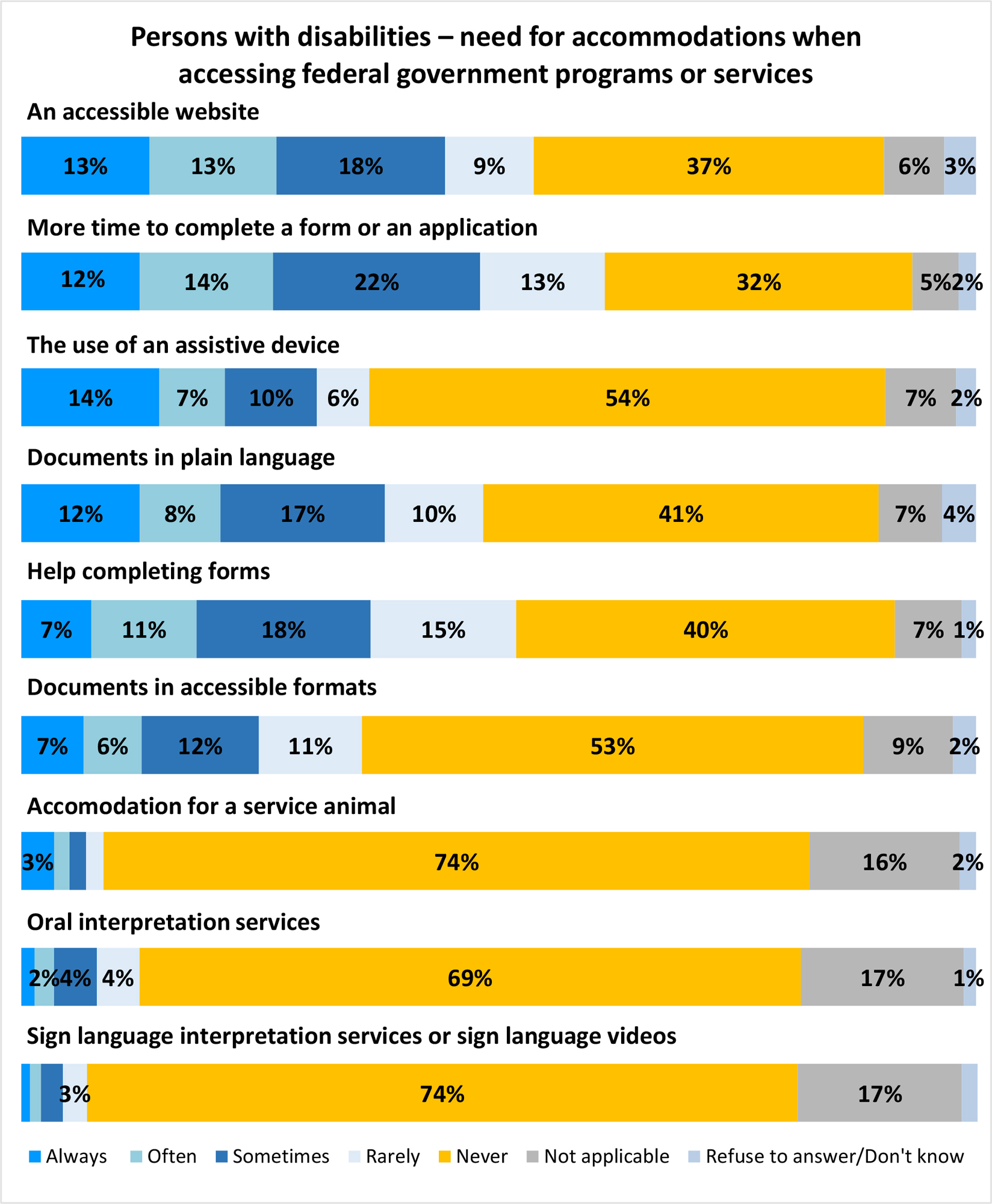
A horizontal bar chart titled, Persons with disabilities – need for accommodations when accessing federal government programs or services
The values are as follows.
An accessible website. Always, 13percent. Often, 13 percent. Sometimes, 18 percent. Rarely, 9 percent. Never, 37 percent. Not applicable, 6 percent. Refuse to answer forward slash Don’t know, 3 percent.
More time to complete a form or an application. Always, 12 percent. Often, 14 percent. Sometimes, 22 percent. Rarely, 13 percent. Never, 32 percent. Not applicable, 5 percent. Refuse to answer forward slash Don’t know, 2 percent.
The use of an assistive device. Always, 14 percent. Often, 7 percent. Sometimes, 10 percent. Rarely, 6 percent. Never, 54 percent. Not applicable, 7 percent. Refuse to answer forward slash Don’t know, 2 percent.
Documents in plain language. Always, 12 percent. Often, 8 percent. Sometimes, 17 percent. Rarely, 10 percent. Never, 41 percent. Not applicable, 7 percent. Refuse to answer forward slash Don’t know, 4 percent.
Help completing forms. Always, 7 percent. Often, 11 percent. Sometimes, 18 percent. Rarely, 15 percent. Never, 40 percent. Not applicable, 7 percent. Refuse to answer forward slash Don’t know, 1 percent.
Documents in accessible formats. Always, 7 percent. Often, 6 percent. Sometimes, 12 percent. Rarely, 11 percent. Never, 53 percent. Not applicable, 9 percent. Refuse to answer forward slash Don’t know, 2 percent.
Accomodation for a service animal. Always, 3 percent. Often, 1 percent. Sometimes, 1percent. Rarely, 1 percent. Never, 74 percent. Not applicable, 16 percent. Refuse to answer forward slash Don’t know, 2 percent.
Oral interpretation services. Always, 1 percent. Often, 2 percent. Sometimes, 4 percent. Rarely, 4 percent. Never, 69 percent. Not applicable, 17 percent. Refuse to answer forward slash Don’t know, 1 percent.
Sign language interpretation services or sign language videos. Always, 1 percent. Often, 1 percent. Sometimes, 2 percent. Rarely, 3 percent. Never, 74 percent. Not applicable, 17 percent. Refuse to answer forward slash Don’t know,1 percent.
When comparing demographic subgroup findings, the following trends were observed:
Respondents living in Atlantic Canada scored highest for “always” needing accessible websites, the use of an assistive device, documents in plain language, help completing forms, and documents in accessible formats.
Other than accessible websites, high school educated respondents were more likely to “always” need each type of accommodation.
Those with a household income of under $20,000 were more likely to provide the highest scores for “always” having the need for an accessible website, more time to complete forms or applications, and help completing forms.
Across the various disability types, the following trends were observed:
Accessible websites were more likely to “always” be needed by those with a seeing, speech, language / communication, dexterity, hearing, learning or developmental disability.
Respondents more likely to “always” require more time to complete an application included those with a language, speech, seeing, learning, developmental, or communication disability.
Those more likely to “always” need the use of an assistive device tended to be individuals with a speech, seeing, mobility, hearing, or dexterity disability.
Documents in plain language were more likely to “always” be needed by those with a speech, language, seeing, hearing, or language / communication disability.
Respondents more likely to “always” require help completing forms were those with a speech, seeing, learning, developmental, or language / communication disability.
Documents in accessible formats were more likely to “always” be needed by those with a seeing, speech, memory, developmental, or learning disability.
In addition to evaluating the extent of the need for nine forms of accommodations for federal programs or services, respondents were asked to identify any additional accessibility needs. Over the past two years, more than two thirds of respondents did not require any additional accommodations.
Additional accommodations were narrow in scope and typically based on unique situations for respondents. Some specific mentions include paperwork limiting access, difficulties with travel, health care accommodations, or difficulties accessing building facilities.
Figure 71: Persons with disabilities – additional needs for accommodations when accessing federal government programs or services
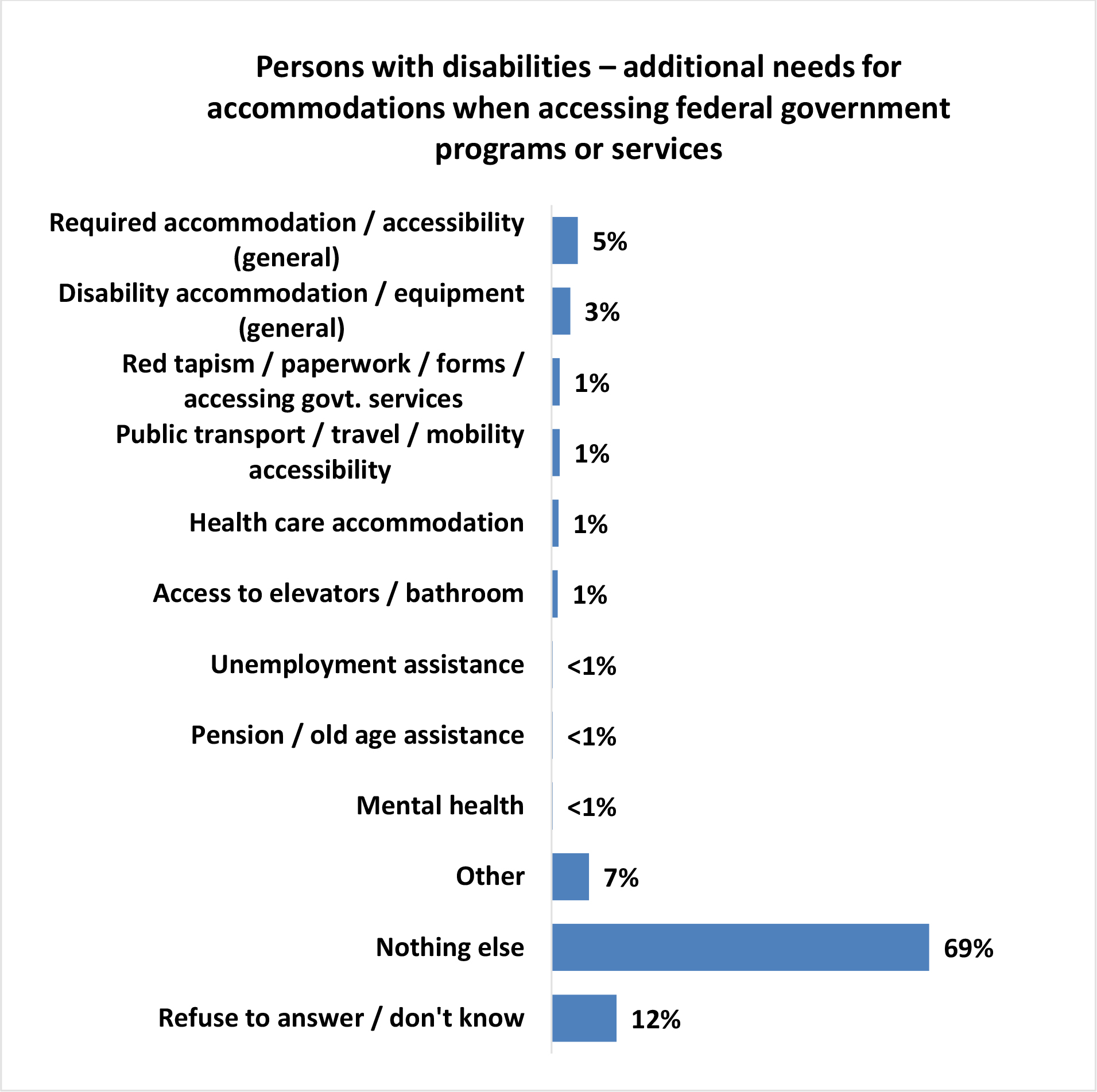
A horizontal bar chart titled, Persons with disabilities – additional needs for accommodations when accessing federal government programs or services
The values are as follows. Required accommodation forward slash accessibility open parenthesis general close parenthesis, 5 percent. Disability accommodation forward slash equipment open parenthesis general close parenthesis, 3 percent. Red tapism forward slash paperwork forward slash forms forward slash accessing govt. services, 1 percent. Public transport forward slash travel forward slash mobility accessibility, 1 percent. Health care accommodation, 1 percent. Access to elevators forward slash bathroom, 1 percent. Unemployment assistance, less than 1 percent. Pension forward slash old age assistance, less than 1 percent. Mental health, less than 1 percent. Other, 7 percent. Nothing else, 69 percent. Refuse to answer forward slash don’t know, 12 percent.
Communication other than information and communications technologies (PWD)
Respondents were subsequently asked to evaluate a series of questions specifically related to the need for federal sector printed materials to be made available in accessible formats9. Respondents were provided with the following description for Federal sector organizations:
Just over one in ten respondents (12%) “always” or “often” need federal sector organizations, including the Government of Canada, to make materials available in accessible formats. Roughly one fifth need them “sometimes” (18%), or “rarely” (20%). Nearly half of telephone respondents (47%) specified that they “never” need printed communications in accessible formats.
Figure 72: Persons with disabilities – need for federal sector printed communications to be available in accessible formats
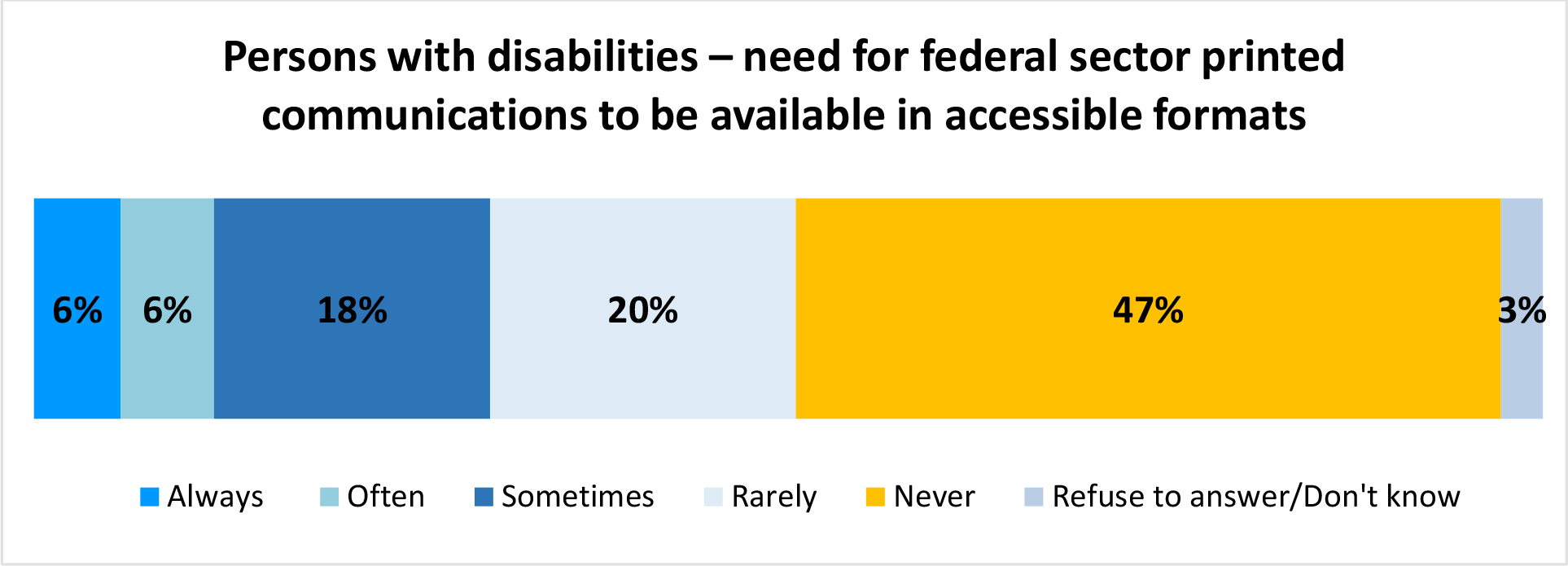
A horizontal bar chart titled, Persons with disabilities – need for federal sector printed communications to be available in accessible formats
The values are as follows. Always, 6 percent. Often, 6 percent. Sometimes, 18 percent. Rarely, 20 percent. Never, 47 percent. Refuse to answer forward slash Don’t know, 3 percent.
When comparing responses based on disability type, those more likely to “always” require accessible formats tended to have a seeing, language / communication, speech, or memory disability.
Telephone respondents who “always”, “often”, or “sometimes” required the need for accessible formats were asked to describe which accessible formats were needed. The most common types of accessible formats needed were plain language (48%), large print (37%), audio version (18%), e-books (18%), text to speech compatibility (15%), and closed captioning (15%).
Figure 73: Persons with disabilities – need for various types of accessible formats
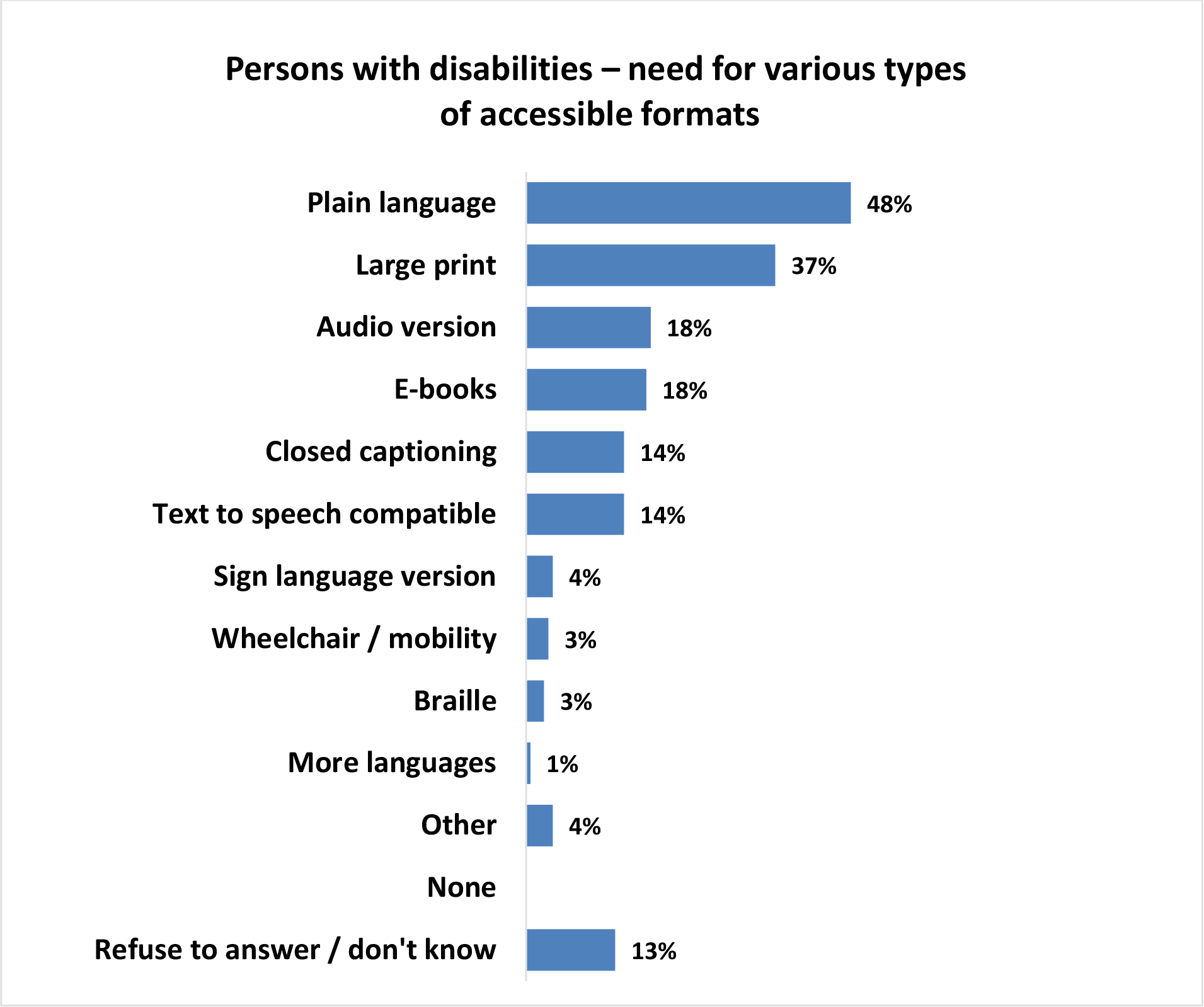
A horizontal bar chart titled, Persons with disabilities – need for various types of accessible formats
The values are as follows. Large print, 37 percent. Plain language, 48 percent. Text to speech compatible, 14 percent. Audio version, 18 percent. Closed captioning, 14 percent. E-books, 18 percent. Sign language version, 4 percent. Braille, 3 percent. More languages, 1 percent. Wheelchair forward slash mobility, 3 percent. Other, 4 percent. None, null. Refuse to answer forward slash don’t know, 13 percent.
Barriers related to the built environment (PWD)
The qualitative research findings suggested that physical spaces could often present barriers that limited one’s ability to access or navigate environments. In terms of the built environment, over the past two years those with disabilities “always” or “often” experienced barriers that limited their ability to move in and around at the following types of places:
Public spaces, such as sidewalks and parks (20%),
Small and independent local stores or shops (20%),
Friends or other people’s house they visited (18%),
Large retail stores and chain stores (17%),
Shopping centres (17%),
Medical offices including walk-in clinics, hospitals, etc. (17%),
Restaurants (17%),
Public buildings, such as libraries, community buildings, city hall, etc. (13%),
Movie theatres (13%),
Government buildings, such as Service Canada centres, etc. (12%), or
Place of work (8%).
When comparing subgroups, the following trends emerged:
Respondents living in British Columbia were more likely to “always” experience barriers when accessing Government buildings, public buildings, their place of work, and restaurants.
Those living in Atlantic Canada more commonly “always” experienced barriers when accessing small and independent stores, movie theatres, shopping centres, public spaces, and friends or other people’s homes.
Respondents with a high school education more commonly “always” experienced built environment barriers across all types of locations compared to those with college or university education.
Men were more likely to report “never” having experienced these types of barriers compared to women.
Relevant subgroup findings based on disability type include the following:
Barriers to accessing public spaces were experienced “always” to a greater extent among those with a speech, seeing, learning, or developmental disability.
Barriers to accessing small and independent local stores tended to be experienced “always” to a greater extent among those with a speech, seeing, mobility, developmental, or dexterity disability.
Barriers to accessing friends or other peoples’ houses were more likely to “always” be experienced by those with a speech, mobility, dexterity, flexibility, or pain disability.
Barriers to accessing large retail or chain stores were more likely to “always” be experienced by those with a seeing, language / communication, or speech, disability.
Barriers to accessing shopping centres were more likely to “always” be experienced by those with a seeing or developmental disability.
Barriers to accessing medical offices were more likely to “always” be experienced by those with a seeing disability.
Barriers to accessing public buildings were more likely to “always” be experienced by those with a seeing or speech disability.
Barriers to accessing movie theatres were more likely to “always” be experienced by those with a seeing, speech, pain, mobility, memory, or communication disability.
Barriers to accessing Government buildings were more likely to “always” be experienced by those with a seeing or speech disability.
Barriers to accessing their place of work were more likely to “always” be experienced by those with a learning or developmental disability.
Figure 74: Persons with disabilities – barriers encountered related to the built environment
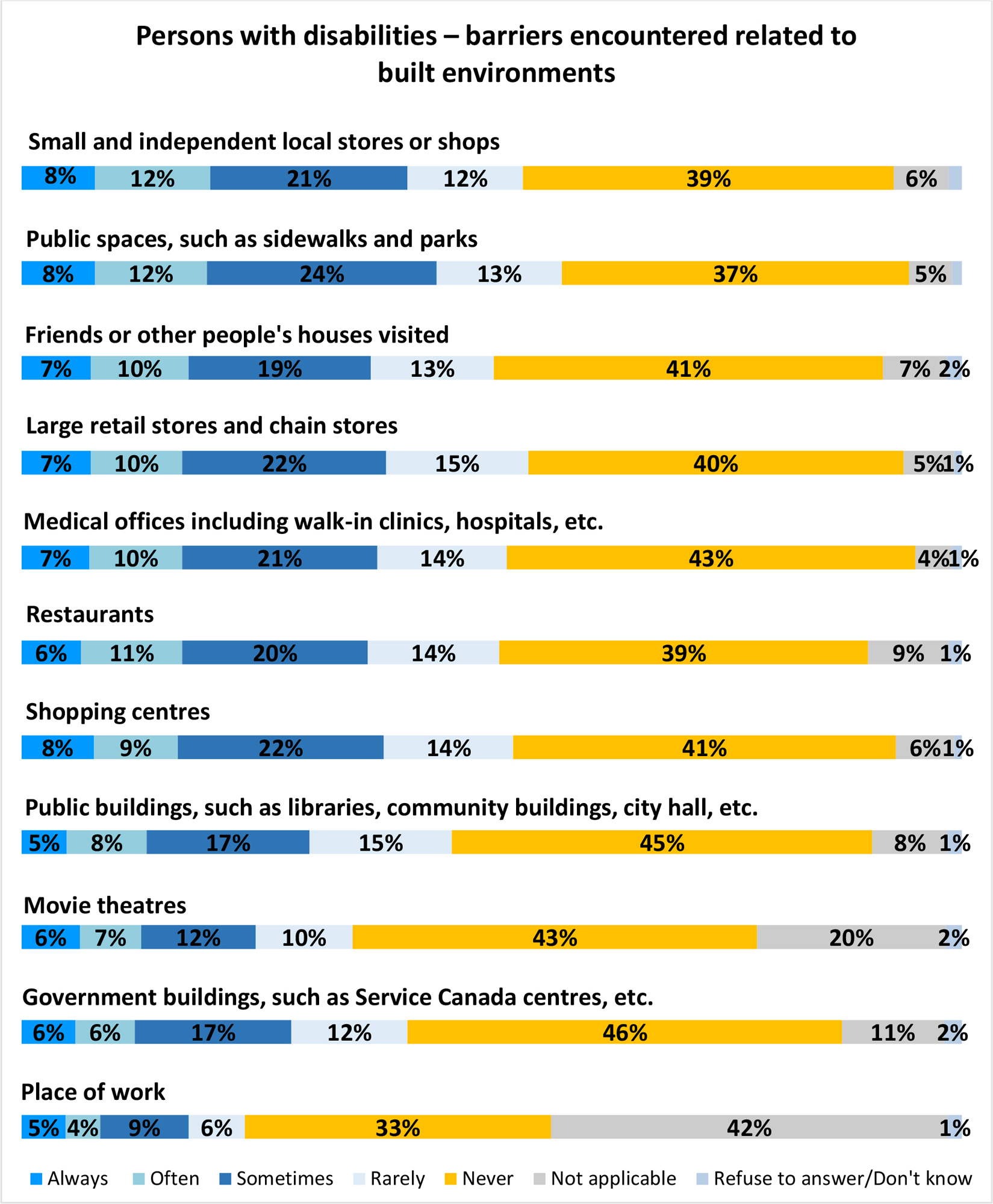
A horizontal bar chart titled, Persons with disabilities – barriers encountered related to built environments
The values are as follows.
Small and independent local stores or shops. Always, 8 percent. Often, 12 percent. Sometimes, 21 percent. Rarely, 12 percent. Never, 39 percent. Not applicable, 6 percent. Refuse to answer forward slash Don’t know, 2percent.
Public spaces, such as sidewalks and parks. Always, 8 percent. Often, 12 percent. Sometimes, 24 percent. Rarely, 13 percent. Never, 37 percent. Not applicable, 5 percent. Refuse to answer forward slash Don’t know, 2 percent.
Friends or other people’s houses visited. Always, 7 percent. Often, 10 percent. Sometimes, 19 percent. Rarely, 13 percent. Never, 41 percent. Not applicable, 7 percent. Refuse to answer forward slash Don’t know, 2 percent.
Large retail stores and chain stores. Always, 7 percent. Often, 10 percent. Sometimes, 22 percent. Rarely, 15 percent. Never, 40 percent. Not applicable, 5 percent. Refuse to answer forward slash Don’t know, 1 percent.
Medical offices including walk-in clinics, hospitals, etc. Always, 7 percent. Often, 10 percent. Sometimes, 21 percent. Rarely, 14 percent. Never, 43 percent. Not applicable, 4 percent. Refuse to answer forward slash Don’t know, 1 percent.
Restaurants. Always, 6 percent. Often, 11 percent. Sometimes, 20 percent. Rarely, 14 percent. Never, 39 percent. Not applicable, 9 percent. Refuse to answer forward slash Don’t know, 1 percent.
Shopping centres. Always, 8 percent. Often, 9 percent. Sometimes, 22 percent. Rarely, 14 percent. Never, 41 percent. Not applicable, 6 percent. Refuse to answer forward slash Don’t know, 1 percent.
Public buildings, such as libraries, community buildings, city hall, etc. Always, 5 percent. Often, 8 percent. Sometimes, 17 percent. Rarely, 15 percent. Never, 45 percent. Not applicable, 8 percent. Refuse to answer forward slash Don’t know, 1 percent.
Movie theatres. Always, 6 percent. Often, 7 percent. Sometimes, 12 percent. Rarely, 10 percent. Never, 43 percent. Not applicable, 20 percent. Refuse to answer forward slash Don’t know, 2 percent.
Government buildings, such as Service Canada centres, etc. Always, 6 percent. Often, 6 percent. Sometimes, 17 percent. Rarely, 12 percent. Never, 46 percent. Not applicable, 11 percent. Refuse to answer forward slash Don’t know, 2 percent.
Place of work. Always, 5 percent. Often, 4 percent. Sometimes, 9 percent. Rarely, 6 percent. Never, 33 percent. Not applicable, 42 percent. Refuse to answer forward slash Don’t know, 1 percent.
Respondent profile
A variety of questions were asked to study participants to obtain information about their demographic and socio-economic profile. This information allowed the research team to not only understand their profile, but also to weigh (as needed) the data and ensure results are representative of the population. The incidence of individuals who refused to provide a specific type of information is not shown to simplify the presentation of results.
Figure 75: Respondent profile
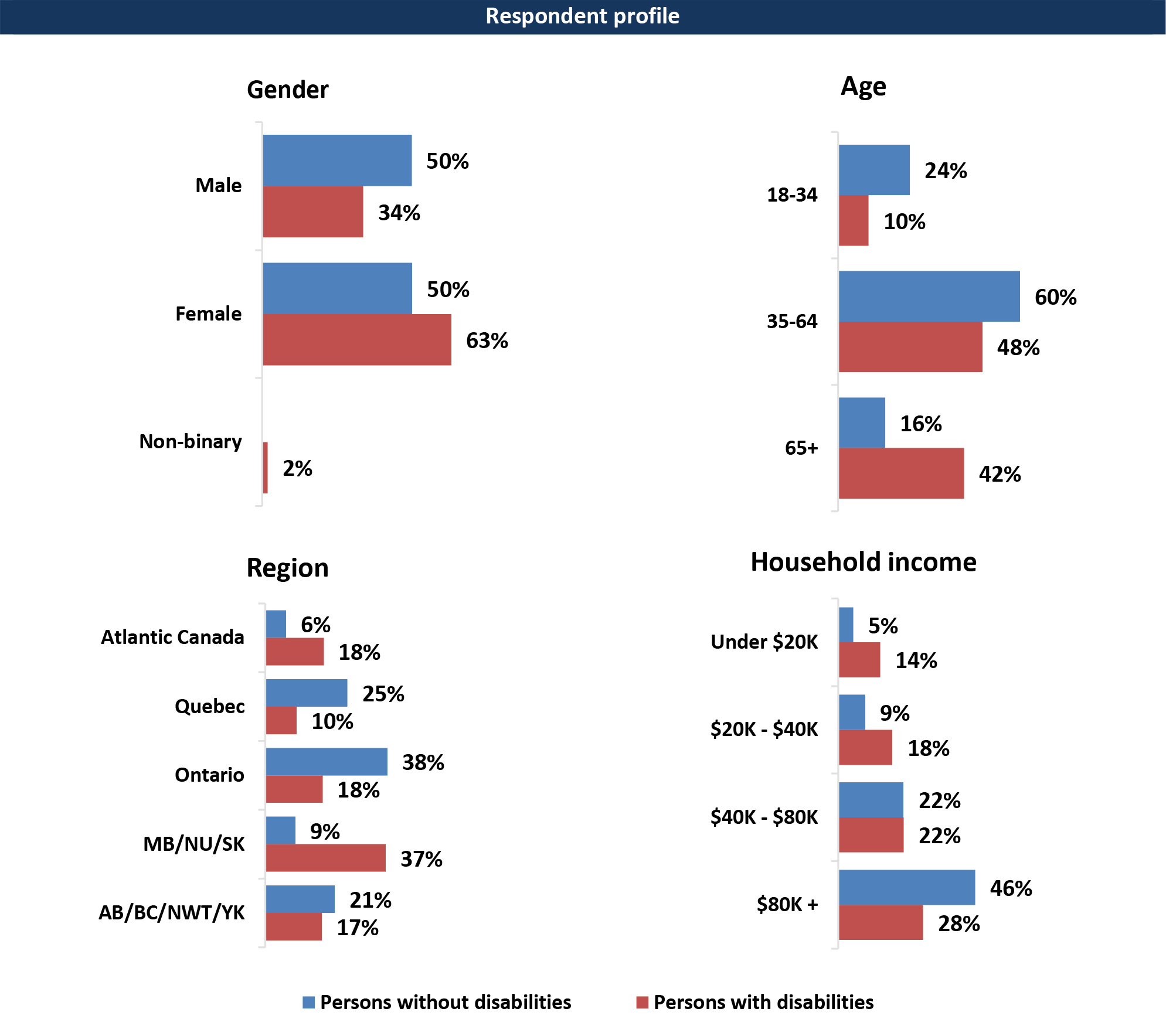
Four horizontal bar chart of Gender, Age, Region, and Household income
Gender. Male. Persons without disabilities, 50 percent. Persons with disabilities, 34 percent. Female. Persons without disabilities, 50 percent. Persons with disabilities, 63 percent. Non-binary. Persons with disabilities, 2 percent.
Age. 18 to 34. Persons without disabilities, 24 percent. Persons with disabilities, 10 percent. 35 to 64. Persons without disabilities, 60 percent. Persons with disabilities, 48 percent. 65. Persons without disabilities, 16 percent. Persons with disabilities, 42 percent.
Region. Atlantic Canada. Persons without disabilities, 6 percent. Persons with disabilities, 18 percent. Quebec. Persons without disabilities, 10 percent. Persons with disabilities, 38 percent. Ontario. Persons without disabilities, 38 percent. Persons with disabilities, 18 percent. M B forward slash N U forward slash S K. Persons without disabilities, 9 percent. Persons with disabilities, 37 percent. A B forward slash B C forward slash N W T forward slash Y K. Persons without disabilities, 21 percent. Persons with disabilities, 17 percent.
Household income. Under 20k dollars. Persons without disabilities, 5 percent. Persons with disabilities, 14 percent. 20k dollars to 40k dollars. Persons without disabilities, 9 percent. Persons with disabilities, 18 percent. 40k dollars to 80k dollars. Persons without disabilities, 22 percent. Persons with disabilities, 22 percent. 80k dollars plus. Persons without disabilities, 46 percent. Persons with disabilities, 28 percent.
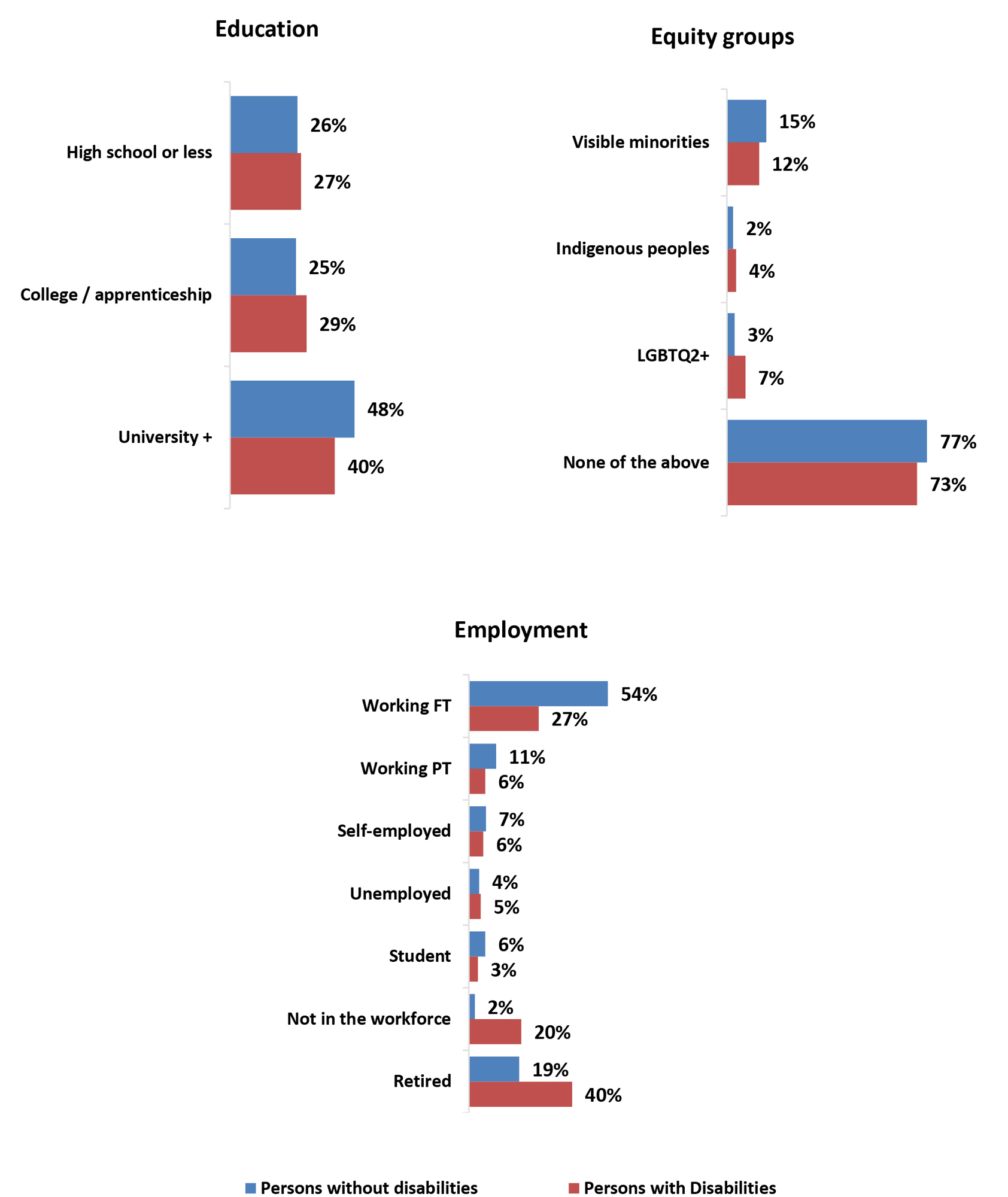
Three horizontal bar chart of Education Equity groups, and Employment
Education. High school or less. Persons without disabilities, 26 percent. Persons with Disabilities, 27 percent. College forward slash apprenticeship. Persons without disabilities, 25 percent. Persons with Disabilities, 29 percent. University plus. Persons without disabilities, 48 percent. Persons with Disabilities, 40 percent.
Equity groups. Visible minorities. Persons without disabilities, 15 percent. Persons with Disabilities, 12 percent. Indigenous peoples. Persons without disabilities, 2 percent. Persons with Disabilities, 4 percent. L G B T Q 2 plus. Persons without disabilities, 3 percent. Persons with Disabilities, 7 percent. None of the above. Persons without disabilities, 77 percent. Persons with Disabilities, 73 percent.
Employment. Working F T. Persons without disabilities, 54 percent. Persons with Disabilities, 27 percent. Working P T. Persons without disabilities, 11 percent. Persons with Disabilities, 6 percent. Self-employed. Persons without disabilities, 7 percent. Persons with Disabilities, 6 percent. Unemployed. Persons without disabilities, 4 percent. Persons with Disabilities, 5 percent. Student. Persons without disabilities, 6 percent. Persons with Disabilities, 3 percent. Not in the workforce. Persons without disabilities, 2 percent. Persons with Disabilities, 20percent. Retired. Persons without disabilities, 19 percent. Persons with Disabilities, 40 percent.
Detailed focus group and depth interview results
General discussion regarding accessibility
The focus groups and interviews began with a brief discussion regarding terminology related to accessibility. Participants were asked to explain in their own words what comes to mind when they think of “disability”, that something is “accessible” and what they consider a “barrier to accessibility.”
Participants generally viewed a “disability” as something that limits their ability to do something the same way as someone who does not have the same disability. Many stressed that this can just as much be something physical (and typically visible) as it could be something invisible (such as a mental health disability).
“For me, it simply means an individual faces challenges in some aspect of their life that makes it perhaps more difficult for them to function in various tasks or activities, whether it is life, or work, or day to day activities.” – 63, female, Northwest Territories, mobility, flexibility and pain disabilities
“When you say disability, people have pre-conceived notions, so if you don’t look a certain way or you don’t act a certain way, they don’t understand that there is anything you are challenged with.” – 60, female, Ontario, mobility, flexibility, dexterity, pain, learning, memory, and mental health disabilities
Some felt that the word “disability” carried a negative connotation, especially to those who did not identify as having a disability. One explained that their disability is part of their identity and while it has created some challenges, it has also brought some positive aspects to their life.
“I see it as a descriptor… I prefer to call it ‘differently abled’ because I don’t feel that there’s a deficit specifically in terms of disabilities… I know there’s a lot of stigma attached to the word disability.” – 44, female, Ontario, mental, learning and pain disabilities
“In some ways disability creates barriers in my life and in some ways, it creates connections and things that are positive as well. I don’t think of disability as a bad thing.” – 34, Nova Scotia, mobility, dexterity and pain disabilities
When asked about the word “accessibility”, participants generally viewed something as accessible if “everyone” could do it, irrespective of their disability or lack thereof. Some participants used the term “all inclusive” to discuss how things should be designed so that anybody can use it.
“It takes into consideration each person’s challenges” – 18, Ontario, developmental and memory disabilities
“To me it means that there’s provisions being made, or effort and thought put into whatever is being offered so that no one is feeling excluded in any way or struggling in any way.” - 48, female, Ontario, learning disability
An example given was a wheelchair ramp, which could be used by those with physical disabilities who require a wheelchair to get around but can also be simply used by someone who does not possess any physical disabilities. Many participants also gave examples of other areas where something may or may not be accessible to someone with a physical disability. A few brought up how accessibility should consider more than just physical disabilities, and one gave the example of a scent-free zone.
“Barriers will not be in place to any type of disability… whether it be a comprehensive barrier, physical barrier, or even a mental barrier… barriers are not present or if they are, there is ways to deal with these challenges.” – 40, Male, Manitoba, memory and mental health disabilities
Finally, a “barrier to accessibility” was broadly seen as something that gets in the way of a person trying to do something. The barrier might make it more difficult to do something or it might completely impede. Again, many brought up examples of physical barriers that they have experienced or heard of others experiencing, however, a few mentioned how these barriers could also include lack of resources, lack of knowledge, or attitudinal.
“Barriers to accessibility can be physical barriers, they can be attitudinal… just what people’s thoughts are. If someone has the idea that someone with a disability is not as intelligent, that would be an attitudinal barrier.” -– 34, Nova Scotia, mobility, dexterity and pain disabilities
Participants also discussed some examples of barriers they had experienced. Individuals who identified as having a physical disability discussed issues with staircases, heavy doors, door handles, doorways that are not wide enough to accommodate a mobility scooter or wheelchair, and parking lots which have not been properly salted or cleared of snow which makes walking extra challenging and dangerous.
Some also discussed how the area in which they live did not offer good transportation methods such as taxis or busses which they need to access locations including grocery stores, pharmacies, or their doctor’s office. These individuals indicated that they often rely on a family member or friend who can drive them where they need to go.
Some of the solutions that participants proposed to help reduce accessibility barriers that persons with disabilities experience included:
Consult, test and do research with PWDs
Involve PWDs in the decision-making or design process
Adopt universal design principles
Create and/or engage committees in the community that can be consulted regarding accessibility considerations
Require product and built environment designers to spend a day “in the shoes of” someone with a disability – they need to experience the world the way PWDs do. For instance, it was suggested that designers should spend a day in a wheelchair.
Increase education and awareness surrounding disabilities (especially “invisible disabilities”) and how to be accommodating or inclusive
A focus on information and communication technologies
The qualitative research explored the extent to which barriers to accessing information and content online, especially from home, were prevalent among participants. The discussion covered barriers to accessing certain types of websites or content as well as barriers to using specific types of devices from which the Internet can be accessed at home.
Very few participants with mild disabilities encountered barriers when accessing online content or using online features. They were more likely to be encountered by those with moderate to severe disabilities, especially those with visual and/or hand or arm-related physical disabilities. For these individuals, the main issues typically pertained to websites that were not adapted for screen readers, websites that were not designed for easy navigation and/or required many clicks to navigate.
Another issue for some pertained to the colour contrast or lighting used on the website. Some mentioned preferring a dimmer screen or would use applications that convert the screen into “dark mode”, however these applications were not always compatible with certain websites. One mentioned that accessibility for those visually impaired typically only focuses on providing large-print resources, which does not mitigate the specific vision challenges they encounter.
“I find for a lot of vision issues, when it comes to computers, they focus on large print or small print, and there isn’t a whole lot of other options.” – 38, Female, Nova Scotia, seeing, pain disabilities
Some avoided websites with streaming content because they did not all provide sub-titles or closed captioning. Several participants expressed frustration with websites that have many flashy pop-ups or advertisement, or generally have too much visual stimulation including colours and moving images or videos. These types of websites were seen as overwhelming and overstimulating for those who experience sensory overload or have a sensory or visual related disability.
“There isn’t one standard for all websites… You can never know when you are opening a website whether you will be bombarded with lots of different images that are moving around and are mentally loud… The experience of using a website that is too sensory overloading.” – 38, Female, Nova Scotia, seeing, learning, mental health disabilities
One also mentioned having difficulty with websites containing streaming content or any website that automatically played music or videos, as this interfered with the assistive dictation devices needed to access the content.
To help mitigate or eliminate these types of barriers, participants suggested involving PWDs more often at the testing stage when websites are being designed.
Very few believed they encountered barriers using specific types of devices. Some with physical impairments avoided or limited their use of portable devices such as laptops or smartphones and would resort to stands or similar devices to prop up their device instead of holding it in their hands or on their lap. Some also discussed screen sizes and either preferred smaller or larger screens based on their specific circumstances.
Furthermore, very few participants used any assistive devices to help them communicate, work, or access the Internet at home or at work. For many who did use these devices, the technology was either built into the device they were using and as such was generally seen as “affordable”, or the costs were covered by their insurance or in some cases, their workplace. A few did explain that the devices they required are quite expensive. In most cases, participants reported not using any assistive devices simply because they did not require them for their necessary tasks.
Participants were asked to explain any barriers they may have encountered accessing any Canadian government websites, whether federal, provincial/territorial or municipal. Over the past few years, participants could not think of many government websites on which they encountered a barrier. The most common feedback typically pertained to the Canada Revenue Agency website, which was seen as dense and generally difficult to navigate because of the amount of content and the technical language used. A few participants had struggled with the ease of use of vaccine-booking websites. A few also mentioned experiencing some confusion with the content on federal immigration websites, Transportation Canada, or labour-related provincial government websites. One mentioned difficulty using a dictation device to fill out a form on a government website or navigate pages as the website was not compatible with the device. This participant mentioned that this issue seemed to happen after website updates occurred.
“It’s been a little frustrating… When I would dictate into the boxes, it would look like it was typing into the boxes, but it wouldn’t actually recognize it. So, I had to get somebody to help type in things… If the website hasn’t been set up in the right way to be compatible, you’ll have to use a different method which takes a lot longer and is annoying.” – 34, Nova Scotia, mobility, dexterity and pain disabilities
Lastly, the cost of high-speed internet rarely came up organically, however, when specifically probed, some did feel that it was quite expensive, especially those who lived in rural areas or in one of the Territories. Nonetheless, most did not see this as a barrier as they either worked or received social assistance which helped to pay for their internet bill. It is important to note that this research was done using online focus groups – perhaps the cost of high-speed Internet would have been more of an issue if a portion of the qualitative research had been done using other data collection modes.
That said, some did mention that they could see this as a barrier to others on low or fixed income. Several also explained that the internet has become a necessity of living and should be easier and more affordable for everyone to access without having to go out of their way to a public library just to access internet.
A focus on communication other than ICT
Among the focus groups and interviews, participants were also asked to share their experiences with how their disabilities have created barriers in their daily communication with families, friends, co-workers, professionals and service providers, including face-to-face, telephone, online, or written communications.
Communication barriers were very rarely encountered when participants were communicating with friends, family or local businesses and organizations, irrespective of how that communication was happening. Those who required more support indicate that they often rely on a companion to help them, which typically met their needs.
Of the specific communication barriers mentioned, some reported that others do not always understand how the severity of their disability can fluctuate, and they may require more support or patience at some points whereas other times their disability will not impact them as much.
“Disabilities can often wax and wane. They get worse – all of a sudden, you’re in an episode and it gets really hard to explain to somebody else.” – 79, Male, Nova Scotia, hearing and mobility disabilities
Some participants mentioned that they often ask others to repeat themselves in order to help them understand what is being communicated. One participant with a vision-related disability indicated they preferred telephone communication and will avoid in-person communication and video calls as much as possible. Another participant with a communication disorder shared their experiences as they often had difficulty finding the right words at times and have felt like they were not taken seriously or have been discriminated against in instances such as job interviews. Lastly, one participant mentioned frustration with how some individuals have engaged with their support worker instead of talking directly to them.
“When I’m trying to engage with someone, sometimes people end up just engaging with my support worker instead of me… When people don’t talk to me directly, that is a barrier, and some of that is that attitudinal stuff where there is some kind of block there that says I am not as intelligent or can’t speak, or because I’m in a wheelchair there is a lot of assumptions that come with that, and people treat me based on that rather than me as a person.” – 34, Nova Scotia, mobility, dexterity and pain disabilities
Communicating with Government of Canada staff was rarely done and when it occurred, the only main challenge was the wait time when dialing into a call center. Otherwise, participants did not recall having any difficulty accessing programs or services because a given federal government agency or department did not offer adequate accessible formats or accessible forms of communication. One suggestion offered was to have an option to slow down the automated voice recording when calling into government departments or services.
There was some awareness of the term “plain language materials” although very few knew that they could obtain plain language materials from the federal government. Of those aware that plain language materials could be requested, only a couple had taken advantage of this, and it was typically for a work-related purpose rather than personal use.
That said, some felt that all government materials should be provided in plain language by default since many felt that current materials from the federal government were not always easily understood. Some felt that government materials could often be contradictory and unclear, and a few expressed that they have had to call to ask questions if they could not find the answer, they were looking for online. Again, some mentioned tax information or considered CRA website to be particularly confusing due to the nature of the content. At a minimum, the availability of plain language versions should be better advertised. Some also expressed that their preference would be to speak to someone over the phone or in person to have their questions answered.
Finally, when it comes to communicating emergencies to all Canadians, for the most part participants were only aware of the alerts they receive on their mobile devices, when listening to the radio or when they are watching television. This approach was widely appreciated and considered adequate and effective. One participant discussed how individuals with disabilities typically already have their cell phone accessibility settings adapted to their specific needs.
Of the few who had concerns with this approach, some expressed concern for Canadians who do not have a mobile device for financial or other reasons. As well, if the device is out of someone’s reach, they felt that the notification may not be received quickly enough. One participant discussed how they were not able to retrieve an alert shortly after it appeared. They might have heard the alarm but when they wanted to find out more, the alert had disappeared from their notifications, and they could not find out more about it. Lastly, a few felt the alarm was too loud and was anxiety-inducing for those with a sensory-related disability. They would appreciate an option to have a quieter notification on their cell phone that is similar to the intensity of a regular phone call or text alert.
A focus on the built environment
Next, participants were asked to discuss examples of barriers they encounter in the built environment. When considering some of the stores they might visit or some of the products they tend to buy regularly, participants feel they encounter many barriers, many of which are related to their physical disabilities.
The most common barriers encountered by those with physical disabilities included:
Curbs that are too high for wheelchairs, mobility scooters and/or individuals with a physical impairment that limits their ability to go up steps
Lack of ramps or elevators inside or outside buildings
Ramps onto sidewalks only located on the far ends (rather than in the middle or closer to the accessible parking spots) which is inconvenient for some since they must go a further distance with their wheelchair or mobility scooter in order to get onto the sidewalk.
Store entrances, including the lack of or broken handicap door openers, and doors to stores or malls that require one or more step to enter (i.e., no entrance ramp or threshold ramp). A few also felt that some store entrances are too narrow or built on angles that make it either difficult or impossible to enter with a mobility scooter or a wheelchair.
Lack of parking spots reserved for persons with disabilities. Some also expressed frustration with the limitations or eligibility requirements to obtain an accessible parking permit. Additionally, some discussed frustration with people using parking permits when they do not need them (e.g., an individual taking advantage of their spouse’s parking permit even when the spouse with a disability is not present).
Narrow aisles in stores that limit their use of their wheelchair or mobility scooter, especially when boxes of new stock are left out, staff are stocking shelves, or pylons, or other objects are blocking parts of the aisle
Menu boards placed outside of restaurants in the middle of sidewalks, which get in the way of mobility scooters
Lack of seating in malls and stores, which is especially an issue for long checkout lines at grocery stores or waiting rooms
Lack of motorized shopping carts
Walkways, sidewalks and entrances not properly cleared of snow
Shelving that is too high and a general lack of staff to help reach for items that are too high and/or too heavy
The most common barriers encountered by those with visual or sensory-related disabilities included:
Shopping environments that have too many stimuli such as bright or flashing lights, loud music, flashing display screens, loud public announcements, etc.
Poor lighting in stores which can create glare and cause difficulties reading signs or packaging labels
Signage in stores with too small font size or font colour which is difficult to read
When it comes to dealing with federally-regulated businesses, some barriers included the following:
Lack of stepping stool or ramp when deplaning onto tarmac (typically an issue with smaller airplanes)
Snow not cleared in front of mailboxes
Packages that are too large for the mailbox are not delivered to the door and instead need to be picked up from the post office which is an issue for those who cannot drive due to their disability and need to take public transportation or ask someone else for a drive
Inability to book airline tickets over the internet due to disability requirements – instead need to call and speak to an agent which can only be done during business hours
Issues with dictation software for bank e-transfers
Banks sometimes not allowing service workers to speak on their behalf
Mailed parcels sometimes left in front of their apartment door which blocks their door from being opened. Some are also unable to pick up their parcel from the floor due to their physical disability.
Participants living in rural or remote areas indicated that many of these barriers are more common in their region compared to larger cities.
A focus on the built environment and procurement of goods, services, and facilities
Next, the discussion shifted to accessibility regarding the products, services, equipment and facilities that different businesses or organizations need to operate. Participants were asked to consider examples such as tables and chairs, computers, shelving, counters where staff stand behind, ATMs, furniture, offices and more in buildings such as banks, public libraries, etc.
Generally, beyond the barriers that participants outlined when they go shopping or go to other types of buildings in their area, they did not have much to add regarding how well the spaces and equipment of businesses and organizations meet the needs of persons with different types of disabilities.
Some discussed how businesses do not always have the appropriately sized seating to accommodate their needs. For example, some businesses or waiting rooms may only offer one size of chairs which have armrests and are difficult to sit in for those with mobility or flexibility issues. These participants would prefer benches or suggest that businesses provide a few various types of seating to accommodate all. Others mentioned how accessible washrooms sometimes still pose barriers as the toilet seat may be too high or too low for their needs. A suggestion to improve these types of scenarios was to hire individuals who have disabilities to help with the procurement process.
“Hire them as a procurement officer. People with disabilities can work too and will give better input than someone that is ambulatory.” – 61, Female, British Columbia, Seeing, Flexibility, Pain and Mental Health disabilities
Participants did have more to say regarding their current or previous workplace and how well they ensured workspaces and products are designed to be barrier free. Employer performance varied a great deal on this front – some felt that their workplace was very proactive in terms of making sure that workspaces were barrier free. To achieve this, they constantly ask staff how well their workspace is performing and if there is anything that should change. Similarly, some workplaces are quite accommodating when employees request special equipment or indicate a particular need. Some workplaces asked about any required accommodations to work as early as in the job interview. Although not perfect, many of the workplaces that seemed to exercise the best accessibility practices were government workplaces.
On the other hand, many participants also explained that despite their organization’s best intentions “on paper”, that it could be very difficult, and sometimes impossible, to obtain certain accommodations, especially if they were expensive. One participant mentioned having to wait a long period of time before receiving an ergonomic chair they had requested to cope with physical challenges related to their disability.
Many participants with moderate to severe disabilities explained that they have encountered employers who discriminate against persons with disabilities. This discrimination will occur either at the hiring stage, or if the disability surfaces or evolves while employed, the employer will create an environment that eventually sees this person quit. A few explained how they did not reveal their disability to their employer out of concern that they might not be treated the same way, such as facing certain forms of discrimination, including not being provided certain accommodations. Additionally, some felt uncomfortable or feared taking any time off work related to their disability as they believed they may lose their job, something which they could not afford.
Very few were aware if there was any policy in place that included information about purchasing goods, services and facilities that are accessible for persons with disabilities. None had directly participated in their employer’s procurement process beyond providing their feedback when specifically asked about their own workspace. Some felt their business did an okay job when it came to being “reactive” and finding solutions when there was a barrier to accessibility, but they did not take the initiative to create an accessible workplace from the get-go.